Impact of Information Technology on Supply Chain Management
VerifiedAdded on 2023/06/09
|67
|18883
|246
AI Summary
This dissertation explores the impact of information technology on supply chain management, with a case study of M&S UK. It includes a literature review, methodology, findings, discussion, and recommendations.
Contribute Materials
Your contribution can guide someone’s learning journey. Share your
documents today.

MSc International Management
IMA7006 Dissertation
Dissertation Title
(The Impact of Information Technology on
Supply Chain Management A case of M&S
UK)
Table of Contents
Abstract i
Acknowledgement ii
Glossary iii
List of tables iv
List of figures v
IMA7006 Dissertation
Dissertation Title
(The Impact of Information Technology on
Supply Chain Management A case of M&S
UK)
Table of Contents
Abstract i
Acknowledgement ii
Glossary iii
List of tables iv
List of figures v
Secure Best Marks with AI Grader
Need help grading? Try our AI Grader for instant feedback on your assignments.

List of appendices vi
Chapter 1: Introduction 1-p
1.1 Background to research topic p
1.2 Background to research organisation p
1.3 Research rationale p
1.4 Research questions p
1.5 Research aims and objectives p
Chapter 2: Literature review p-p
2.1 Introduction of literature review p
2.2 Main body with heading and sub-headings p
2.3 Conclusion of literature review p
Chapter 3: Methodology p-p
3.1 Research philosophy p
3.2 Research approach p
3.3 Research strategy p
3.4 Research methodology p
3.5 Research instruments/tools p
3.6 Sampling p
3.6 Ethical implications p
Chapter 4: Findings (data presentation) pBHP group,
Chapter 5: Discussion (data interpretation) p
Chapter 6: Conclusion, recommendations and implications for further
research p
7.1 Conclusion p
7.2 Recommendations p
7.3 Implications for further research p
References p
Chapter 1: Introduction 1-p
1.1 Background to research topic p
1.2 Background to research organisation p
1.3 Research rationale p
1.4 Research questions p
1.5 Research aims and objectives p
Chapter 2: Literature review p-p
2.1 Introduction of literature review p
2.2 Main body with heading and sub-headings p
2.3 Conclusion of literature review p
Chapter 3: Methodology p-p
3.1 Research philosophy p
3.2 Research approach p
3.3 Research strategy p
3.4 Research methodology p
3.5 Research instruments/tools p
3.6 Sampling p
3.6 Ethical implications p
Chapter 4: Findings (data presentation) pBHP group,
Chapter 5: Discussion (data interpretation) p
Chapter 6: Conclusion, recommendations and implications for further
research p
7.1 Conclusion p
7.2 Recommendations p
7.3 Implications for further research p
References p

Bibliography p
Word Count p
Appendices p
Word Count p
Appendices p

Abstract
The above research is related with understanding the role of supply chain
management and latest technologies used by the businesses in order to segregate themselves
from others. The current report elaborated regarding the different methods used by the
organisation to manage the supply chain and to acquire success into the businesses. Using
latest technologies, the organisation may develop various edges to manage their business
functions and to acquire prominence into such functions. There are various theories and
principles which are added within the report such as Six sigma theories and different supply
chain management principles which are used within an organisation in order to succeed in the
business functions.
The current research was based on quantitative research methods in which
questionnaire was conducted. Using questionnaire, the researcher has acquired knowledge in
respect of the research topic and this has helped the researcher in acquiring research
objectives in overall manner. The quantitative research methodologies have helped the
researcher in gaining statistical views on the research topic.
The above research is related with understanding the role of supply chain
management and latest technologies used by the businesses in order to segregate themselves
from others. The current report elaborated regarding the different methods used by the
organisation to manage the supply chain and to acquire success into the businesses. Using
latest technologies, the organisation may develop various edges to manage their business
functions and to acquire prominence into such functions. There are various theories and
principles which are added within the report such as Six sigma theories and different supply
chain management principles which are used within an organisation in order to succeed in the
business functions.
The current research was based on quantitative research methods in which
questionnaire was conducted. Using questionnaire, the researcher has acquired knowledge in
respect of the research topic and this has helped the researcher in acquiring research
objectives in overall manner. The quantitative research methodologies have helped the
researcher in gaining statistical views on the research topic.
Secure Best Marks with AI Grader
Need help grading? Try our AI Grader for instant feedback on your assignments.
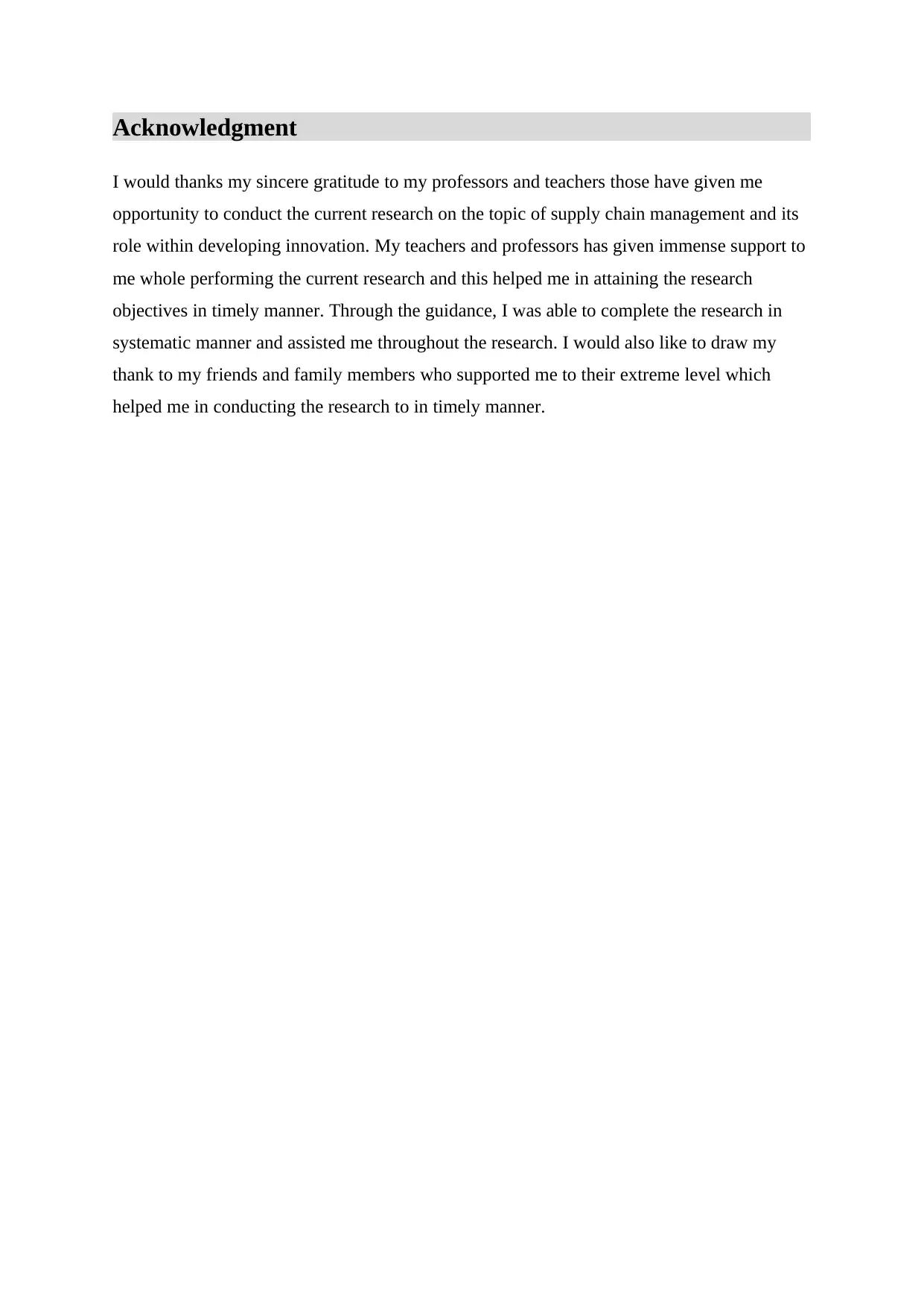
Acknowledgment
I would thanks my sincere gratitude to my professors and teachers those have given me
opportunity to conduct the current research on the topic of supply chain management and its
role within developing innovation. My teachers and professors has given immense support to
me whole performing the current research and this helped me in attaining the research
objectives in timely manner. Through the guidance, I was able to complete the research in
systematic manner and assisted me throughout the research. I would also like to draw my
thank to my friends and family members who supported me to their extreme level which
helped me in conducting the research to in timely manner.
I would thanks my sincere gratitude to my professors and teachers those have given me
opportunity to conduct the current research on the topic of supply chain management and its
role within developing innovation. My teachers and professors has given immense support to
me whole performing the current research and this helped me in attaining the research
objectives in timely manner. Through the guidance, I was able to complete the research in
systematic manner and assisted me throughout the research. I would also like to draw my
thank to my friends and family members who supported me to their extreme level which
helped me in conducting the research to in timely manner.

Glossary
Supply chain management: It is defined as handling of the entire production of goods and
flow of information which are executed within the business starting from the production
process and it ends at reaching out to end users.
Innovation: Innovation is considered as practical implementation of different ideas which
may result into inclusion of amendments in goods and services provided by the organisation.
Supply chain management: It is defined as handling of the entire production of goods and
flow of information which are executed within the business starting from the production
process and it ends at reaching out to end users.
Innovation: Innovation is considered as practical implementation of different ideas which
may result into inclusion of amendments in goods and services provided by the organisation.
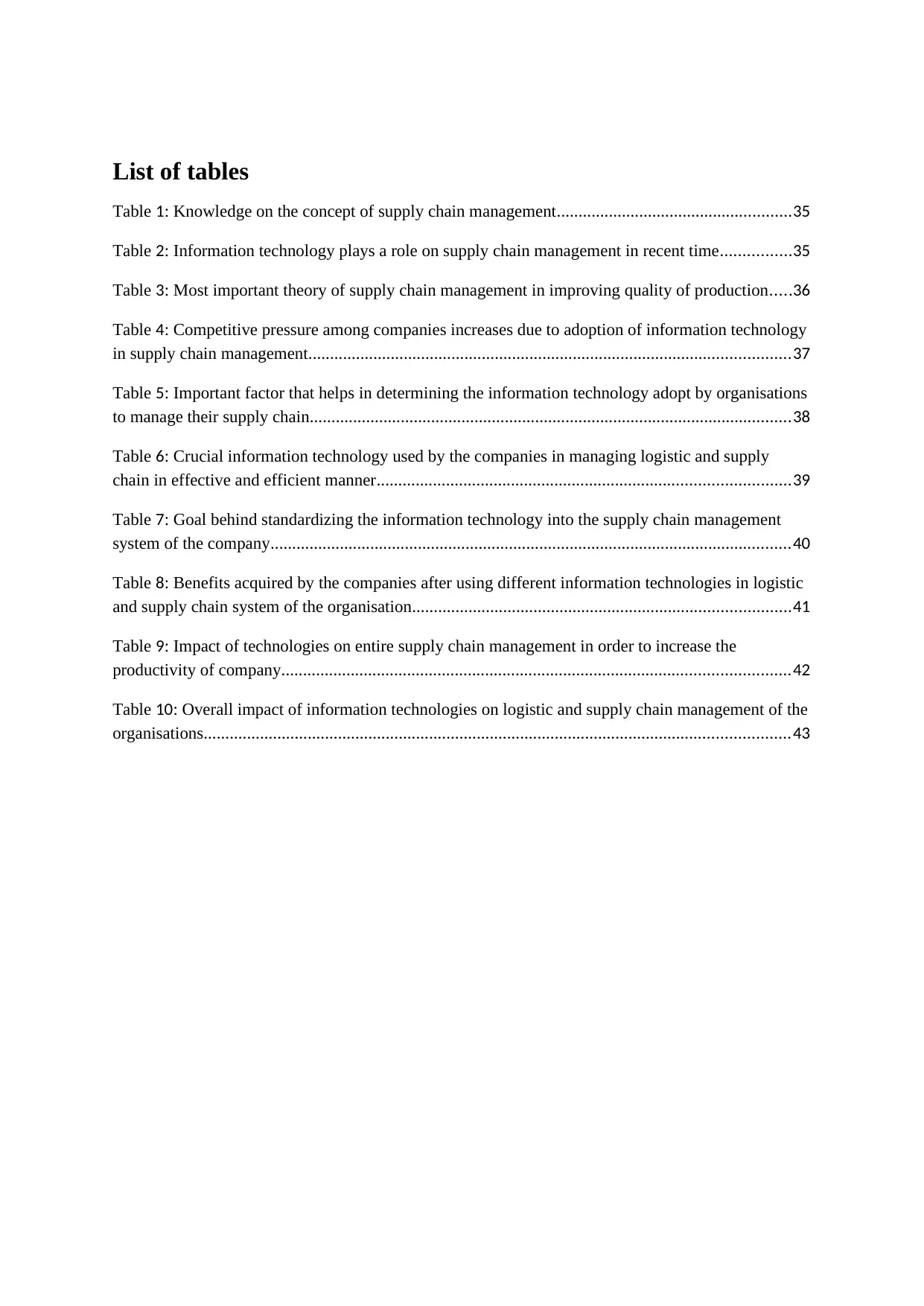
List of tables
Table 1: Knowledge on the concept of supply chain management......................................................35
Table 2: Information technology plays a role on supply chain management in recent time................35
Table 3: Most important theory of supply chain management in improving quality of production.....36
Table 4: Competitive pressure among companies increases due to adoption of information technology
in supply chain management...............................................................................................................37
Table 5: Important factor that helps in determining the information technology adopt by organisations
to manage their supply chain...............................................................................................................38
Table 6: Crucial information technology used by the companies in managing logistic and supply
chain in effective and efficient manner...............................................................................................39
Table 7: Goal behind standardizing the information technology into the supply chain management
system of the company........................................................................................................................40
Table 8: Benefits acquired by the companies after using different information technologies in logistic
and supply chain system of the organisation.......................................................................................41
Table 9: Impact of technologies on entire supply chain management in order to increase the
productivity of company.....................................................................................................................42
Table 10: Overall impact of information technologies on logistic and supply chain management of the
organisations.......................................................................................................................................43
Table 1: Knowledge on the concept of supply chain management......................................................35
Table 2: Information technology plays a role on supply chain management in recent time................35
Table 3: Most important theory of supply chain management in improving quality of production.....36
Table 4: Competitive pressure among companies increases due to adoption of information technology
in supply chain management...............................................................................................................37
Table 5: Important factor that helps in determining the information technology adopt by organisations
to manage their supply chain...............................................................................................................38
Table 6: Crucial information technology used by the companies in managing logistic and supply
chain in effective and efficient manner...............................................................................................39
Table 7: Goal behind standardizing the information technology into the supply chain management
system of the company........................................................................................................................40
Table 8: Benefits acquired by the companies after using different information technologies in logistic
and supply chain system of the organisation.......................................................................................41
Table 9: Impact of technologies on entire supply chain management in order to increase the
productivity of company.....................................................................................................................42
Table 10: Overall impact of information technologies on logistic and supply chain management of the
organisations.......................................................................................................................................43
Paraphrase This Document
Need a fresh take? Get an instant paraphrase of this document with our AI Paraphraser
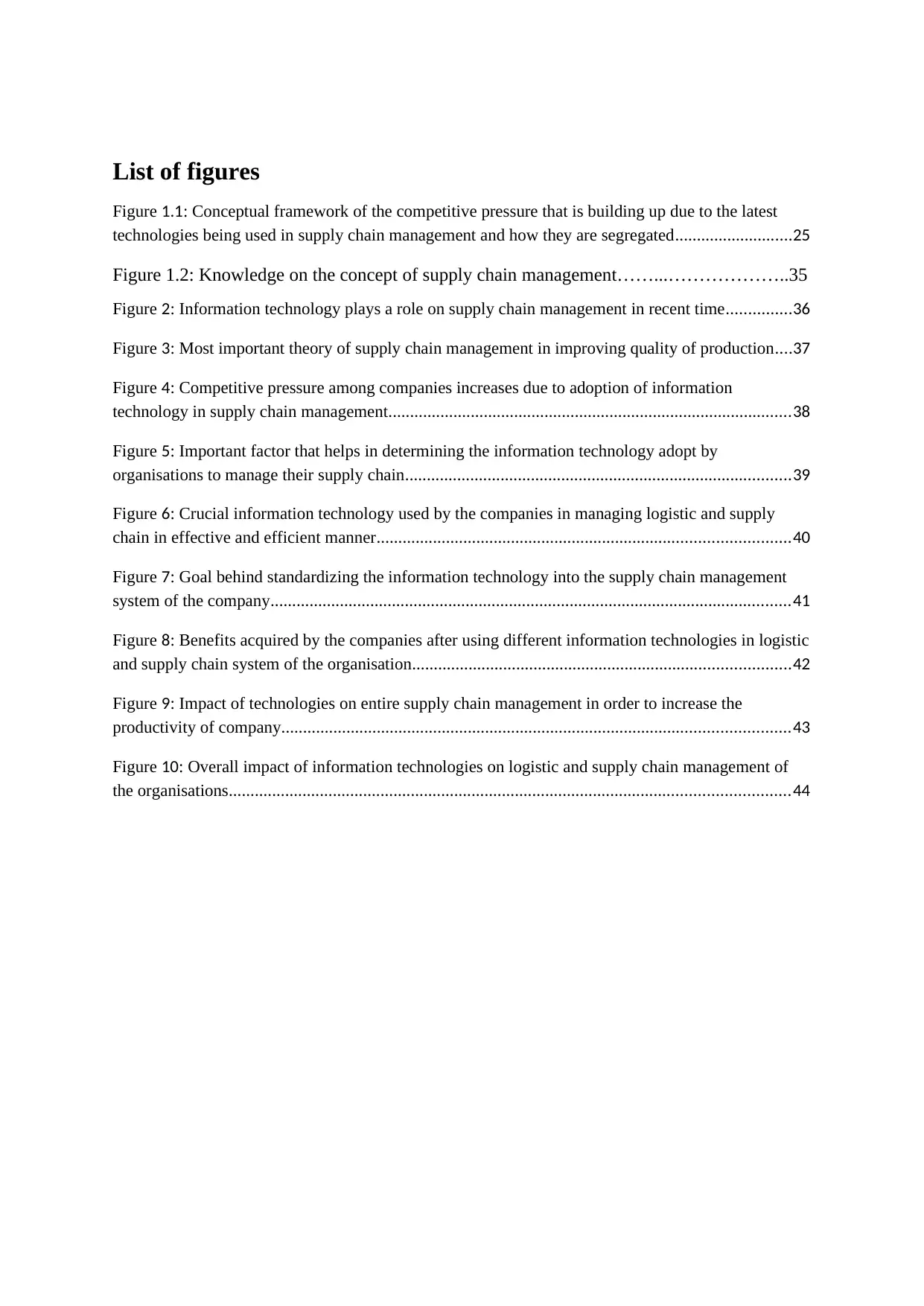
List of figures
Figure 1.1: Conceptual framework of the competitive pressure that is building up due to the latest
technologies being used in supply chain management and how they are segregated...........................25
Figure 1.2: Knowledge on the concept of supply chain management……...………………..35
Figure 2: Information technology plays a role on supply chain management in recent time...............36
Figure 3: Most important theory of supply chain management in improving quality of production....37
Figure 4: Competitive pressure among companies increases due to adoption of information
technology in supply chain management.............................................................................................38
Figure 5: Important factor that helps in determining the information technology adopt by
organisations to manage their supply chain.........................................................................................39
Figure 6: Crucial information technology used by the companies in managing logistic and supply
chain in effective and efficient manner...............................................................................................40
Figure 7: Goal behind standardizing the information technology into the supply chain management
system of the company........................................................................................................................41
Figure 8: Benefits acquired by the companies after using different information technologies in logistic
and supply chain system of the organisation.......................................................................................42
Figure 9: Impact of technologies on entire supply chain management in order to increase the
productivity of company.....................................................................................................................43
Figure 10: Overall impact of information technologies on logistic and supply chain management of
the organisations.................................................................................................................................44
Figure 1.1: Conceptual framework of the competitive pressure that is building up due to the latest
technologies being used in supply chain management and how they are segregated...........................25
Figure 1.2: Knowledge on the concept of supply chain management……...………………..35
Figure 2: Information technology plays a role on supply chain management in recent time...............36
Figure 3: Most important theory of supply chain management in improving quality of production....37
Figure 4: Competitive pressure among companies increases due to adoption of information
technology in supply chain management.............................................................................................38
Figure 5: Important factor that helps in determining the information technology adopt by
organisations to manage their supply chain.........................................................................................39
Figure 6: Crucial information technology used by the companies in managing logistic and supply
chain in effective and efficient manner...............................................................................................40
Figure 7: Goal behind standardizing the information technology into the supply chain management
system of the company........................................................................................................................41
Figure 8: Benefits acquired by the companies after using different information technologies in logistic
and supply chain system of the organisation.......................................................................................42
Figure 9: Impact of technologies on entire supply chain management in order to increase the
productivity of company.....................................................................................................................43
Figure 10: Overall impact of information technologies on logistic and supply chain management of
the organisations.................................................................................................................................44

List of appendices
Appendix 1. A blank copy of questionnaire/interview script………….59-61
Appendix 2. A sample of completed questionnaire/ A sample of Interview
Transcript………………………………………………………………61-63
Appendix 1. A blank copy of questionnaire/interview script………….59-61
Appendix 2. A sample of completed questionnaire/ A sample of Interview
Transcript………………………………………………………………61-63
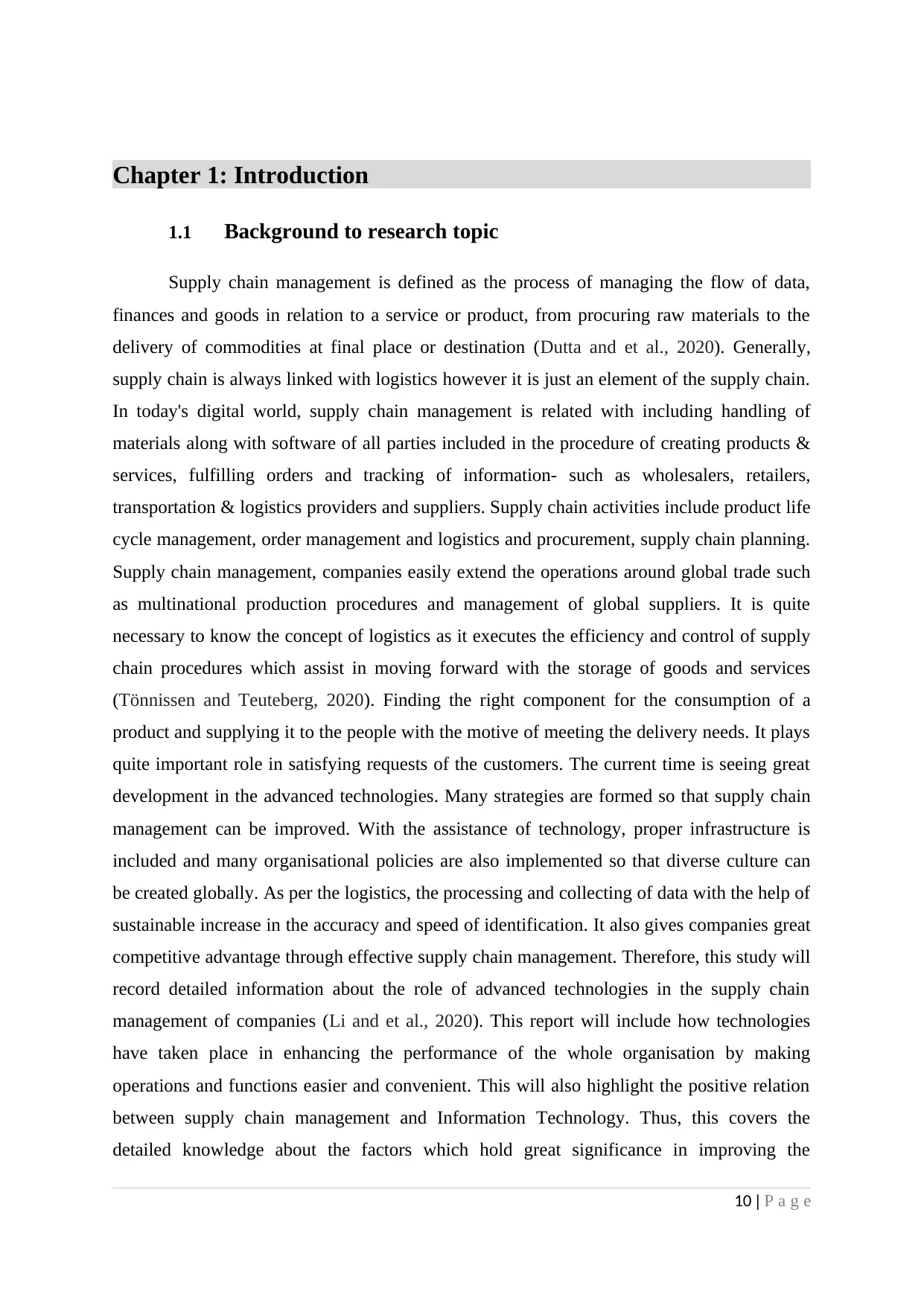
Chapter 1: Introduction
1.1 Background to research topic
Supply chain management is defined as the process of managing the flow of data,
finances and goods in relation to a service or product, from procuring raw materials to the
delivery of commodities at final place or destination (Dutta and et al., 2020). Generally,
supply chain is always linked with logistics however it is just an element of the supply chain.
In today's digital world, supply chain management is related with including handling of
materials along with software of all parties included in the procedure of creating products &
services, fulfilling orders and tracking of information- such as wholesalers, retailers,
transportation & logistics providers and suppliers. Supply chain activities include product life
cycle management, order management and logistics and procurement, supply chain planning.
Supply chain management, companies easily extend the operations around global trade such
as multinational production procedures and management of global suppliers. It is quite
necessary to know the concept of logistics as it executes the efficiency and control of supply
chain procedures which assist in moving forward with the storage of goods and services
(Tönnissen and Teuteberg, 2020). Finding the right component for the consumption of a
product and supplying it to the people with the motive of meeting the delivery needs. It plays
quite important role in satisfying requests of the customers. The current time is seeing great
development in the advanced technologies. Many strategies are formed so that supply chain
management can be improved. With the assistance of technology, proper infrastructure is
included and many organisational policies are also implemented so that diverse culture can
be created globally. As per the logistics, the processing and collecting of data with the help of
sustainable increase in the accuracy and speed of identification. It also gives companies great
competitive advantage through effective supply chain management. Therefore, this study will
record detailed information about the role of advanced technologies in the supply chain
management of companies (Li and et al., 2020). This report will include how technologies
have taken place in enhancing the performance of the whole organisation by making
operations and functions easier and convenient. This will also highlight the positive relation
between supply chain management and Information Technology. Thus, this covers the
detailed knowledge about the factors which hold great significance in improving the
10 | P a g e
1.1 Background to research topic
Supply chain management is defined as the process of managing the flow of data,
finances and goods in relation to a service or product, from procuring raw materials to the
delivery of commodities at final place or destination (Dutta and et al., 2020). Generally,
supply chain is always linked with logistics however it is just an element of the supply chain.
In today's digital world, supply chain management is related with including handling of
materials along with software of all parties included in the procedure of creating products &
services, fulfilling orders and tracking of information- such as wholesalers, retailers,
transportation & logistics providers and suppliers. Supply chain activities include product life
cycle management, order management and logistics and procurement, supply chain planning.
Supply chain management, companies easily extend the operations around global trade such
as multinational production procedures and management of global suppliers. It is quite
necessary to know the concept of logistics as it executes the efficiency and control of supply
chain procedures which assist in moving forward with the storage of goods and services
(Tönnissen and Teuteberg, 2020). Finding the right component for the consumption of a
product and supplying it to the people with the motive of meeting the delivery needs. It plays
quite important role in satisfying requests of the customers. The current time is seeing great
development in the advanced technologies. Many strategies are formed so that supply chain
management can be improved. With the assistance of technology, proper infrastructure is
included and many organisational policies are also implemented so that diverse culture can
be created globally. As per the logistics, the processing and collecting of data with the help of
sustainable increase in the accuracy and speed of identification. It also gives companies great
competitive advantage through effective supply chain management. Therefore, this study will
record detailed information about the role of advanced technologies in the supply chain
management of companies (Li and et al., 2020). This report will include how technologies
have taken place in enhancing the performance of the whole organisation by making
operations and functions easier and convenient. This will also highlight the positive relation
between supply chain management and Information Technology. Thus, this covers the
detailed knowledge about the factors which hold great significance in improving the
10 | P a g e
Secure Best Marks with AI Grader
Need help grading? Try our AI Grader for instant feedback on your assignments.
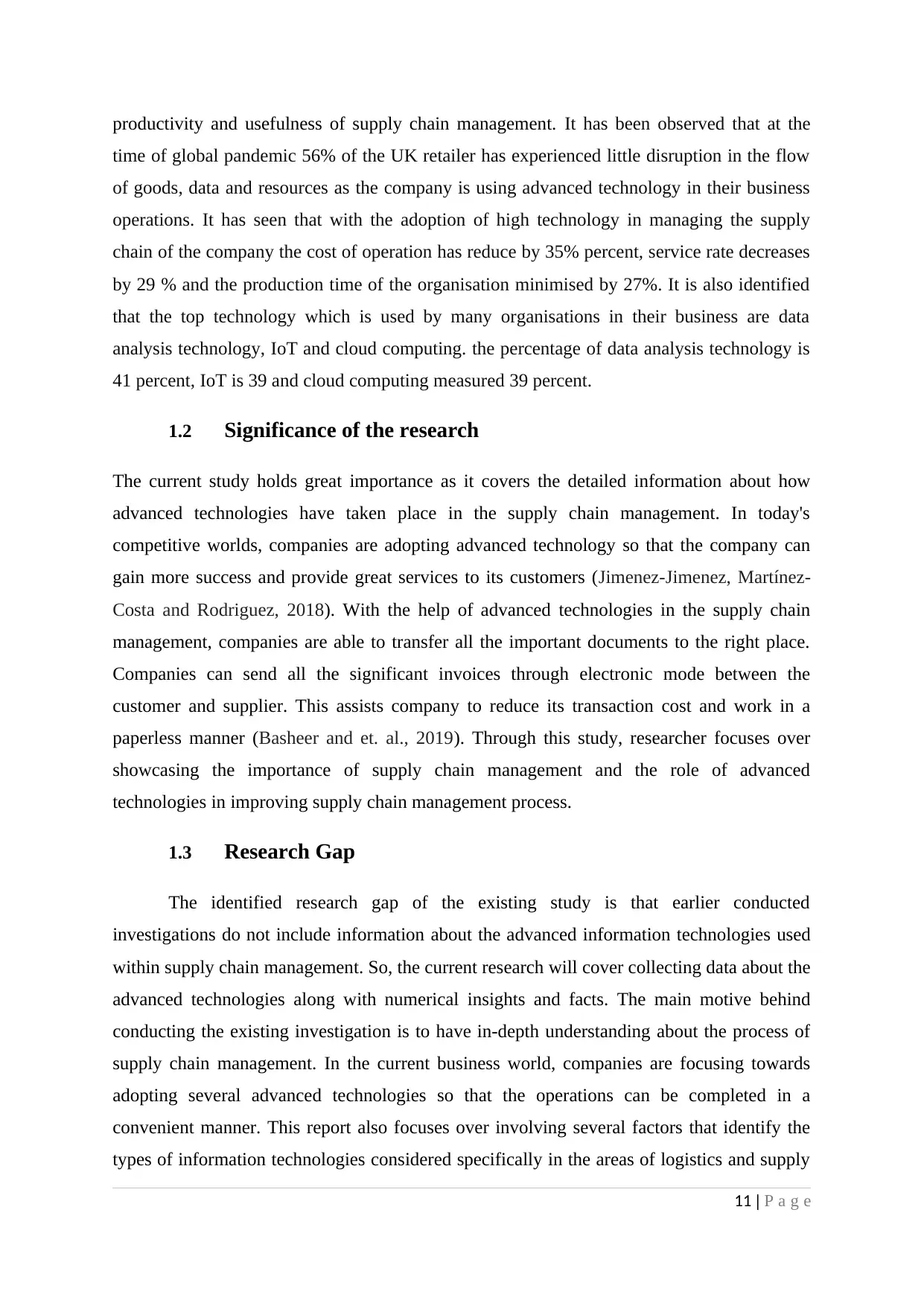
productivity and usefulness of supply chain management. It has been observed that at the
time of global pandemic 56% of the UK retailer has experienced little disruption in the flow
of goods, data and resources as the company is using advanced technology in their business
operations. It has seen that with the adoption of high technology in managing the supply
chain of the company the cost of operation has reduce by 35% percent, service rate decreases
by 29 % and the production time of the organisation minimised by 27%. It is also identified
that the top technology which is used by many organisations in their business are data
analysis technology, IoT and cloud computing. the percentage of data analysis technology is
41 percent, IoT is 39 and cloud computing measured 39 percent.
1.2 Significance of the research
The current study holds great importance as it covers the detailed information about how
advanced technologies have taken place in the supply chain management. In today's
competitive worlds, companies are adopting advanced technology so that the company can
gain more success and provide great services to its customers (Jimenez-Jimenez, Martínez-
Costa and Rodriguez, 2018). With the help of advanced technologies in the supply chain
management, companies are able to transfer all the important documents to the right place.
Companies can send all the significant invoices through electronic mode between the
customer and supplier. This assists company to reduce its transaction cost and work in a
paperless manner (Basheer and et. al., 2019). Through this study, researcher focuses over
showcasing the importance of supply chain management and the role of advanced
technologies in improving supply chain management process.
1.3 Research Gap
The identified research gap of the existing study is that earlier conducted
investigations do not include information about the advanced information technologies used
within supply chain management. So, the current research will cover collecting data about the
advanced technologies along with numerical insights and facts. The main motive behind
conducting the existing investigation is to have in-depth understanding about the process of
supply chain management. In the current business world, companies are focusing towards
adopting several advanced technologies so that the operations can be completed in a
convenient manner. This report also focuses over involving several factors that identify the
types of information technologies considered specifically in the areas of logistics and supply
11 | P a g e
time of global pandemic 56% of the UK retailer has experienced little disruption in the flow
of goods, data and resources as the company is using advanced technology in their business
operations. It has seen that with the adoption of high technology in managing the supply
chain of the company the cost of operation has reduce by 35% percent, service rate decreases
by 29 % and the production time of the organisation minimised by 27%. It is also identified
that the top technology which is used by many organisations in their business are data
analysis technology, IoT and cloud computing. the percentage of data analysis technology is
41 percent, IoT is 39 and cloud computing measured 39 percent.
1.2 Significance of the research
The current study holds great importance as it covers the detailed information about how
advanced technologies have taken place in the supply chain management. In today's
competitive worlds, companies are adopting advanced technology so that the company can
gain more success and provide great services to its customers (Jimenez-Jimenez, Martínez-
Costa and Rodriguez, 2018). With the help of advanced technologies in the supply chain
management, companies are able to transfer all the important documents to the right place.
Companies can send all the significant invoices through electronic mode between the
customer and supplier. This assists company to reduce its transaction cost and work in a
paperless manner (Basheer and et. al., 2019). Through this study, researcher focuses over
showcasing the importance of supply chain management and the role of advanced
technologies in improving supply chain management process.
1.3 Research Gap
The identified research gap of the existing study is that earlier conducted
investigations do not include information about the advanced information technologies used
within supply chain management. So, the current research will cover collecting data about the
advanced technologies along with numerical insights and facts. The main motive behind
conducting the existing investigation is to have in-depth understanding about the process of
supply chain management. In the current business world, companies are focusing towards
adopting several advanced technologies so that the operations can be completed in a
convenient manner. This report also focuses over involving several factors that identify the
types of information technologies considered specifically in the areas of logistics and supply
11 | P a g e

chain management (Ardito and et. al., 2018). It also involves the objectives of standardising
the infrastructure of Information Technology into the system components of supply chain
management. This also includes the in-depth data about the impact of information technology
over supply chain management. With the help of current investigation, researcher will attain
two objectives that are personal and professional objectives. In respect of personal
perspective, researcher will get an opportunity to see things with broader perspective and
become more keen to learn about new concepts (Rejeb, Keogh and Treiblmaier, 2019). By
this study also, investigator will have great information about several research methods used
in the investigations for collecting, evaluating and analysing data. On the other hand, this
research will also be helpful for investigator in terms of professional perspective. Researcher
will learn about the several strategies through which they can improve supply chain
management of their own company. Through this research, investigator will learn about
insights through which they learn about advanced technologies that improve the process of
supply chain management in the organisation.
1.4 Research aim and objectives
Research Aim:
The aim of the current study aims at “To understand the competitive pressure that is
building up due to the latest technologies being used in supply chain management and how
they are segregated.”
Research Objectives:
To evaluate the factors that determine the various information technologies used by
logistics and supply chain management
To examine the goals of standardising the IT infrastructure into the system
components of supply chain management
To discern the impact of information technology act upon supply chain management
and how can one analyse its identification into the modern enhancement of the society
To recommend the ways through which supply chain management can be improved
through adoption of advanced information technologies
12 | P a g e
the infrastructure of Information Technology into the system components of supply chain
management. This also includes the in-depth data about the impact of information technology
over supply chain management. With the help of current investigation, researcher will attain
two objectives that are personal and professional objectives. In respect of personal
perspective, researcher will get an opportunity to see things with broader perspective and
become more keen to learn about new concepts (Rejeb, Keogh and Treiblmaier, 2019). By
this study also, investigator will have great information about several research methods used
in the investigations for collecting, evaluating and analysing data. On the other hand, this
research will also be helpful for investigator in terms of professional perspective. Researcher
will learn about the several strategies through which they can improve supply chain
management of their own company. Through this research, investigator will learn about
insights through which they learn about advanced technologies that improve the process of
supply chain management in the organisation.
1.4 Research aim and objectives
Research Aim:
The aim of the current study aims at “To understand the competitive pressure that is
building up due to the latest technologies being used in supply chain management and how
they are segregated.”
Research Objectives:
To evaluate the factors that determine the various information technologies used by
logistics and supply chain management
To examine the goals of standardising the IT infrastructure into the system
components of supply chain management
To discern the impact of information technology act upon supply chain management
and how can one analyse its identification into the modern enhancement of the society
To recommend the ways through which supply chain management can be improved
through adoption of advanced information technologies
12 | P a g e
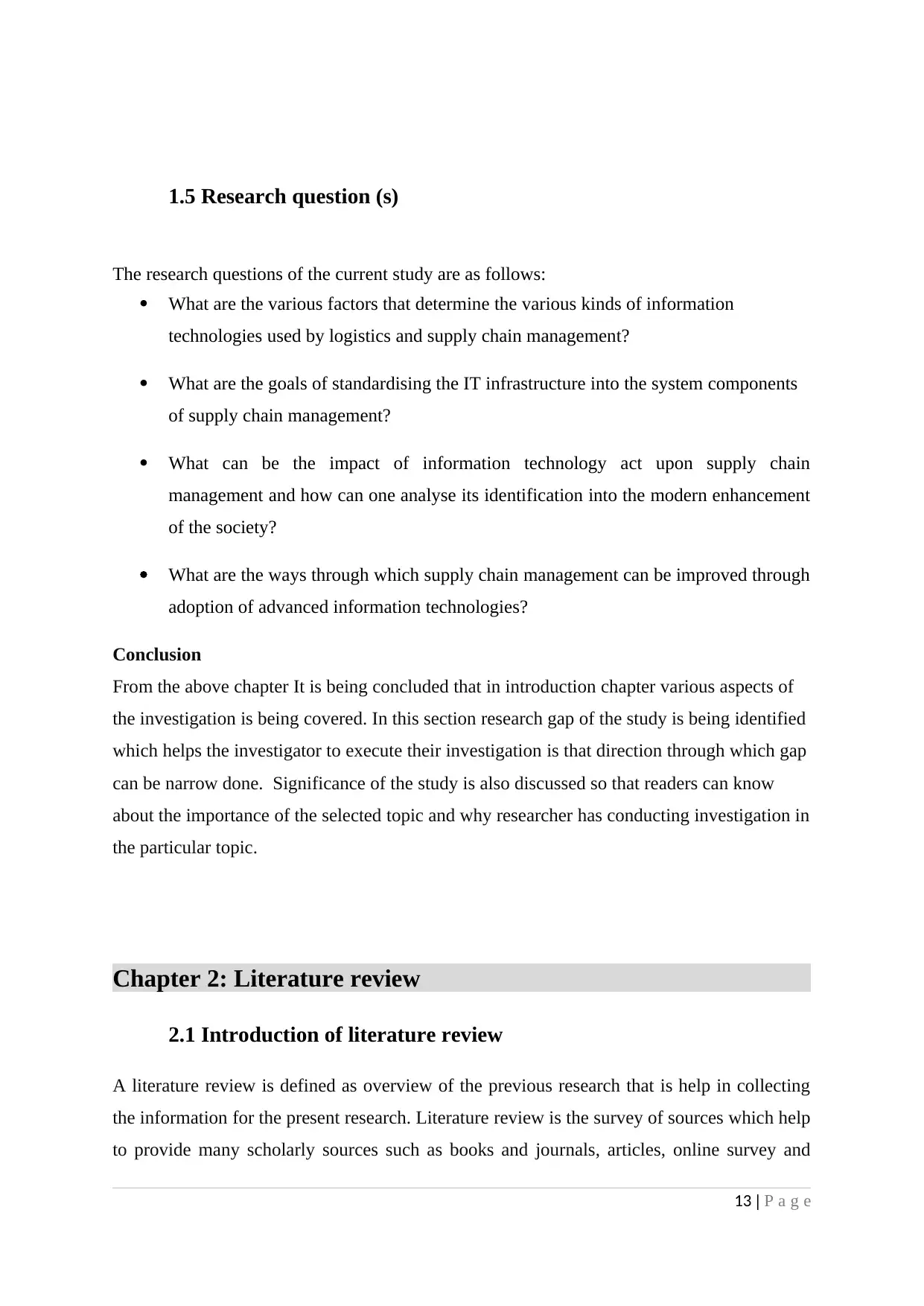
1.5 Research question (s)
The research questions of the current study are as follows:
What are the various factors that determine the various kinds of information
technologies used by logistics and supply chain management?
What are the goals of standardising the IT infrastructure into the system components
of supply chain management?
What can be the impact of information technology act upon supply chain
management and how can one analyse its identification into the modern enhancement
of the society?
What are the ways through which supply chain management can be improved through
adoption of advanced information technologies?
Conclusion
From the above chapter It is being concluded that in introduction chapter various aspects of
the investigation is being covered. In this section research gap of the study is being identified
which helps the investigator to execute their investigation is that direction through which gap
can be narrow done. Significance of the study is also discussed so that readers can know
about the importance of the selected topic and why researcher has conducting investigation in
the particular topic.
Chapter 2: Literature review
2.1 Introduction of literature review
A literature review is defined as overview of the previous research that is help in collecting
the information for the present research. Literature review is the survey of sources which help
to provide many scholarly sources such as books and journals, articles, online survey and
13 | P a g e
The research questions of the current study are as follows:
What are the various factors that determine the various kinds of information
technologies used by logistics and supply chain management?
What are the goals of standardising the IT infrastructure into the system components
of supply chain management?
What can be the impact of information technology act upon supply chain
management and how can one analyse its identification into the modern enhancement
of the society?
What are the ways through which supply chain management can be improved through
adoption of advanced information technologies?
Conclusion
From the above chapter It is being concluded that in introduction chapter various aspects of
the investigation is being covered. In this section research gap of the study is being identified
which helps the investigator to execute their investigation is that direction through which gap
can be narrow done. Significance of the study is also discussed so that readers can know
about the importance of the selected topic and why researcher has conducting investigation in
the particular topic.
Chapter 2: Literature review
2.1 Introduction of literature review
A literature review is defined as overview of the previous research that is help in collecting
the information for the present research. Literature review is the survey of sources which help
to provide many scholarly sources such as books and journals, articles, online survey and
13 | P a g e
Paraphrase This Document
Need a fresh take? Get an instant paraphrase of this document with our AI Paraphraser
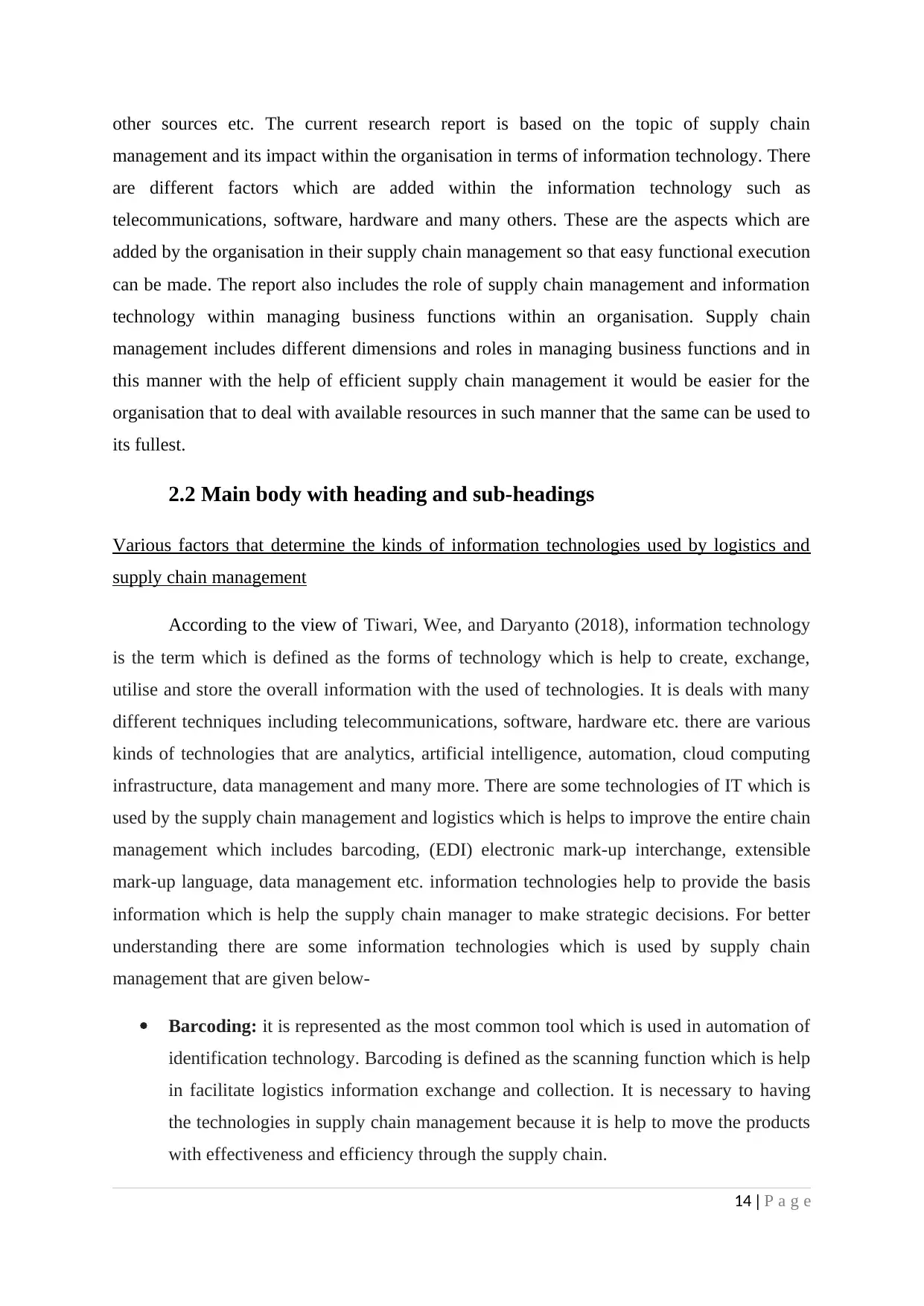
other sources etc. The current research report is based on the topic of supply chain
management and its impact within the organisation in terms of information technology. There
are different factors which are added within the information technology such as
telecommunications, software, hardware and many others. These are the aspects which are
added by the organisation in their supply chain management so that easy functional execution
can be made. The report also includes the role of supply chain management and information
technology within managing business functions within an organisation. Supply chain
management includes different dimensions and roles in managing business functions and in
this manner with the help of efficient supply chain management it would be easier for the
organisation that to deal with available resources in such manner that the same can be used to
its fullest.
2.2 Main body with heading and sub-headings
Various factors that determine the kinds of information technologies used by logistics and
supply chain management
According to the view of Tiwari, Wee, and Daryanto (2018), information technology
is the term which is defined as the forms of technology which is help to create, exchange,
utilise and store the overall information with the used of technologies. It is deals with many
different techniques including telecommunications, software, hardware etc. there are various
kinds of technologies that are analytics, artificial intelligence, automation, cloud computing
infrastructure, data management and many more. There are some technologies of IT which is
used by the supply chain management and logistics which is helps to improve the entire chain
management which includes barcoding, (EDI) electronic mark-up interchange, extensible
mark-up language, data management etc. information technologies help to provide the basis
information which is help the supply chain manager to make strategic decisions. For better
understanding there are some information technologies which is used by supply chain
management that are given below-
Barcoding: it is represented as the most common tool which is used in automation of
identification technology. Barcoding is defined as the scanning function which is help
in facilitate logistics information exchange and collection. It is necessary to having
the technologies in supply chain management because it is help to move the products
with effectiveness and efficiency through the supply chain.
14 | P a g e
management and its impact within the organisation in terms of information technology. There
are different factors which are added within the information technology such as
telecommunications, software, hardware and many others. These are the aspects which are
added by the organisation in their supply chain management so that easy functional execution
can be made. The report also includes the role of supply chain management and information
technology within managing business functions within an organisation. Supply chain
management includes different dimensions and roles in managing business functions and in
this manner with the help of efficient supply chain management it would be easier for the
organisation that to deal with available resources in such manner that the same can be used to
its fullest.
2.2 Main body with heading and sub-headings
Various factors that determine the kinds of information technologies used by logistics and
supply chain management
According to the view of Tiwari, Wee, and Daryanto (2018), information technology
is the term which is defined as the forms of technology which is help to create, exchange,
utilise and store the overall information with the used of technologies. It is deals with many
different techniques including telecommunications, software, hardware etc. there are various
kinds of technologies that are analytics, artificial intelligence, automation, cloud computing
infrastructure, data management and many more. There are some technologies of IT which is
used by the supply chain management and logistics which is helps to improve the entire chain
management which includes barcoding, (EDI) electronic mark-up interchange, extensible
mark-up language, data management etc. information technologies help to provide the basis
information which is help the supply chain manager to make strategic decisions. For better
understanding there are some information technologies which is used by supply chain
management that are given below-
Barcoding: it is represented as the most common tool which is used in automation of
identification technology. Barcoding is defined as the scanning function which is help
in facilitate logistics information exchange and collection. It is necessary to having
the technologies in supply chain management because it is help to move the products
with effectiveness and efficiency through the supply chain.
14 | P a g e
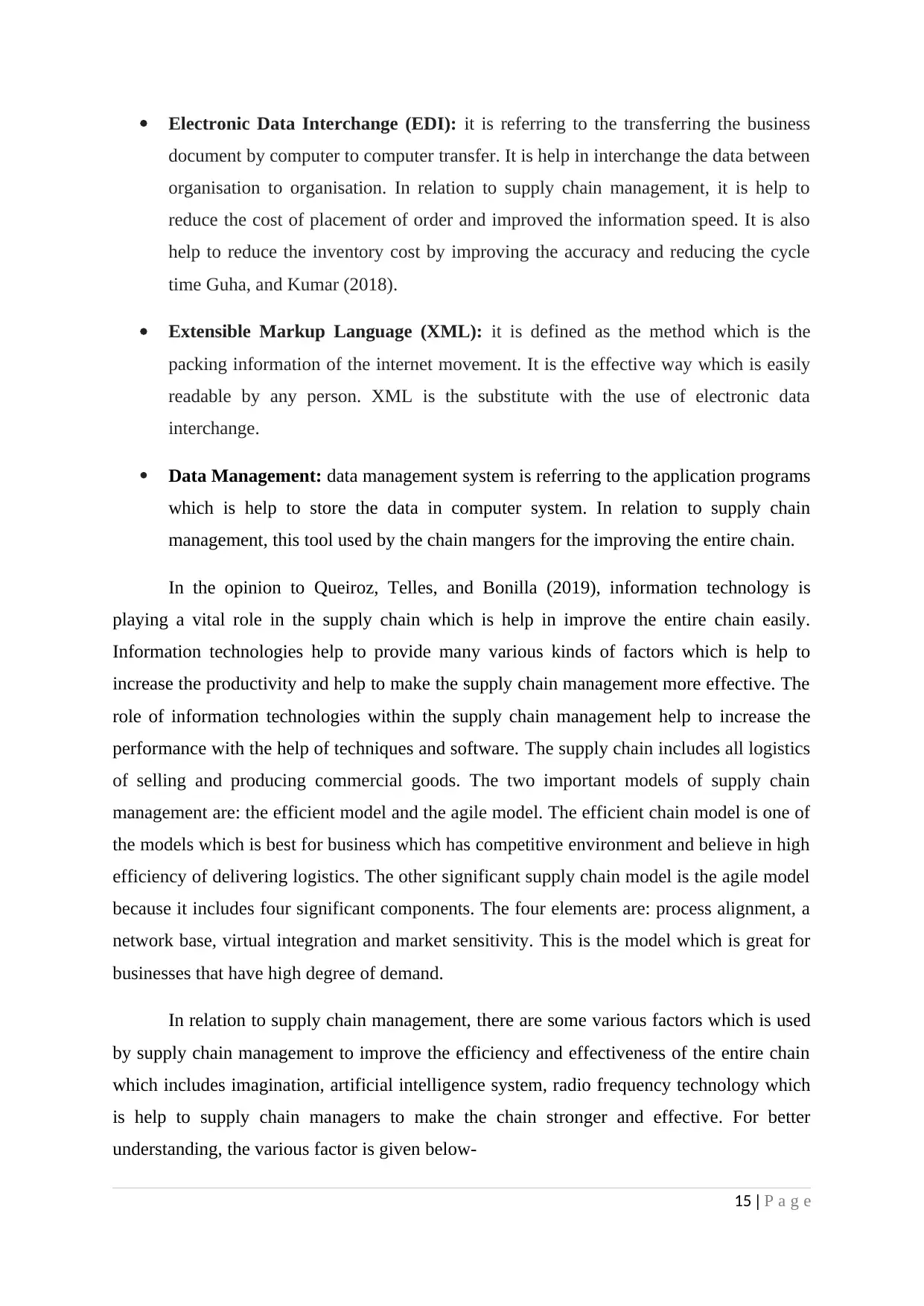
Electronic Data Interchange (EDI): it is referring to the transferring the business
document by computer to computer transfer. It is help in interchange the data between
organisation to organisation. In relation to supply chain management, it is help to
reduce the cost of placement of order and improved the information speed. It is also
help to reduce the inventory cost by improving the accuracy and reducing the cycle
time Guha, and Kumar (2018).
Extensible Markup Language (XML): it is defined as the method which is the
packing information of the internet movement. It is the effective way which is easily
readable by any person. XML is the substitute with the use of electronic data
interchange.
Data Management: data management system is referring to the application programs
which is help to store the data in computer system. In relation to supply chain
management, this tool used by the chain mangers for the improving the entire chain.
In the opinion to Queiroz, Telles, and Bonilla (2019), information technology is
playing a vital role in the supply chain which is help in improve the entire chain easily.
Information technologies help to provide many various kinds of factors which is help to
increase the productivity and help to make the supply chain management more effective. The
role of information technologies within the supply chain management help to increase the
performance with the help of techniques and software. The supply chain includes all logistics
of selling and producing commercial goods. The two important models of supply chain
management are: the efficient model and the agile model. The efficient chain model is one of
the models which is best for business which has competitive environment and believe in high
efficiency of delivering logistics. The other significant supply chain model is the agile model
because it includes four significant components. The four elements are: process alignment, a
network base, virtual integration and market sensitivity. This is the model which is great for
businesses that have high degree of demand.
In relation to supply chain management, there are some various factors which is used
by supply chain management to improve the efficiency and effectiveness of the entire chain
which includes imagination, artificial intelligence system, radio frequency technology which
is help to supply chain managers to make the chain stronger and effective. For better
understanding, the various factor is given below-
15 | P a g e
document by computer to computer transfer. It is help in interchange the data between
organisation to organisation. In relation to supply chain management, it is help to
reduce the cost of placement of order and improved the information speed. It is also
help to reduce the inventory cost by improving the accuracy and reducing the cycle
time Guha, and Kumar (2018).
Extensible Markup Language (XML): it is defined as the method which is the
packing information of the internet movement. It is the effective way which is easily
readable by any person. XML is the substitute with the use of electronic data
interchange.
Data Management: data management system is referring to the application programs
which is help to store the data in computer system. In relation to supply chain
management, this tool used by the chain mangers for the improving the entire chain.
In the opinion to Queiroz, Telles, and Bonilla (2019), information technology is
playing a vital role in the supply chain which is help in improve the entire chain easily.
Information technologies help to provide many various kinds of factors which is help to
increase the productivity and help to make the supply chain management more effective. The
role of information technologies within the supply chain management help to increase the
performance with the help of techniques and software. The supply chain includes all logistics
of selling and producing commercial goods. The two important models of supply chain
management are: the efficient model and the agile model. The efficient chain model is one of
the models which is best for business which has competitive environment and believe in high
efficiency of delivering logistics. The other significant supply chain model is the agile model
because it includes four significant components. The four elements are: process alignment, a
network base, virtual integration and market sensitivity. This is the model which is great for
businesses that have high degree of demand.
In relation to supply chain management, there are some various factors which is used
by supply chain management to improve the efficiency and effectiveness of the entire chain
which includes imagination, artificial intelligence system, radio frequency technology which
is help to supply chain managers to make the chain stronger and effective. For better
understanding, the various factor is given below-
15 | P a g e
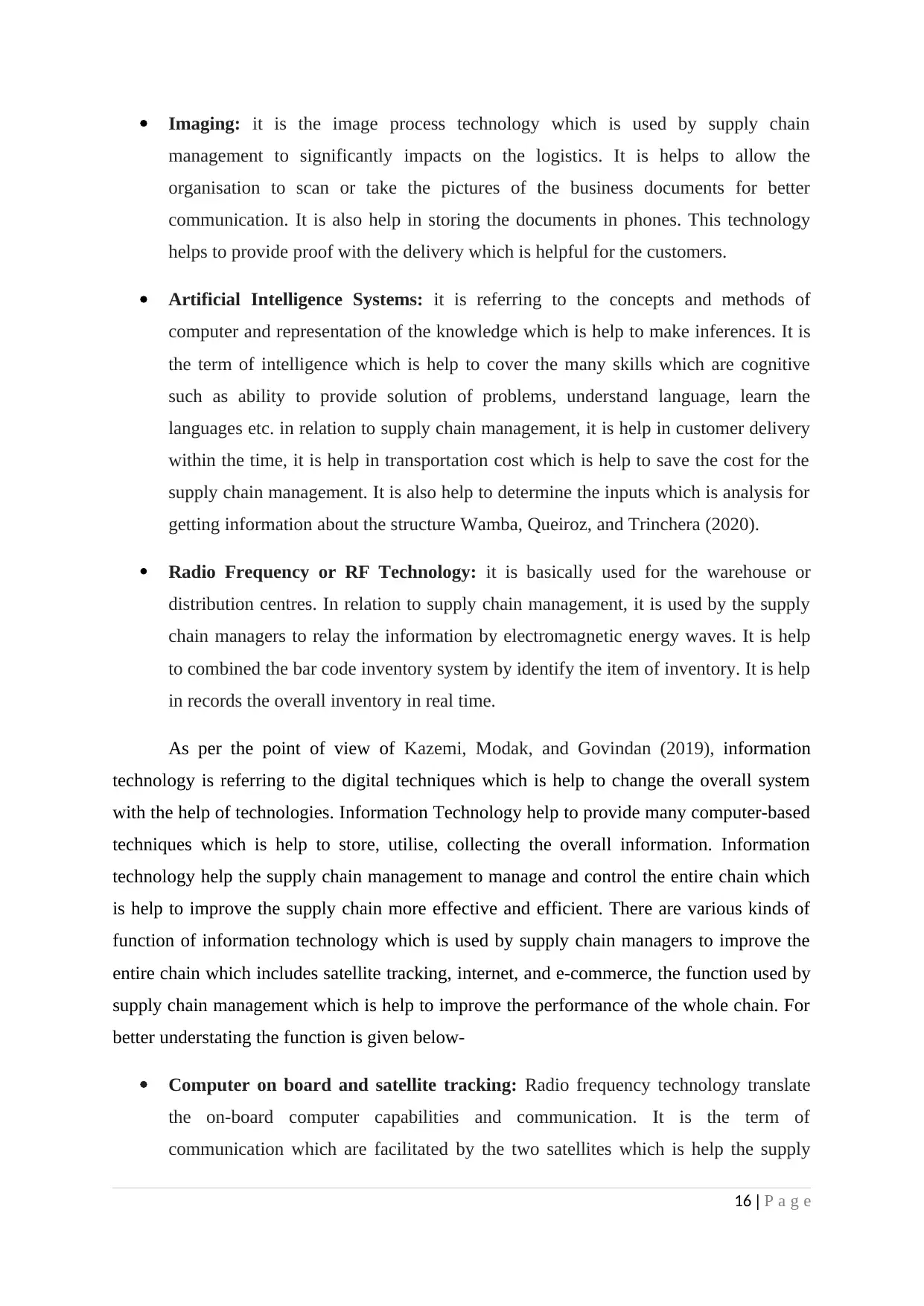
Imaging: it is the image process technology which is used by supply chain
management to significantly impacts on the logistics. It is helps to allow the
organisation to scan or take the pictures of the business documents for better
communication. It is also help in storing the documents in phones. This technology
helps to provide proof with the delivery which is helpful for the customers.
Artificial Intelligence Systems: it is referring to the concepts and methods of
computer and representation of the knowledge which is help to make inferences. It is
the term of intelligence which is help to cover the many skills which are cognitive
such as ability to provide solution of problems, understand language, learn the
languages etc. in relation to supply chain management, it is help in customer delivery
within the time, it is help in transportation cost which is help to save the cost for the
supply chain management. It is also help to determine the inputs which is analysis for
getting information about the structure Wamba, Queiroz, and Trinchera (2020).
Radio Frequency or RF Technology: it is basically used for the warehouse or
distribution centres. In relation to supply chain management, it is used by the supply
chain managers to relay the information by electromagnetic energy waves. It is help
to combined the bar code inventory system by identify the item of inventory. It is help
in records the overall inventory in real time.
As per the point of view of Kazemi, Modak, and Govindan (2019), information
technology is referring to the digital techniques which is help to change the overall system
with the help of technologies. Information Technology help to provide many computer-based
techniques which is help to store, utilise, collecting the overall information. Information
technology help the supply chain management to manage and control the entire chain which
is help to improve the supply chain more effective and efficient. There are various kinds of
function of information technology which is used by supply chain managers to improve the
entire chain which includes satellite tracking, internet, and e-commerce, the function used by
supply chain management which is help to improve the performance of the whole chain. For
better understating the function is given below-
Computer on board and satellite tracking: Radio frequency technology translate
the on-board computer capabilities and communication. It is the term of
communication which are facilitated by the two satellites which is help the supply
16 | P a g e
management to significantly impacts on the logistics. It is helps to allow the
organisation to scan or take the pictures of the business documents for better
communication. It is also help in storing the documents in phones. This technology
helps to provide proof with the delivery which is helpful for the customers.
Artificial Intelligence Systems: it is referring to the concepts and methods of
computer and representation of the knowledge which is help to make inferences. It is
the term of intelligence which is help to cover the many skills which are cognitive
such as ability to provide solution of problems, understand language, learn the
languages etc. in relation to supply chain management, it is help in customer delivery
within the time, it is help in transportation cost which is help to save the cost for the
supply chain management. It is also help to determine the inputs which is analysis for
getting information about the structure Wamba, Queiroz, and Trinchera (2020).
Radio Frequency or RF Technology: it is basically used for the warehouse or
distribution centres. In relation to supply chain management, it is used by the supply
chain managers to relay the information by electromagnetic energy waves. It is help
to combined the bar code inventory system by identify the item of inventory. It is help
in records the overall inventory in real time.
As per the point of view of Kazemi, Modak, and Govindan (2019), information
technology is referring to the digital techniques which is help to change the overall system
with the help of technologies. Information Technology help to provide many computer-based
techniques which is help to store, utilise, collecting the overall information. Information
technology help the supply chain management to manage and control the entire chain which
is help to improve the supply chain more effective and efficient. There are various kinds of
function of information technology which is used by supply chain managers to improve the
entire chain which includes satellite tracking, internet, and e-commerce, the function used by
supply chain management which is help to improve the performance of the whole chain. For
better understating the function is given below-
Computer on board and satellite tracking: Radio frequency technology translate
the on-board computer capabilities and communication. It is the term of
communication which are facilitated by the two satellites which is help the supply
16 | P a g e
Secure Best Marks with AI Grader
Need help grading? Try our AI Grader for instant feedback on your assignments.
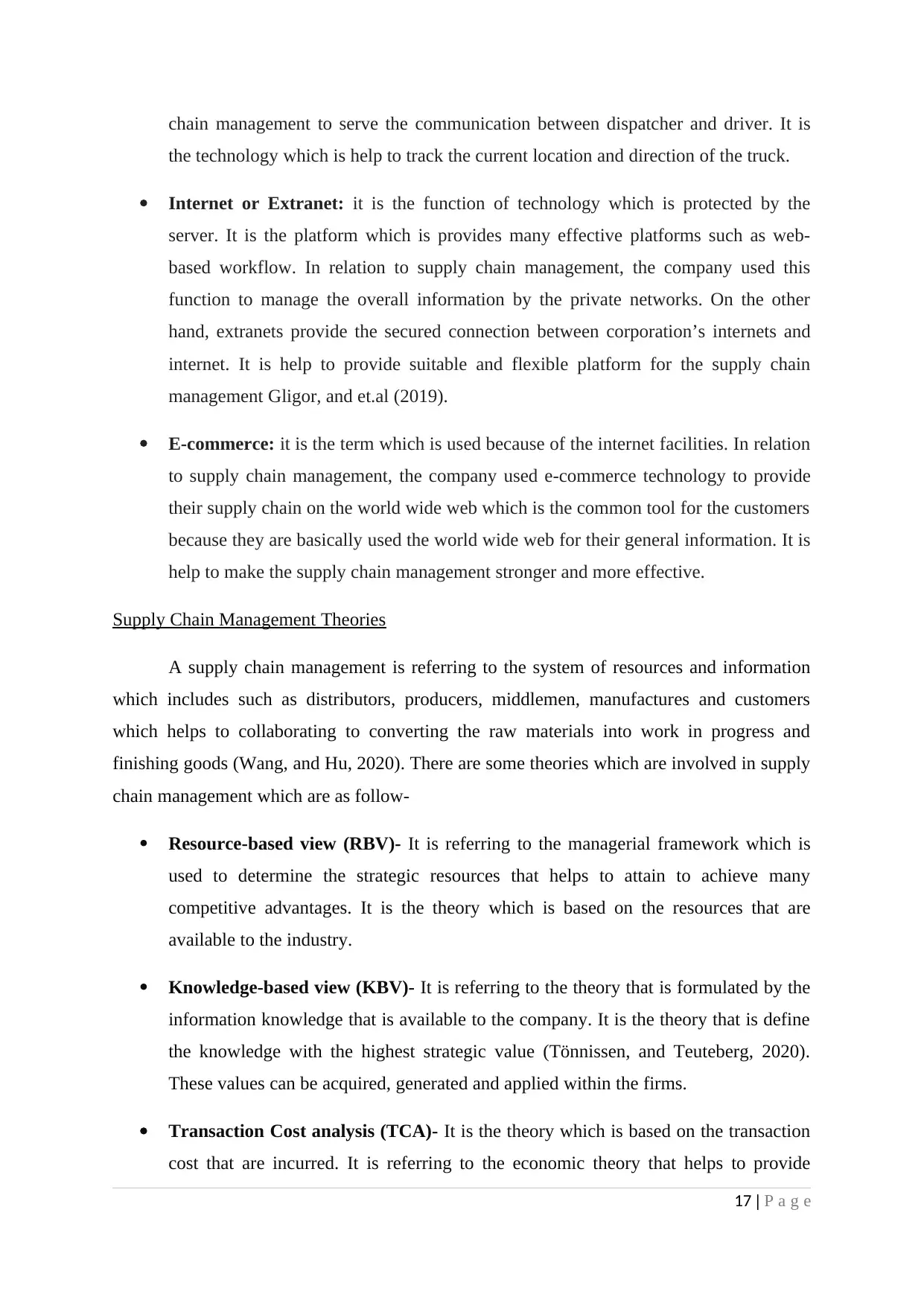
chain management to serve the communication between dispatcher and driver. It is
the technology which is help to track the current location and direction of the truck.
Internet or Extranet: it is the function of technology which is protected by the
server. It is the platform which is provides many effective platforms such as web-
based workflow. In relation to supply chain management, the company used this
function to manage the overall information by the private networks. On the other
hand, extranets provide the secured connection between corporation’s internets and
internet. It is help to provide suitable and flexible platform for the supply chain
management Gligor, and et.al (2019).
E-commerce: it is the term which is used because of the internet facilities. In relation
to supply chain management, the company used e-commerce technology to provide
their supply chain on the world wide web which is the common tool for the customers
because they are basically used the world wide web for their general information. It is
help to make the supply chain management stronger and more effective.
Supply Chain Management Theories
A supply chain management is referring to the system of resources and information
which includes such as distributors, producers, middlemen, manufactures and customers
which helps to collaborating to converting the raw materials into work in progress and
finishing goods (Wang, and Hu, 2020). There are some theories which are involved in supply
chain management which are as follow-
Resource-based view (RBV)- It is referring to the managerial framework which is
used to determine the strategic resources that helps to attain to achieve many
competitive advantages. It is the theory which is based on the resources that are
available to the industry.
Knowledge-based view (KBV)- It is referring to the theory that is formulated by the
information knowledge that is available to the company. It is the theory that is define
the knowledge with the highest strategic value (Tönnissen, and Teuteberg, 2020).
These values can be acquired, generated and applied within the firms.
Transaction Cost analysis (TCA)- It is the theory which is based on the transaction
cost that are incurred. It is referring to the economic theory that helps to provide
17 | P a g e
the technology which is help to track the current location and direction of the truck.
Internet or Extranet: it is the function of technology which is protected by the
server. It is the platform which is provides many effective platforms such as web-
based workflow. In relation to supply chain management, the company used this
function to manage the overall information by the private networks. On the other
hand, extranets provide the secured connection between corporation’s internets and
internet. It is help to provide suitable and flexible platform for the supply chain
management Gligor, and et.al (2019).
E-commerce: it is the term which is used because of the internet facilities. In relation
to supply chain management, the company used e-commerce technology to provide
their supply chain on the world wide web which is the common tool for the customers
because they are basically used the world wide web for their general information. It is
help to make the supply chain management stronger and more effective.
Supply Chain Management Theories
A supply chain management is referring to the system of resources and information
which includes such as distributors, producers, middlemen, manufactures and customers
which helps to collaborating to converting the raw materials into work in progress and
finishing goods (Wang, and Hu, 2020). There are some theories which are involved in supply
chain management which are as follow-
Resource-based view (RBV)- It is referring to the managerial framework which is
used to determine the strategic resources that helps to attain to achieve many
competitive advantages. It is the theory which is based on the resources that are
available to the industry.
Knowledge-based view (KBV)- It is referring to the theory that is formulated by the
information knowledge that is available to the company. It is the theory that is define
the knowledge with the highest strategic value (Tönnissen, and Teuteberg, 2020).
These values can be acquired, generated and applied within the firms.
Transaction Cost analysis (TCA)- It is the theory which is based on the transaction
cost that are incurred. It is referring to the economic theory that helps to provide
17 | P a g e

analytics framework which attain to investigate the governance structure of pledged
bond with the supply chain.
Strategic Choice theory (SCT)- It is defined as the theory which is based and
dependent on the strategies and various decisions that are selected by the management
to take the right decisions for the supply chain management.
Agency theory (AT)- it is the theory that allow to explain the bond between agents
and principles (Burin, Perez-Arostegui, and Llorens-Montes, 2020). It helps to attain
the relevant policies that are adopted to minimise the cost by increasing the revenue
cost.
Institutional Theory (INT)- this theory is also based on the principles and policies
which are under the governed institute. It is helps to offers the important insights to
adopt the practice and tools within supply chain management.
System theory (ST)- it is defined as the theory that is based on the system that handle
the institute’s supplies. It is one of the most dominant theories within the supply chain
management because it is the study to simplifying the organisational structure and
identify its stakeholders.
Network perspective (NP)- it is referring to the concept of critical theory that
provides the explanations and relationships with the all networks that are facilities the
connection and bond between the supply chain management and it’s all levels (Tan,
Gligor, and Ngah, 2022).
Materials logistics Management theory (MLM)- it is referring to the theory that
designs the inventory to ensure the mechanisms which are controlled for all the level
of inventory. It is helps to connect the customer experience and raw materials. It is
helps to integrates all the critical materials-related to subfunctions.
The three vital supply chain management theory which is used by many organisation is
resource based view and system theory.
Resource based view: This is the most common types of theory which is used in many
company to manage their resource which are needed to transfer input into output. Raw
18 | P a g e
bond with the supply chain.
Strategic Choice theory (SCT)- It is defined as the theory which is based and
dependent on the strategies and various decisions that are selected by the management
to take the right decisions for the supply chain management.
Agency theory (AT)- it is the theory that allow to explain the bond between agents
and principles (Burin, Perez-Arostegui, and Llorens-Montes, 2020). It helps to attain
the relevant policies that are adopted to minimise the cost by increasing the revenue
cost.
Institutional Theory (INT)- this theory is also based on the principles and policies
which are under the governed institute. It is helps to offers the important insights to
adopt the practice and tools within supply chain management.
System theory (ST)- it is defined as the theory that is based on the system that handle
the institute’s supplies. It is one of the most dominant theories within the supply chain
management because it is the study to simplifying the organisational structure and
identify its stakeholders.
Network perspective (NP)- it is referring to the concept of critical theory that
provides the explanations and relationships with the all networks that are facilities the
connection and bond between the supply chain management and it’s all levels (Tan,
Gligor, and Ngah, 2022).
Materials logistics Management theory (MLM)- it is referring to the theory that
designs the inventory to ensure the mechanisms which are controlled for all the level
of inventory. It is helps to connect the customer experience and raw materials. It is
helps to integrates all the critical materials-related to subfunctions.
The three vital supply chain management theory which is used by many organisation is
resource based view and system theory.
Resource based view: This is the most common types of theory which is used in many
company to manage their resource which are needed to transfer input into output. Raw
18 | P a g e
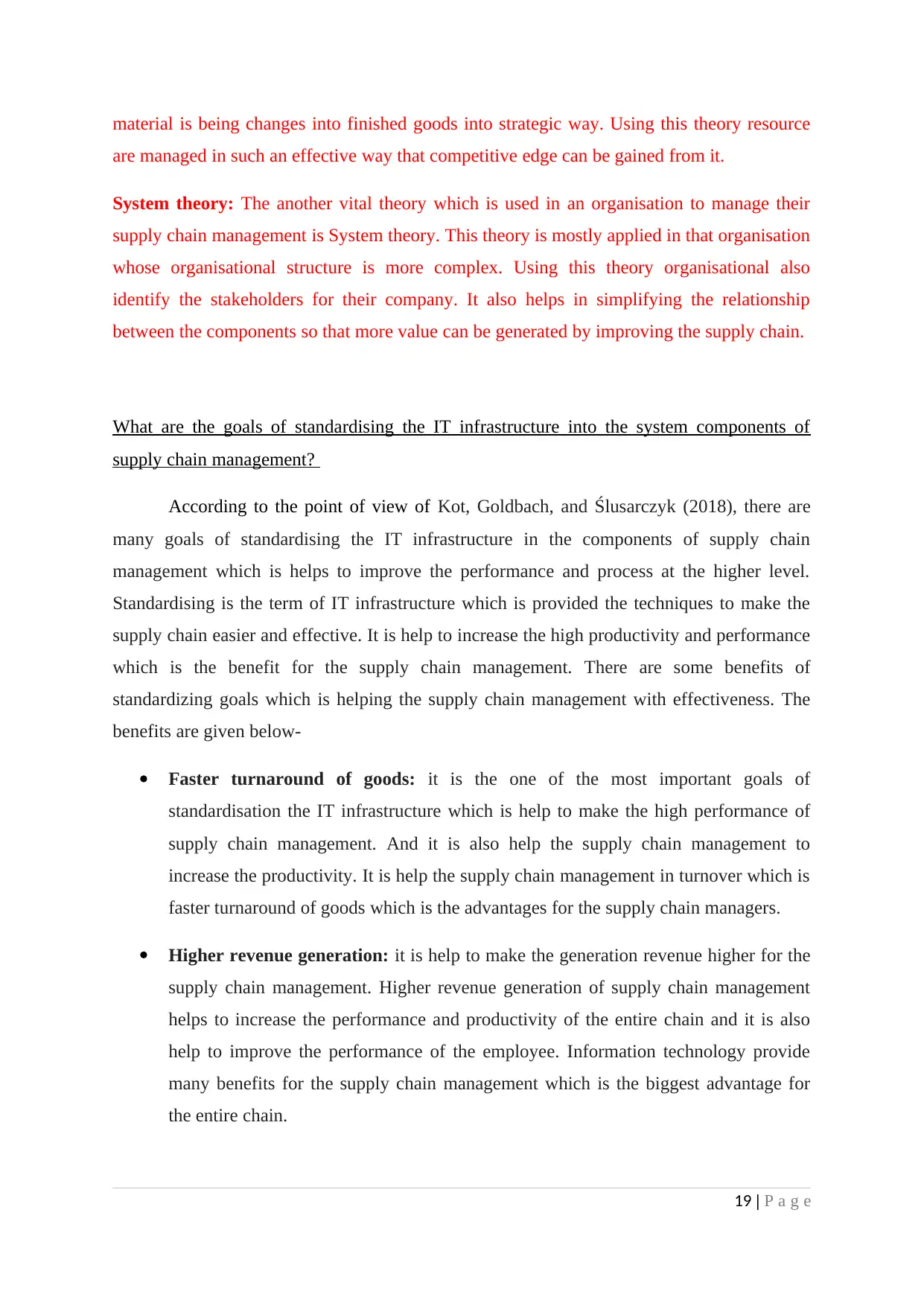
material is being changes into finished goods into strategic way. Using this theory resource
are managed in such an effective way that competitive edge can be gained from it.
System theory: The another vital theory which is used in an organisation to manage their
supply chain management is System theory. This theory is mostly applied in that organisation
whose organisational structure is more complex. Using this theory organisational also
identify the stakeholders for their company. It also helps in simplifying the relationship
between the components so that more value can be generated by improving the supply chain.
What are the goals of standardising the IT infrastructure into the system components of
supply chain management?
According to the point of view of Kot, Goldbach, and Ślusarczyk (2018), there are
many goals of standardising the IT infrastructure in the components of supply chain
management which is helps to improve the performance and process at the higher level.
Standardising is the term of IT infrastructure which is provided the techniques to make the
supply chain easier and effective. It is help to increase the high productivity and performance
which is the benefit for the supply chain management. There are some benefits of
standardizing goals which is helping the supply chain management with effectiveness. The
benefits are given below-
Faster turnaround of goods: it is the one of the most important goals of
standardisation the IT infrastructure which is help to make the high performance of
supply chain management. And it is also help the supply chain management to
increase the productivity. It is help the supply chain management in turnover which is
faster turnaround of goods which is the advantages for the supply chain managers.
Higher revenue generation: it is help to make the generation revenue higher for the
supply chain management. Higher revenue generation of supply chain management
helps to increase the performance and productivity of the entire chain and it is also
help to improve the performance of the employee. Information technology provide
many benefits for the supply chain management which is the biggest advantage for
the entire chain.
19 | P a g e
are managed in such an effective way that competitive edge can be gained from it.
System theory: The another vital theory which is used in an organisation to manage their
supply chain management is System theory. This theory is mostly applied in that organisation
whose organisational structure is more complex. Using this theory organisational also
identify the stakeholders for their company. It also helps in simplifying the relationship
between the components so that more value can be generated by improving the supply chain.
What are the goals of standardising the IT infrastructure into the system components of
supply chain management?
According to the point of view of Kot, Goldbach, and Ślusarczyk (2018), there are
many goals of standardising the IT infrastructure in the components of supply chain
management which is helps to improve the performance and process at the higher level.
Standardising is the term of IT infrastructure which is provided the techniques to make the
supply chain easier and effective. It is help to increase the high productivity and performance
which is the benefit for the supply chain management. There are some benefits of
standardizing goals which is helping the supply chain management with effectiveness. The
benefits are given below-
Faster turnaround of goods: it is the one of the most important goals of
standardisation the IT infrastructure which is help to make the high performance of
supply chain management. And it is also help the supply chain management to
increase the productivity. It is help the supply chain management in turnover which is
faster turnaround of goods which is the advantages for the supply chain managers.
Higher revenue generation: it is help to make the generation revenue higher for the
supply chain management. Higher revenue generation of supply chain management
helps to increase the performance and productivity of the entire chain and it is also
help to improve the performance of the employee. Information technology provide
many benefits for the supply chain management which is the biggest advantage for
the entire chain.
19 | P a g e
Paraphrase This Document
Need a fresh take? Get an instant paraphrase of this document with our AI Paraphraser
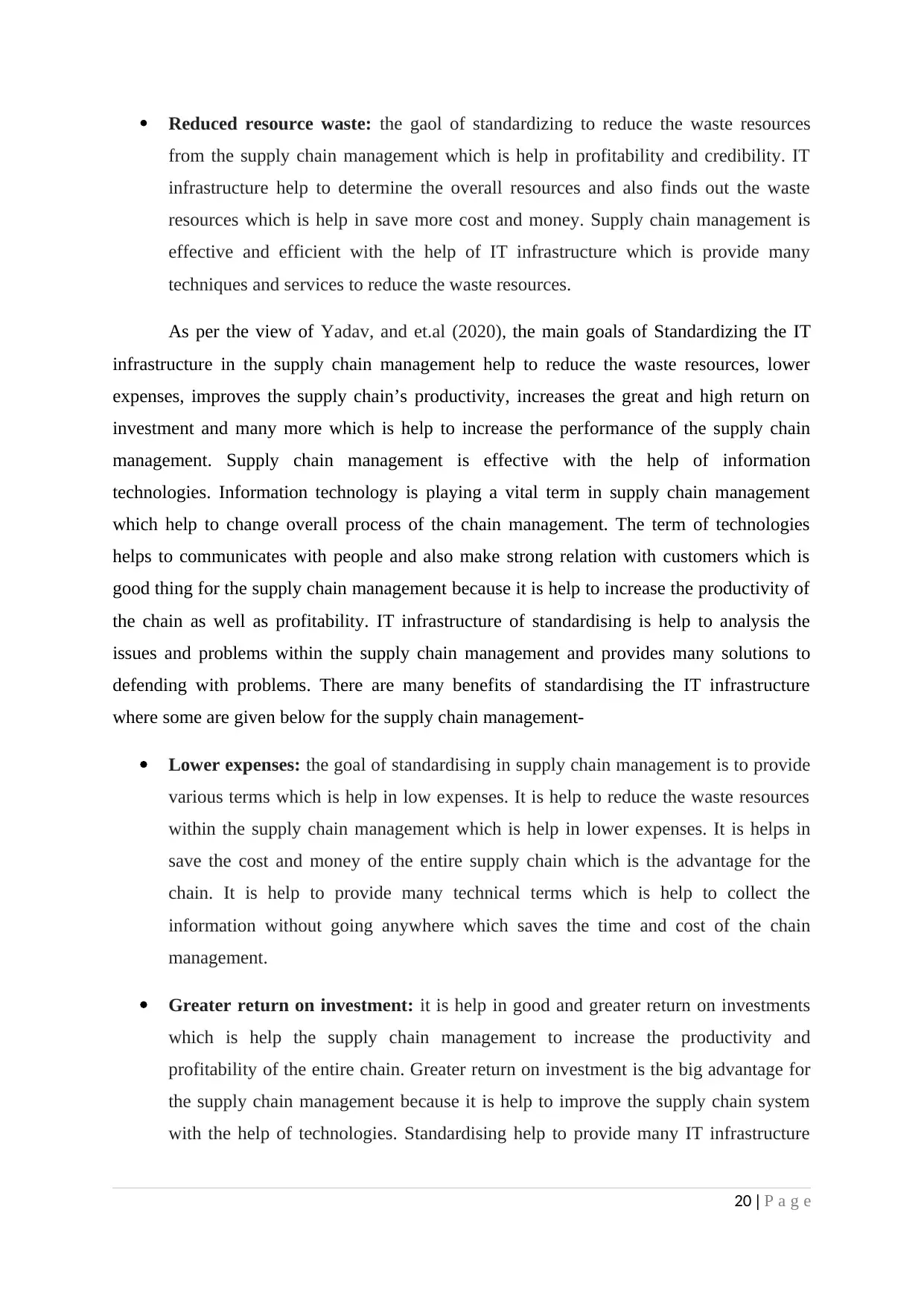
Reduced resource waste: the gaol of standardizing to reduce the waste resources
from the supply chain management which is help in profitability and credibility. IT
infrastructure help to determine the overall resources and also finds out the waste
resources which is help in save more cost and money. Supply chain management is
effective and efficient with the help of IT infrastructure which is provide many
techniques and services to reduce the waste resources.
As per the view of Yadav, and et.al (2020), the main goals of Standardizing the IT
infrastructure in the supply chain management help to reduce the waste resources, lower
expenses, improves the supply chain’s productivity, increases the great and high return on
investment and many more which is help to increase the performance of the supply chain
management. Supply chain management is effective with the help of information
technologies. Information technology is playing a vital term in supply chain management
which help to change overall process of the chain management. The term of technologies
helps to communicates with people and also make strong relation with customers which is
good thing for the supply chain management because it is help to increase the productivity of
the chain as well as profitability. IT infrastructure of standardising is help to analysis the
issues and problems within the supply chain management and provides many solutions to
defending with problems. There are many benefits of standardising the IT infrastructure
where some are given below for the supply chain management-
Lower expenses: the goal of standardising in supply chain management is to provide
various terms which is help in low expenses. It is help to reduce the waste resources
within the supply chain management which is help in lower expenses. It is helps in
save the cost and money of the entire supply chain which is the advantage for the
chain. It is help to provide many technical terms which is help to collect the
information without going anywhere which saves the time and cost of the chain
management.
Greater return on investment: it is help in good and greater return on investments
which is help the supply chain management to increase the productivity and
profitability of the entire chain. Greater return on investment is the big advantage for
the supply chain management because it is help to improve the supply chain system
with the help of technologies. Standardising help to provide many IT infrastructure
20 | P a g e
from the supply chain management which is help in profitability and credibility. IT
infrastructure help to determine the overall resources and also finds out the waste
resources which is help in save more cost and money. Supply chain management is
effective and efficient with the help of IT infrastructure which is provide many
techniques and services to reduce the waste resources.
As per the view of Yadav, and et.al (2020), the main goals of Standardizing the IT
infrastructure in the supply chain management help to reduce the waste resources, lower
expenses, improves the supply chain’s productivity, increases the great and high return on
investment and many more which is help to increase the performance of the supply chain
management. Supply chain management is effective with the help of information
technologies. Information technology is playing a vital term in supply chain management
which help to change overall process of the chain management. The term of technologies
helps to communicates with people and also make strong relation with customers which is
good thing for the supply chain management because it is help to increase the productivity of
the chain as well as profitability. IT infrastructure of standardising is help to analysis the
issues and problems within the supply chain management and provides many solutions to
defending with problems. There are many benefits of standardising the IT infrastructure
where some are given below for the supply chain management-
Lower expenses: the goal of standardising in supply chain management is to provide
various terms which is help in low expenses. It is help to reduce the waste resources
within the supply chain management which is help in lower expenses. It is helps in
save the cost and money of the entire supply chain which is the advantage for the
chain. It is help to provide many technical terms which is help to collect the
information without going anywhere which saves the time and cost of the chain
management.
Greater return on investment: it is help in good and greater return on investments
which is help the supply chain management to increase the productivity and
profitability of the entire chain. Greater return on investment is the big advantage for
the supply chain management because it is help to improve the supply chain system
with the help of technologies. Standardising help to provide many IT infrastructure
20 | P a g e

technologies which is help to improve the supply chain management with great return
on investment Ramirez-Peña, and et.al (2020).
Improves productivity of the entire chain: Standardising the IT infrastructure helps
to improve the performance and productivity of entire supply chain management
which is provide some technical terms to chain to improving their productivity and
performance of the entire chain. Standardising the IT infrastructure help to provide
the best technologies which is help to increase the profitability and productivity of the
chain management.
According to the view of Lewin, and et.al (2018), The goal of standardizing the IT
infrastructure is to make the supply chain management more efficient and effective which is
help in increasing the productivity and performance of the supply chain. It is help to increase
the buying power of customers and also increasing the productivity of the entire chain, it is
also help in centralised communication which is the advantage for the supply chain
management. Supply chain management is the term which makes strong and effective with
the help of technologies. Information technologies help to provide many functions which is
help to make the supply chain easy and effective. There are some benefits of information
technologies on the supply chain management which is help in increasing the productivity of
the entire chain which are given below-
Fewer drops in errors, losses, and delays: it is helps to provide many strategic
solutions which is helps in delays, errors and losses which is help the supply chain to
analysis the risk and issues within the entire chain and use the standardising IT
infrastructure by dropping the technologies in the errors, losses and delays. It is help
to complete the overall supply chain management without any losses, errors and
delays which is the advantage for the entire chain.
Increase in procurement and buying power: it is help to increase the buying power
of customers and also increase the procurement in customers which is help to increase
the productivity of the supply chain management. Standardising IT infrastructure
providing the techniques which is help to increase the customer purchasing behaviour
which is also increase the profit of the supply chain management. It is help to manage
the overall chain and its function which is help to attract the customers and change
their buying behaviour towards the supply chain Al-Aomar, and Hussain (2018).
21 | P a g e
on investment Ramirez-Peña, and et.al (2020).
Improves productivity of the entire chain: Standardising the IT infrastructure helps
to improve the performance and productivity of entire supply chain management
which is provide some technical terms to chain to improving their productivity and
performance of the entire chain. Standardising the IT infrastructure help to provide
the best technologies which is help to increase the profitability and productivity of the
chain management.
According to the view of Lewin, and et.al (2018), The goal of standardizing the IT
infrastructure is to make the supply chain management more efficient and effective which is
help in increasing the productivity and performance of the supply chain. It is help to increase
the buying power of customers and also increasing the productivity of the entire chain, it is
also help in centralised communication which is the advantage for the supply chain
management. Supply chain management is the term which makes strong and effective with
the help of technologies. Information technologies help to provide many functions which is
help to make the supply chain easy and effective. There are some benefits of information
technologies on the supply chain management which is help in increasing the productivity of
the entire chain which are given below-
Fewer drops in errors, losses, and delays: it is helps to provide many strategic
solutions which is helps in delays, errors and losses which is help the supply chain to
analysis the risk and issues within the entire chain and use the standardising IT
infrastructure by dropping the technologies in the errors, losses and delays. It is help
to complete the overall supply chain management without any losses, errors and
delays which is the advantage for the entire chain.
Increase in procurement and buying power: it is help to increase the buying power
of customers and also increase the procurement in customers which is help to increase
the productivity of the supply chain management. Standardising IT infrastructure
providing the techniques which is help to increase the customer purchasing behaviour
which is also increase the profit of the supply chain management. It is help to manage
the overall chain and its function which is help to attract the customers and change
their buying behaviour towards the supply chain Al-Aomar, and Hussain (2018).
21 | P a g e
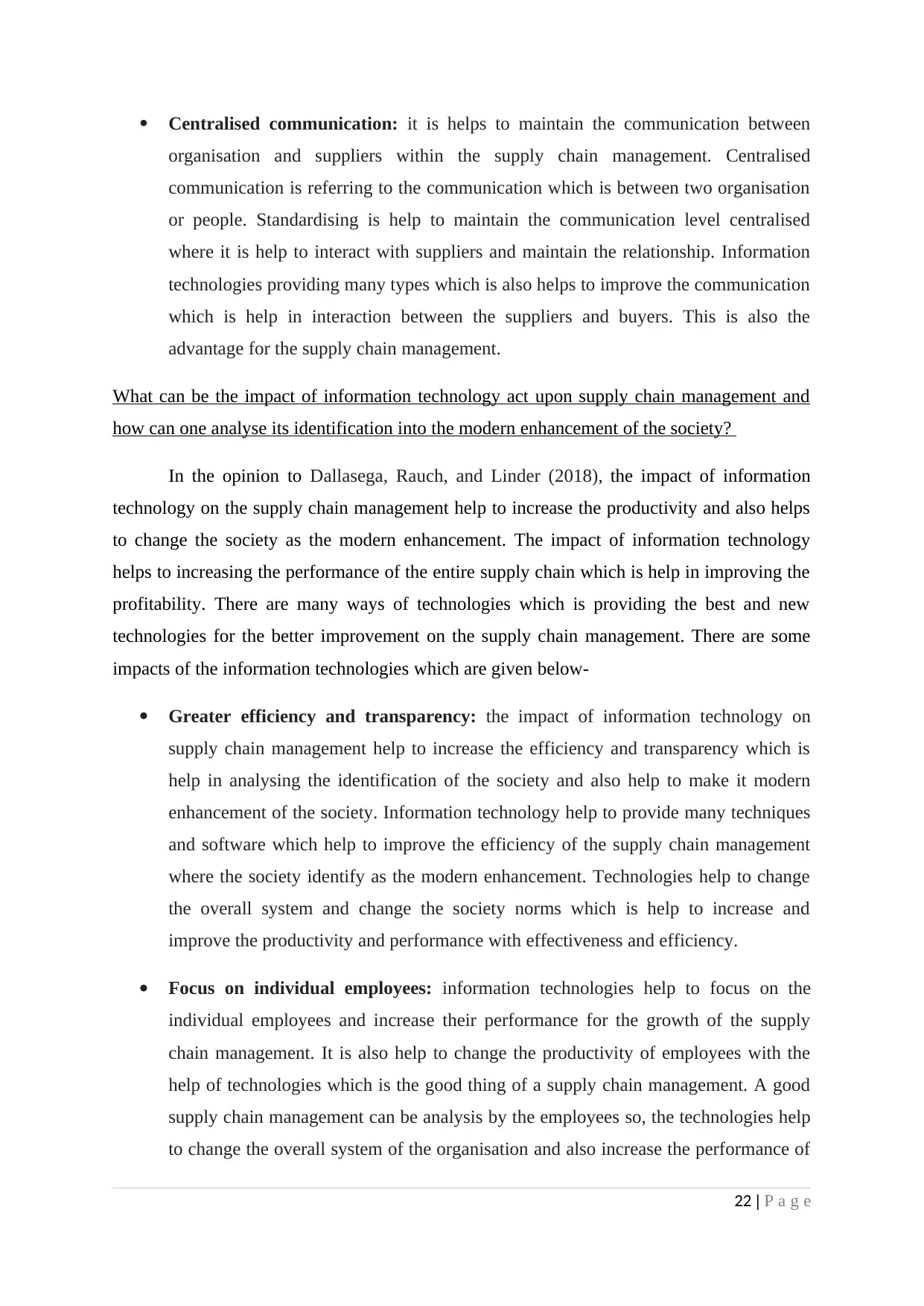
Centralised communication: it is helps to maintain the communication between
organisation and suppliers within the supply chain management. Centralised
communication is referring to the communication which is between two organisation
or people. Standardising is help to maintain the communication level centralised
where it is help to interact with suppliers and maintain the relationship. Information
technologies providing many types which is also helps to improve the communication
which is help in interaction between the suppliers and buyers. This is also the
advantage for the supply chain management.
What can be the impact of information technology act upon supply chain management and
how can one analyse its identification into the modern enhancement of the society?
In the opinion to Dallasega, Rauch, and Linder (2018), the impact of information
technology on the supply chain management help to increase the productivity and also helps
to change the society as the modern enhancement. The impact of information technology
helps to increasing the performance of the entire supply chain which is help in improving the
profitability. There are many ways of technologies which is providing the best and new
technologies for the better improvement on the supply chain management. There are some
impacts of the information technologies which are given below-
Greater efficiency and transparency: the impact of information technology on
supply chain management help to increase the efficiency and transparency which is
help in analysing the identification of the society and also help to make it modern
enhancement of the society. Information technology help to provide many techniques
and software which help to improve the efficiency of the supply chain management
where the society identify as the modern enhancement. Technologies help to change
the overall system and change the society norms which is help to increase and
improve the productivity and performance with effectiveness and efficiency.
Focus on individual employees: information technologies help to focus on the
individual employees and increase their performance for the growth of the supply
chain management. It is also help to change the productivity of employees with the
help of technologies which is the good thing of a supply chain management. A good
supply chain management can be analysis by the employees so, the technologies help
to change the overall system of the organisation and also increase the performance of
22 | P a g e
organisation and suppliers within the supply chain management. Centralised
communication is referring to the communication which is between two organisation
or people. Standardising is help to maintain the communication level centralised
where it is help to interact with suppliers and maintain the relationship. Information
technologies providing many types which is also helps to improve the communication
which is help in interaction between the suppliers and buyers. This is also the
advantage for the supply chain management.
What can be the impact of information technology act upon supply chain management and
how can one analyse its identification into the modern enhancement of the society?
In the opinion to Dallasega, Rauch, and Linder (2018), the impact of information
technology on the supply chain management help to increase the productivity and also helps
to change the society as the modern enhancement. The impact of information technology
helps to increasing the performance of the entire supply chain which is help in improving the
profitability. There are many ways of technologies which is providing the best and new
technologies for the better improvement on the supply chain management. There are some
impacts of the information technologies which are given below-
Greater efficiency and transparency: the impact of information technology on
supply chain management help to increase the efficiency and transparency which is
help in analysing the identification of the society and also help to make it modern
enhancement of the society. Information technology help to provide many techniques
and software which help to improve the efficiency of the supply chain management
where the society identify as the modern enhancement. Technologies help to change
the overall system and change the society norms which is help to increase and
improve the productivity and performance with effectiveness and efficiency.
Focus on individual employees: information technologies help to focus on the
individual employees and increase their performance for the growth of the supply
chain management. It is also help to change the productivity of employees with the
help of technologies which is the good thing of a supply chain management. A good
supply chain management can be analysis by the employees so, the technologies help
to change the overall system of the organisation and also increase the performance of
22 | P a g e
Secure Best Marks with AI Grader
Need help grading? Try our AI Grader for instant feedback on your assignments.
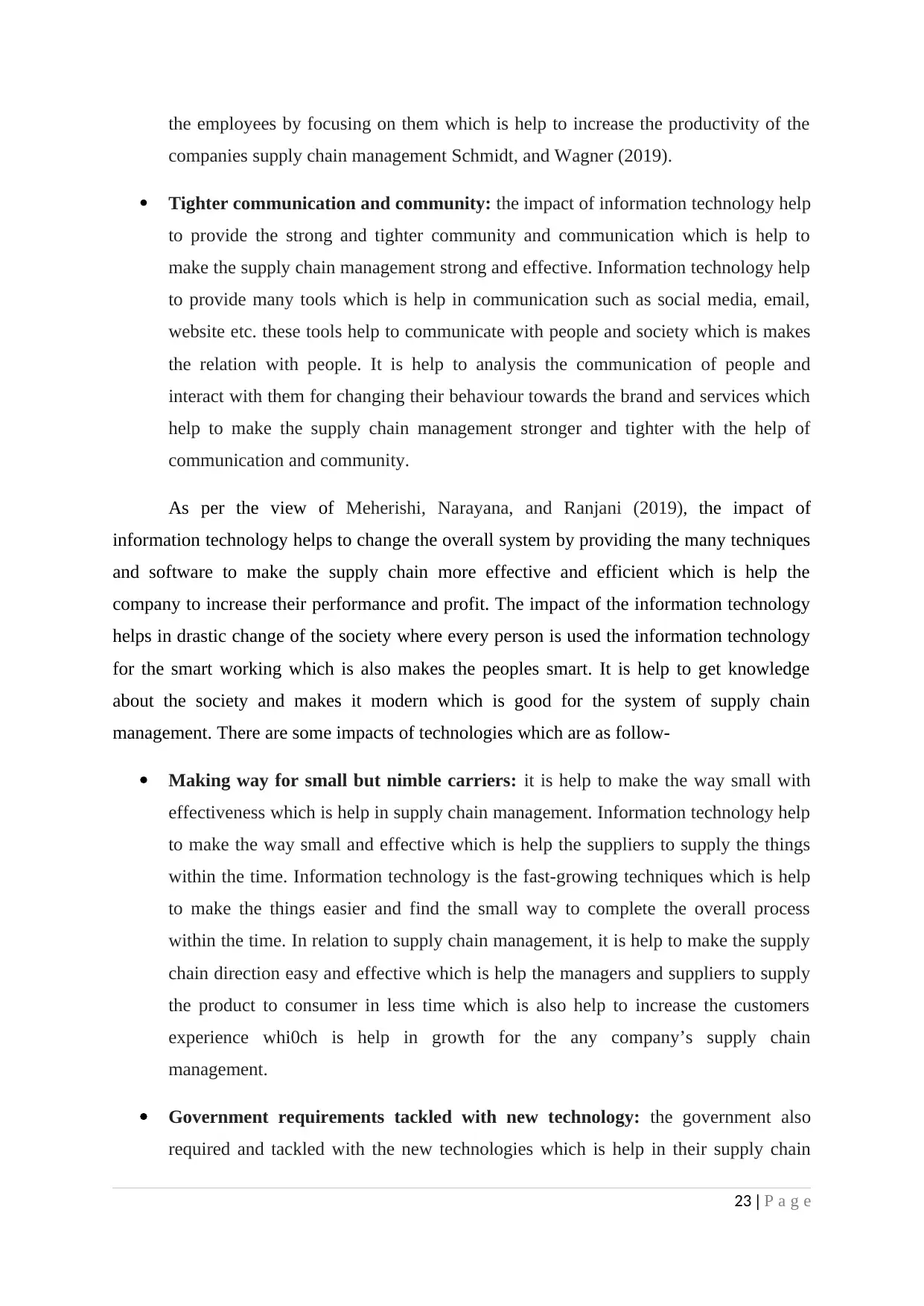
the employees by focusing on them which is help to increase the productivity of the
companies supply chain management Schmidt, and Wagner (2019).
Tighter communication and community: the impact of information technology help
to provide the strong and tighter community and communication which is help to
make the supply chain management strong and effective. Information technology help
to provide many tools which is help in communication such as social media, email,
website etc. these tools help to communicate with people and society which is makes
the relation with people. It is help to analysis the communication of people and
interact with them for changing their behaviour towards the brand and services which
help to make the supply chain management stronger and tighter with the help of
communication and community.
As per the view of Meherishi, Narayana, and Ranjani (2019), the impact of
information technology helps to change the overall system by providing the many techniques
and software to make the supply chain more effective and efficient which is help the
company to increase their performance and profit. The impact of the information technology
helps in drastic change of the society where every person is used the information technology
for the smart working which is also makes the peoples smart. It is help to get knowledge
about the society and makes it modern which is good for the system of supply chain
management. There are some impacts of technologies which are as follow-
Making way for small but nimble carriers: it is help to make the way small with
effectiveness which is help in supply chain management. Information technology help
to make the way small and effective which is help the suppliers to supply the things
within the time. Information technology is the fast-growing techniques which is help
to make the things easier and find the small way to complete the overall process
within the time. In relation to supply chain management, it is help to make the supply
chain direction easy and effective which is help the managers and suppliers to supply
the product to consumer in less time which is also help to increase the customers
experience whi0ch is help in growth for the any company’s supply chain
management.
Government requirements tackled with new technology: the government also
required and tackled with the new technologies which is help in their supply chain
23 | P a g e
companies supply chain management Schmidt, and Wagner (2019).
Tighter communication and community: the impact of information technology help
to provide the strong and tighter community and communication which is help to
make the supply chain management strong and effective. Information technology help
to provide many tools which is help in communication such as social media, email,
website etc. these tools help to communicate with people and society which is makes
the relation with people. It is help to analysis the communication of people and
interact with them for changing their behaviour towards the brand and services which
help to make the supply chain management stronger and tighter with the help of
communication and community.
As per the view of Meherishi, Narayana, and Ranjani (2019), the impact of
information technology helps to change the overall system by providing the many techniques
and software to make the supply chain more effective and efficient which is help the
company to increase their performance and profit. The impact of the information technology
helps in drastic change of the society where every person is used the information technology
for the smart working which is also makes the peoples smart. It is help to get knowledge
about the society and makes it modern which is good for the system of supply chain
management. There are some impacts of technologies which are as follow-
Making way for small but nimble carriers: it is help to make the way small with
effectiveness which is help in supply chain management. Information technology help
to make the way small and effective which is help the suppliers to supply the things
within the time. Information technology is the fast-growing techniques which is help
to make the things easier and find the small way to complete the overall process
within the time. In relation to supply chain management, it is help to make the supply
chain direction easy and effective which is help the managers and suppliers to supply
the product to consumer in less time which is also help to increase the customers
experience whi0ch is help in growth for the any company’s supply chain
management.
Government requirements tackled with new technology: the government also
required and tackled with the new technologies which is help in their supply chain
23 | P a g e
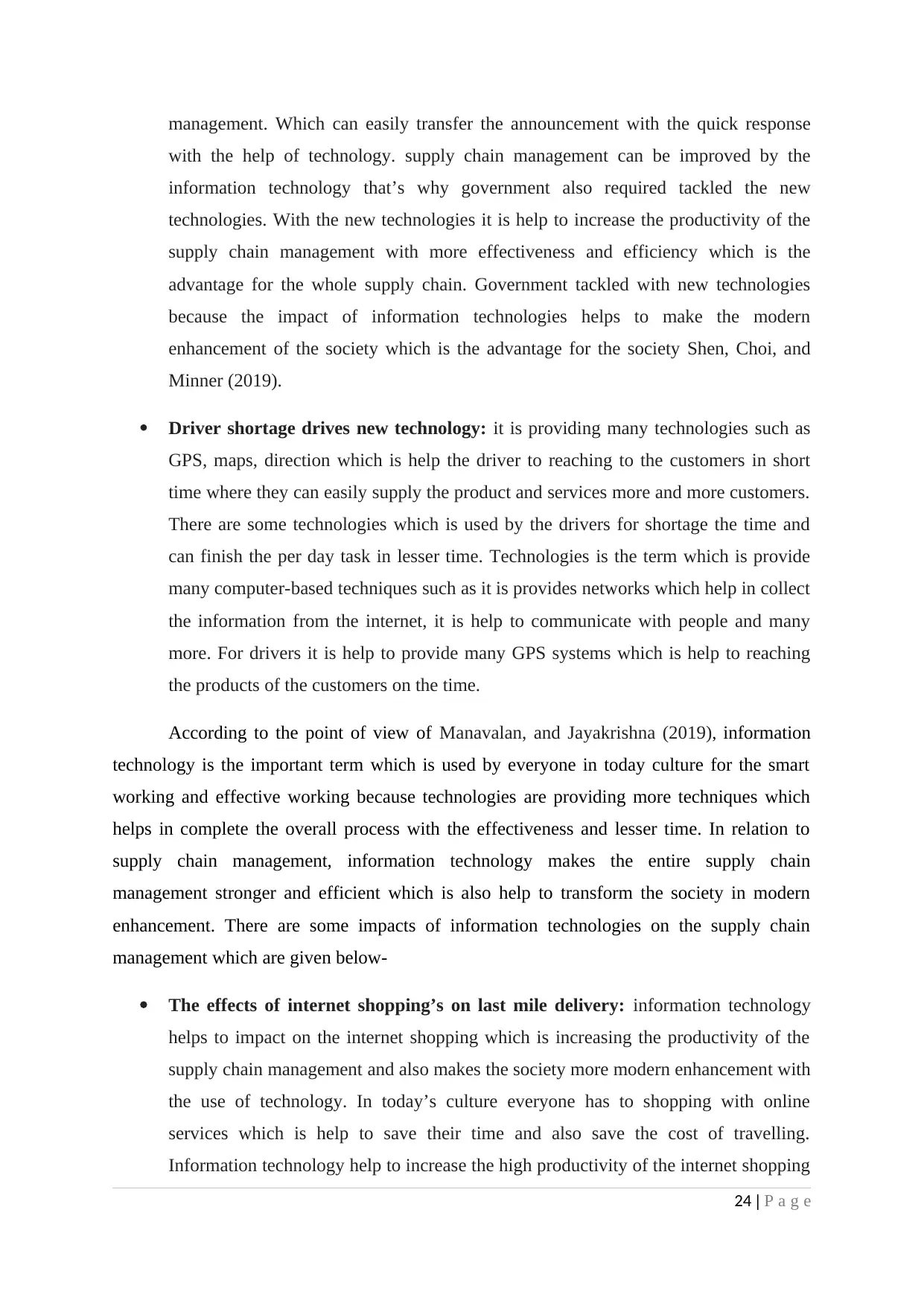
management. Which can easily transfer the announcement with the quick response
with the help of technology. supply chain management can be improved by the
information technology that’s why government also required tackled the new
technologies. With the new technologies it is help to increase the productivity of the
supply chain management with more effectiveness and efficiency which is the
advantage for the whole supply chain. Government tackled with new technologies
because the impact of information technologies helps to make the modern
enhancement of the society which is the advantage for the society Shen, Choi, and
Minner (2019).
Driver shortage drives new technology: it is providing many technologies such as
GPS, maps, direction which is help the driver to reaching to the customers in short
time where they can easily supply the product and services more and more customers.
There are some technologies which is used by the drivers for shortage the time and
can finish the per day task in lesser time. Technologies is the term which is provide
many computer-based techniques such as it is provides networks which help in collect
the information from the internet, it is help to communicate with people and many
more. For drivers it is help to provide many GPS systems which is help to reaching
the products of the customers on the time.
According to the point of view of Manavalan, and Jayakrishna (2019), information
technology is the important term which is used by everyone in today culture for the smart
working and effective working because technologies are providing more techniques which
helps in complete the overall process with the effectiveness and lesser time. In relation to
supply chain management, information technology makes the entire supply chain
management stronger and efficient which is also help to transform the society in modern
enhancement. There are some impacts of information technologies on the supply chain
management which are given below-
The effects of internet shopping’s on last mile delivery: information technology
helps to impact on the internet shopping which is increasing the productivity of the
supply chain management and also makes the society more modern enhancement with
the use of technology. In today’s culture everyone has to shopping with online
services which is help to save their time and also save the cost of travelling.
Information technology help to increase the high productivity of the internet shopping
24 | P a g e
with the help of technology. supply chain management can be improved by the
information technology that’s why government also required tackled the new
technologies. With the new technologies it is help to increase the productivity of the
supply chain management with more effectiveness and efficiency which is the
advantage for the whole supply chain. Government tackled with new technologies
because the impact of information technologies helps to make the modern
enhancement of the society which is the advantage for the society Shen, Choi, and
Minner (2019).
Driver shortage drives new technology: it is providing many technologies such as
GPS, maps, direction which is help the driver to reaching to the customers in short
time where they can easily supply the product and services more and more customers.
There are some technologies which is used by the drivers for shortage the time and
can finish the per day task in lesser time. Technologies is the term which is provide
many computer-based techniques such as it is provides networks which help in collect
the information from the internet, it is help to communicate with people and many
more. For drivers it is help to provide many GPS systems which is help to reaching
the products of the customers on the time.
According to the point of view of Manavalan, and Jayakrishna (2019), information
technology is the important term which is used by everyone in today culture for the smart
working and effective working because technologies are providing more techniques which
helps in complete the overall process with the effectiveness and lesser time. In relation to
supply chain management, information technology makes the entire supply chain
management stronger and efficient which is also help to transform the society in modern
enhancement. There are some impacts of information technologies on the supply chain
management which are given below-
The effects of internet shopping’s on last mile delivery: information technology
helps to impact on the internet shopping which is increasing the productivity of the
supply chain management and also makes the society more modern enhancement with
the use of technology. In today’s culture everyone has to shopping with online
services which is help to save their time and also save the cost of travelling.
Information technology help to increase the high productivity of the internet shopping
24 | P a g e
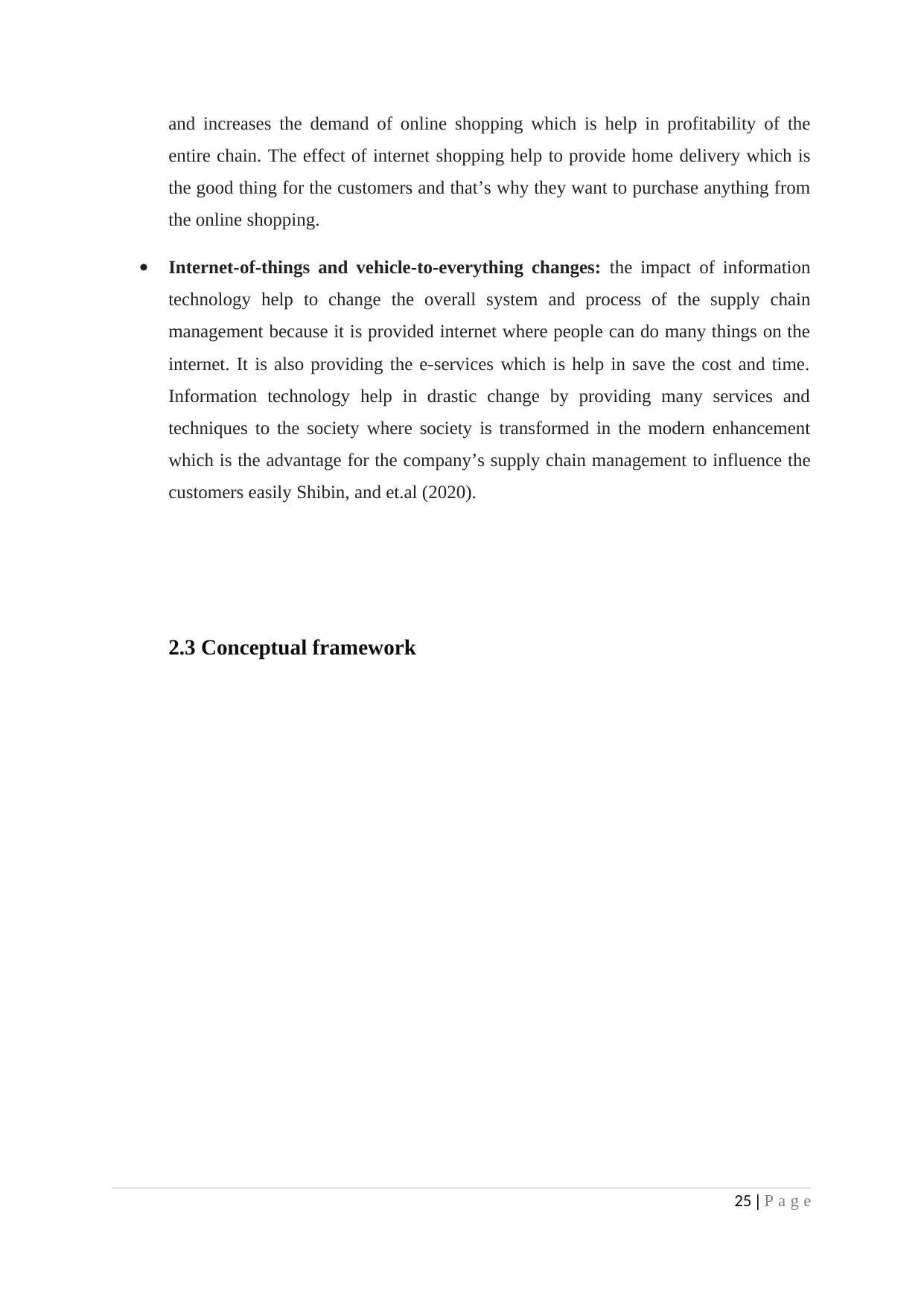
and increases the demand of online shopping which is help in profitability of the
entire chain. The effect of internet shopping help to provide home delivery which is
the good thing for the customers and that’s why they want to purchase anything from
the online shopping.
Internet-of-things and vehicle-to-everything changes: the impact of information
technology help to change the overall system and process of the supply chain
management because it is provided internet where people can do many things on the
internet. It is also providing the e-services which is help in save the cost and time.
Information technology help in drastic change by providing many services and
techniques to the society where society is transformed in the modern enhancement
which is the advantage for the company’s supply chain management to influence the
customers easily Shibin, and et.al (2020).
2.3 Conceptual framework
25 | P a g e
entire chain. The effect of internet shopping help to provide home delivery which is
the good thing for the customers and that’s why they want to purchase anything from
the online shopping.
Internet-of-things and vehicle-to-everything changes: the impact of information
technology help to change the overall system and process of the supply chain
management because it is provided internet where people can do many things on the
internet. It is also providing the e-services which is help in save the cost and time.
Information technology help in drastic change by providing many services and
techniques to the society where society is transformed in the modern enhancement
which is the advantage for the company’s supply chain management to influence the
customers easily Shibin, and et.al (2020).
2.3 Conceptual framework
25 | P a g e
Paraphrase This Document
Need a fresh take? Get an instant paraphrase of this document with our AI Paraphraser
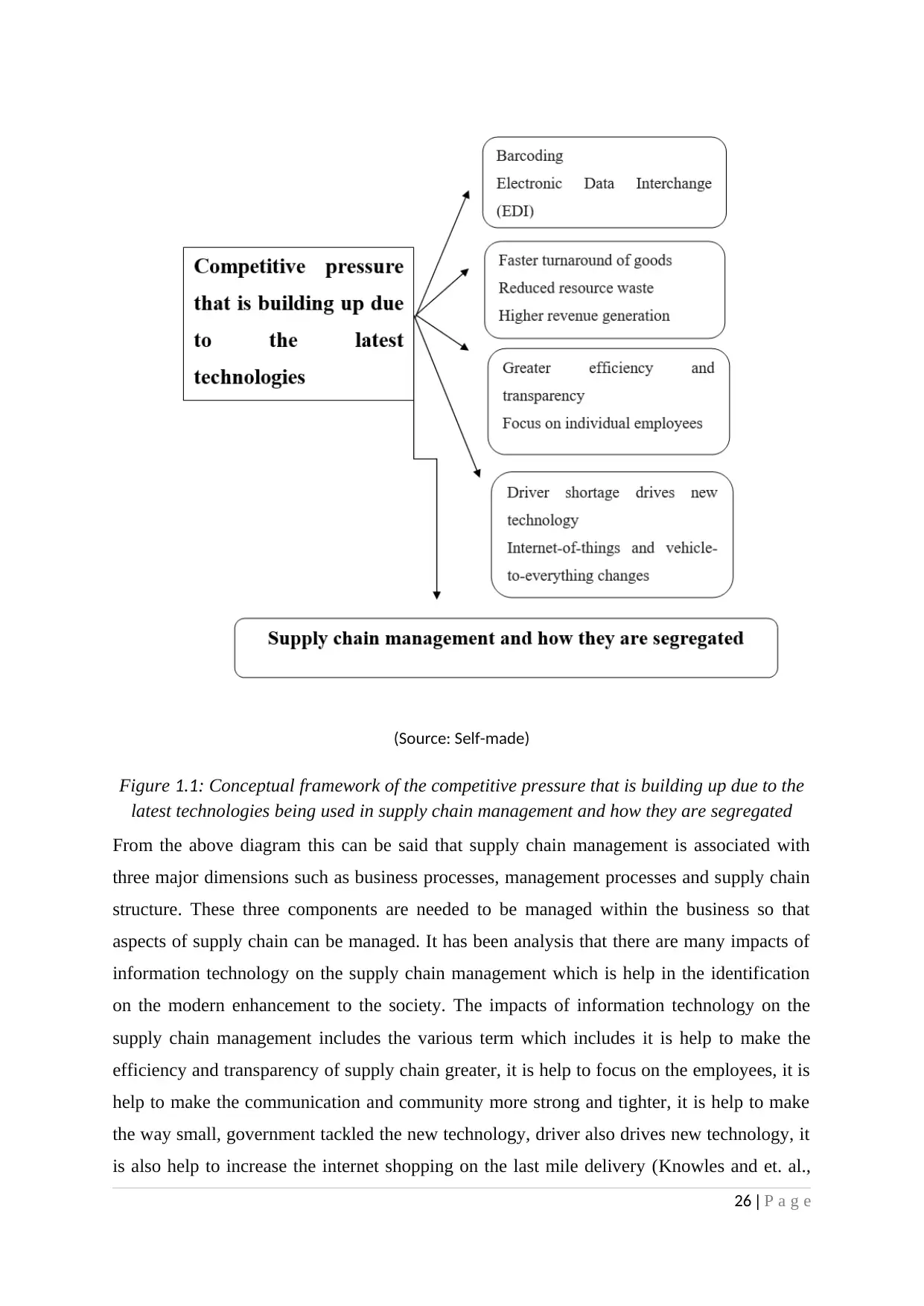
(Source: Self-made)
Figure 1.1: Conceptual framework of the competitive pressure that is building up due to the
latest technologies being used in supply chain management and how they are segregated
From the above diagram this can be said that supply chain management is associated with
three major dimensions such as business processes, management processes and supply chain
structure. These three components are needed to be managed within the business so that
aspects of supply chain can be managed. It has been analysis that there are many impacts of
information technology on the supply chain management which is help in the identification
on the modern enhancement to the society. The impacts of information technology on the
supply chain management includes the various term which includes it is help to make the
efficiency and transparency of supply chain greater, it is help to focus on the employees, it is
help to make the communication and community more strong and tighter, it is help to make
the way small, government tackled the new technology, driver also drives new technology, it
is also help to increase the internet shopping on the last mile delivery (Knowles and et. al.,
26 | P a g e
Figure 1.1: Conceptual framework of the competitive pressure that is building up due to the
latest technologies being used in supply chain management and how they are segregated
From the above diagram this can be said that supply chain management is associated with
three major dimensions such as business processes, management processes and supply chain
structure. These three components are needed to be managed within the business so that
aspects of supply chain can be managed. It has been analysis that there are many impacts of
information technology on the supply chain management which is help in the identification
on the modern enhancement to the society. The impacts of information technology on the
supply chain management includes the various term which includes it is help to make the
efficiency and transparency of supply chain greater, it is help to focus on the employees, it is
help to make the communication and community more strong and tighter, it is help to make
the way small, government tackled the new technology, driver also drives new technology, it
is also help to increase the internet shopping on the last mile delivery (Knowles and et. al.,
26 | P a g e
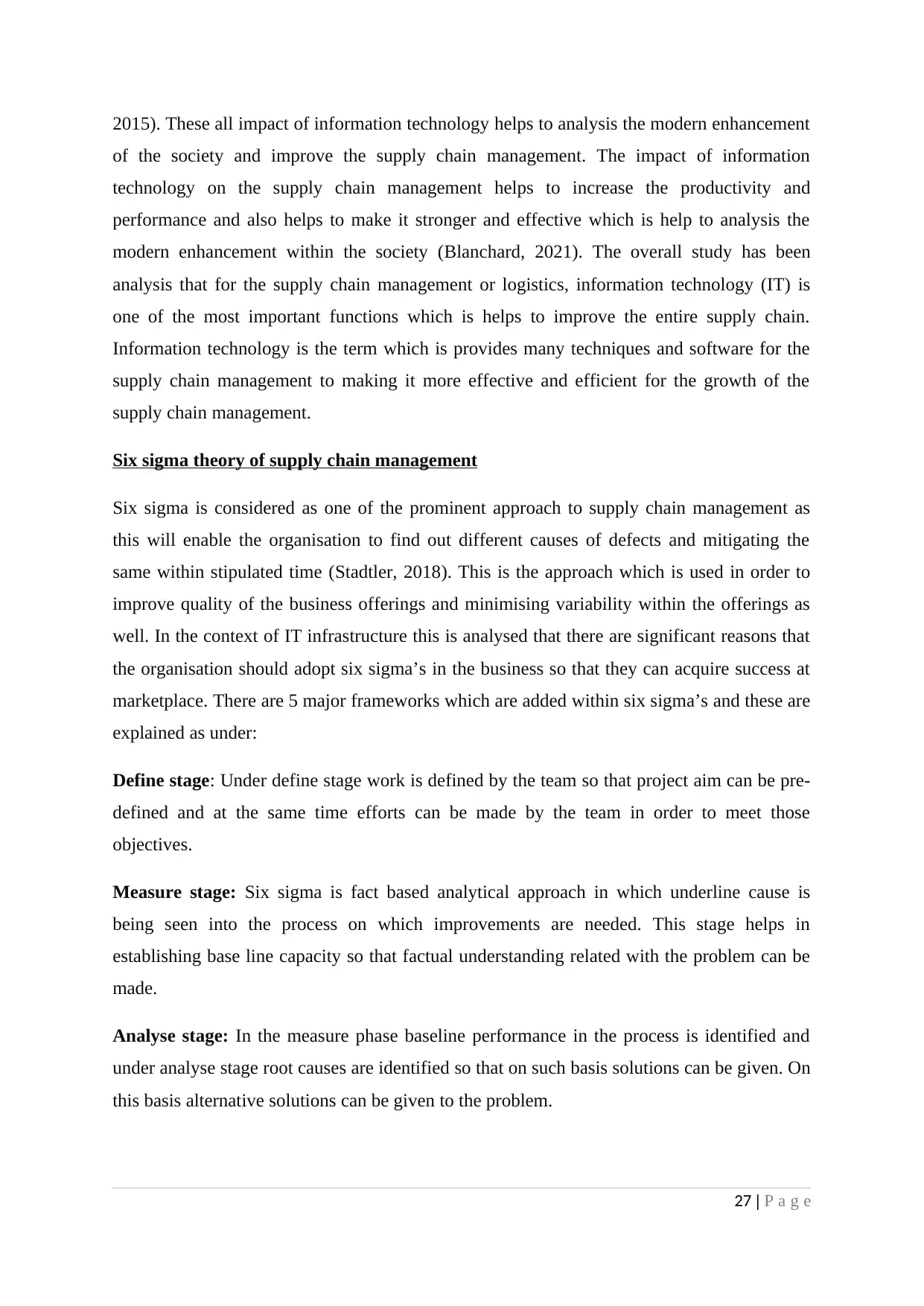
2015). These all impact of information technology helps to analysis the modern enhancement
of the society and improve the supply chain management. The impact of information
technology on the supply chain management helps to increase the productivity and
performance and also helps to make it stronger and effective which is help to analysis the
modern enhancement within the society (Blanchard, 2021). The overall study has been
analysis that for the supply chain management or logistics, information technology (IT) is
one of the most important functions which is helps to improve the entire supply chain.
Information technology is the term which is provides many techniques and software for the
supply chain management to making it more effective and efficient for the growth of the
supply chain management.
Six sigma theory of supply chain management
Six sigma is considered as one of the prominent approach to supply chain management as
this will enable the organisation to find out different causes of defects and mitigating the
same within stipulated time (Stadtler, 2018). This is the approach which is used in order to
improve quality of the business offerings and minimising variability within the offerings as
well. In the context of IT infrastructure this is analysed that there are significant reasons that
the organisation should adopt six sigma’s in the business so that they can acquire success at
marketplace. There are 5 major frameworks which are added within six sigma’s and these are
explained as under:
Define stage: Under define stage work is defined by the team so that project aim can be pre-
defined and at the same time efforts can be made by the team in order to meet those
objectives.
Measure stage: Six sigma is fact based analytical approach in which underline cause is
being seen into the process on which improvements are needed. This stage helps in
establishing base line capacity so that factual understanding related with the problem can be
made.
Analyse stage: In the measure phase baseline performance in the process is identified and
under analyse stage root causes are identified so that on such basis solutions can be given. On
this basis alternative solutions can be given to the problem.
27 | P a g e
of the society and improve the supply chain management. The impact of information
technology on the supply chain management helps to increase the productivity and
performance and also helps to make it stronger and effective which is help to analysis the
modern enhancement within the society (Blanchard, 2021). The overall study has been
analysis that for the supply chain management or logistics, information technology (IT) is
one of the most important functions which is helps to improve the entire supply chain.
Information technology is the term which is provides many techniques and software for the
supply chain management to making it more effective and efficient for the growth of the
supply chain management.
Six sigma theory of supply chain management
Six sigma is considered as one of the prominent approach to supply chain management as
this will enable the organisation to find out different causes of defects and mitigating the
same within stipulated time (Stadtler, 2018). This is the approach which is used in order to
improve quality of the business offerings and minimising variability within the offerings as
well. In the context of IT infrastructure this is analysed that there are significant reasons that
the organisation should adopt six sigma’s in the business so that they can acquire success at
marketplace. There are 5 major frameworks which are added within six sigma’s and these are
explained as under:
Define stage: Under define stage work is defined by the team so that project aim can be pre-
defined and at the same time efforts can be made by the team in order to meet those
objectives.
Measure stage: Six sigma is fact based analytical approach in which underline cause is
being seen into the process on which improvements are needed. This stage helps in
establishing base line capacity so that factual understanding related with the problem can be
made.
Analyse stage: In the measure phase baseline performance in the process is identified and
under analyse stage root causes are identified so that on such basis solutions can be given. On
this basis alternative solutions can be given to the problem.
27 | P a g e
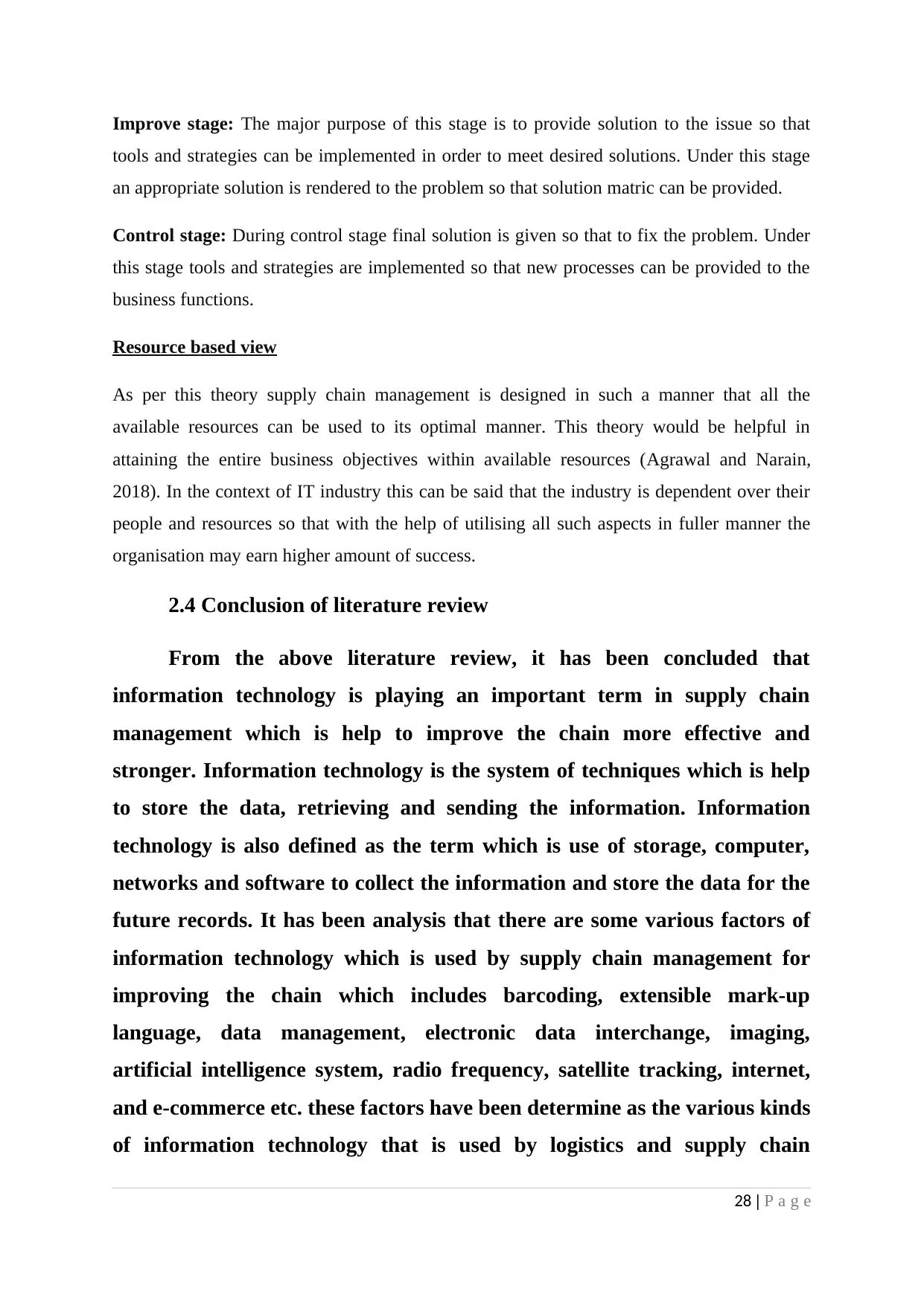
Improve stage: The major purpose of this stage is to provide solution to the issue so that
tools and strategies can be implemented in order to meet desired solutions. Under this stage
an appropriate solution is rendered to the problem so that solution matric can be provided.
Control stage: During control stage final solution is given so that to fix the problem. Under
this stage tools and strategies are implemented so that new processes can be provided to the
business functions.
Resource based view
As per this theory supply chain management is designed in such a manner that all the
available resources can be used to its optimal manner. This theory would be helpful in
attaining the entire business objectives within available resources (Agrawal and Narain,
2018). In the context of IT industry this can be said that the industry is dependent over their
people and resources so that with the help of utilising all such aspects in fuller manner the
organisation may earn higher amount of success.
2.4 Conclusion of literature review
From the above literature review, it has been concluded that
information technology is playing an important term in supply chain
management which is help to improve the chain more effective and
stronger. Information technology is the system of techniques which is help
to store the data, retrieving and sending the information. Information
technology is also defined as the term which is use of storage, computer,
networks and software to collect the information and store the data for the
future records. It has been analysis that there are some various factors of
information technology which is used by supply chain management for
improving the chain which includes barcoding, extensible mark-up
language, data management, electronic data interchange, imaging,
artificial intelligence system, radio frequency, satellite tracking, internet,
and e-commerce etc. these factors have been determine as the various kinds
of information technology that is used by logistics and supply chain
28 | P a g e
tools and strategies can be implemented in order to meet desired solutions. Under this stage
an appropriate solution is rendered to the problem so that solution matric can be provided.
Control stage: During control stage final solution is given so that to fix the problem. Under
this stage tools and strategies are implemented so that new processes can be provided to the
business functions.
Resource based view
As per this theory supply chain management is designed in such a manner that all the
available resources can be used to its optimal manner. This theory would be helpful in
attaining the entire business objectives within available resources (Agrawal and Narain,
2018). In the context of IT industry this can be said that the industry is dependent over their
people and resources so that with the help of utilising all such aspects in fuller manner the
organisation may earn higher amount of success.
2.4 Conclusion of literature review
From the above literature review, it has been concluded that
information technology is playing an important term in supply chain
management which is help to improve the chain more effective and
stronger. Information technology is the system of techniques which is help
to store the data, retrieving and sending the information. Information
technology is also defined as the term which is use of storage, computer,
networks and software to collect the information and store the data for the
future records. It has been analysis that there are some various factors of
information technology which is used by supply chain management for
improving the chain which includes barcoding, extensible mark-up
language, data management, electronic data interchange, imaging,
artificial intelligence system, radio frequency, satellite tracking, internet,
and e-commerce etc. these factors have been determine as the various kinds
of information technology that is used by logistics and supply chain
28 | P a g e
Secure Best Marks with AI Grader
Need help grading? Try our AI Grader for instant feedback on your assignments.
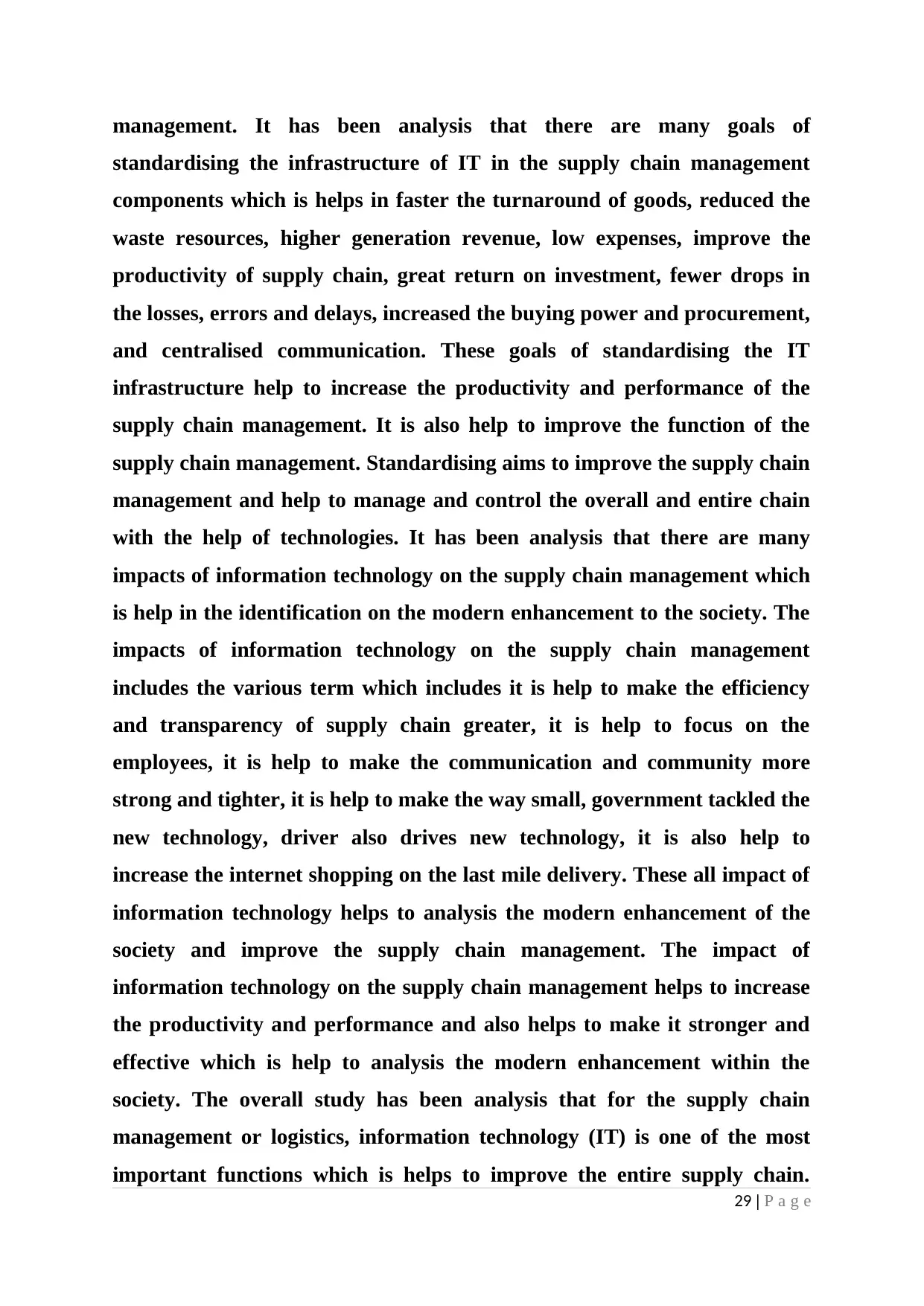
management. It has been analysis that there are many goals of
standardising the infrastructure of IT in the supply chain management
components which is helps in faster the turnaround of goods, reduced the
waste resources, higher generation revenue, low expenses, improve the
productivity of supply chain, great return on investment, fewer drops in
the losses, errors and delays, increased the buying power and procurement,
and centralised communication. These goals of standardising the IT
infrastructure help to increase the productivity and performance of the
supply chain management. It is also help to improve the function of the
supply chain management. Standardising aims to improve the supply chain
management and help to manage and control the overall and entire chain
with the help of technologies. It has been analysis that there are many
impacts of information technology on the supply chain management which
is help in the identification on the modern enhancement to the society. The
impacts of information technology on the supply chain management
includes the various term which includes it is help to make the efficiency
and transparency of supply chain greater, it is help to focus on the
employees, it is help to make the communication and community more
strong and tighter, it is help to make the way small, government tackled the
new technology, driver also drives new technology, it is also help to
increase the internet shopping on the last mile delivery. These all impact of
information technology helps to analysis the modern enhancement of the
society and improve the supply chain management. The impact of
information technology on the supply chain management helps to increase
the productivity and performance and also helps to make it stronger and
effective which is help to analysis the modern enhancement within the
society. The overall study has been analysis that for the supply chain
management or logistics, information technology (IT) is one of the most
important functions which is helps to improve the entire supply chain.
29 | P a g e
standardising the infrastructure of IT in the supply chain management
components which is helps in faster the turnaround of goods, reduced the
waste resources, higher generation revenue, low expenses, improve the
productivity of supply chain, great return on investment, fewer drops in
the losses, errors and delays, increased the buying power and procurement,
and centralised communication. These goals of standardising the IT
infrastructure help to increase the productivity and performance of the
supply chain management. It is also help to improve the function of the
supply chain management. Standardising aims to improve the supply chain
management and help to manage and control the overall and entire chain
with the help of technologies. It has been analysis that there are many
impacts of information technology on the supply chain management which
is help in the identification on the modern enhancement to the society. The
impacts of information technology on the supply chain management
includes the various term which includes it is help to make the efficiency
and transparency of supply chain greater, it is help to focus on the
employees, it is help to make the communication and community more
strong and tighter, it is help to make the way small, government tackled the
new technology, driver also drives new technology, it is also help to
increase the internet shopping on the last mile delivery. These all impact of
information technology helps to analysis the modern enhancement of the
society and improve the supply chain management. The impact of
information technology on the supply chain management helps to increase
the productivity and performance and also helps to make it stronger and
effective which is help to analysis the modern enhancement within the
society. The overall study has been analysis that for the supply chain
management or logistics, information technology (IT) is one of the most
important functions which is helps to improve the entire supply chain.
29 | P a g e
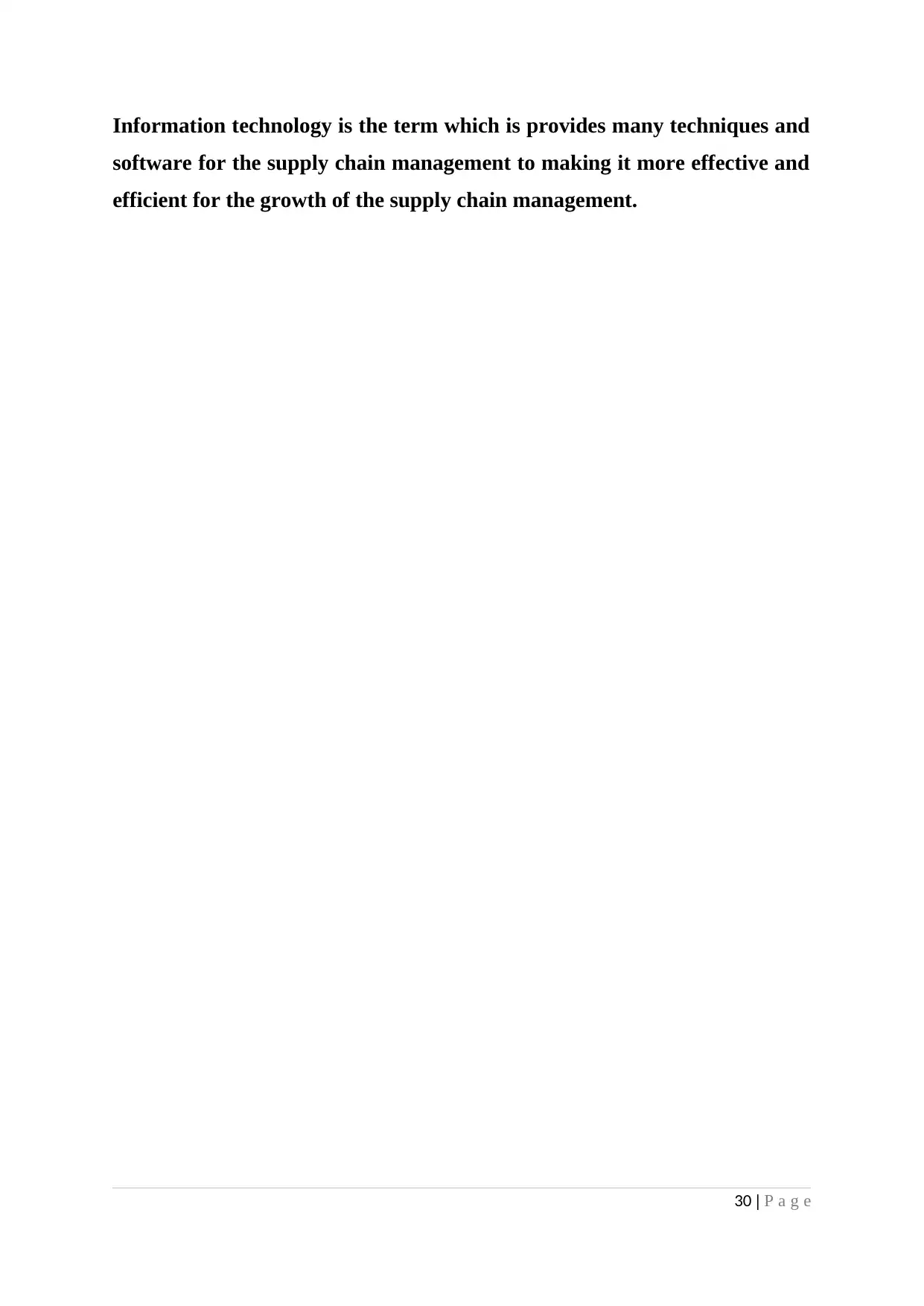
Information technology is the term which is provides many techniques and
software for the supply chain management to making it more effective and
efficient for the growth of the supply chain management.
30 | P a g e
software for the supply chain management to making it more effective and
efficient for the growth of the supply chain management.
30 | P a g e
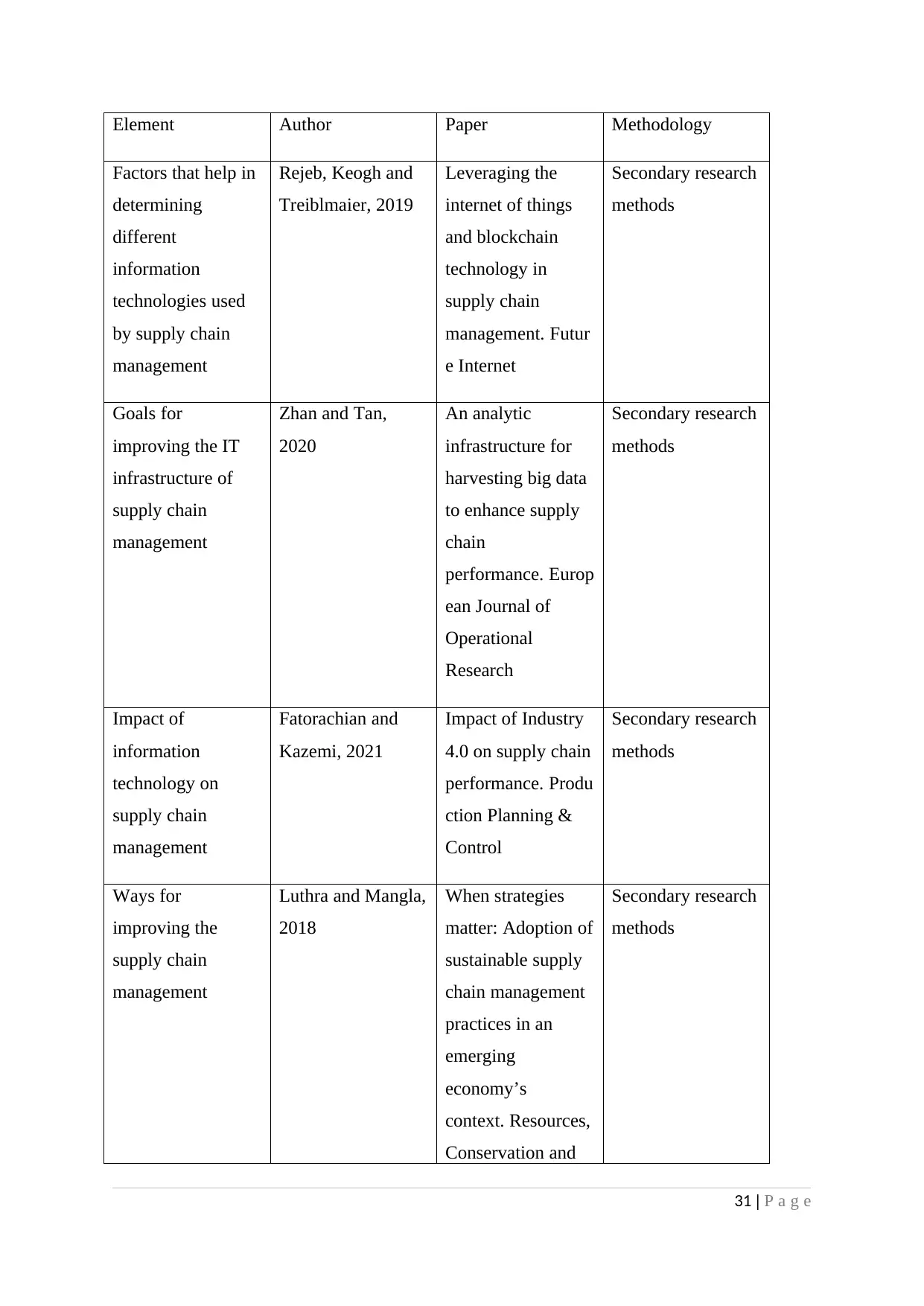
Element Author Paper Methodology
Factors that help in
determining
different
information
technologies used
by supply chain
management
Rejeb, Keogh and
Treiblmaier, 2019
Leveraging the
internet of things
and blockchain
technology in
supply chain
management. Futur
e Internet
Secondary research
methods
Goals for
improving the IT
infrastructure of
supply chain
management
Zhan and Tan,
2020
An analytic
infrastructure for
harvesting big data
to enhance supply
chain
performance. Europ
ean Journal of
Operational
Research
Secondary research
methods
Impact of
information
technology on
supply chain
management
Fatorachian and
Kazemi, 2021
Impact of Industry
4.0 on supply chain
performance. Produ
ction Planning &
Control
Secondary research
methods
Ways for
improving the
supply chain
management
Luthra and Mangla,
2018
When strategies
matter: Adoption of
sustainable supply
chain management
practices in an
emerging
economy’s
context. Resources,
Conservation and
Secondary research
methods
31 | P a g e
Factors that help in
determining
different
information
technologies used
by supply chain
management
Rejeb, Keogh and
Treiblmaier, 2019
Leveraging the
internet of things
and blockchain
technology in
supply chain
management. Futur
e Internet
Secondary research
methods
Goals for
improving the IT
infrastructure of
supply chain
management
Zhan and Tan,
2020
An analytic
infrastructure for
harvesting big data
to enhance supply
chain
performance. Europ
ean Journal of
Operational
Research
Secondary research
methods
Impact of
information
technology on
supply chain
management
Fatorachian and
Kazemi, 2021
Impact of Industry
4.0 on supply chain
performance. Produ
ction Planning &
Control
Secondary research
methods
Ways for
improving the
supply chain
management
Luthra and Mangla,
2018
When strategies
matter: Adoption of
sustainable supply
chain management
practices in an
emerging
economy’s
context. Resources,
Conservation and
Secondary research
methods
31 | P a g e
Paraphrase This Document
Need a fresh take? Get an instant paraphrase of this document with our AI Paraphraser

Recycling
Impact of block chain
application in
improving the logistic
cost
Dutta and et. al.,
2020
Blockchain
technology in
supply chain
operations:
Applications,
challenges and
research
opportunities. Tran
sportation research
part e: Logistics
and transportation
review,
Secondary research
method where
qualitative data is
used.
Impact of block chain
technology on supply
chain and operation
Tönnissen, S. and
Teuteberg, F., 2020
Analysing the
impact of
blockchain-
technology for
operations and
supply chain
management: An
explanatory model
drawn from
multiple case
studies. Internation
al Journal of
Information
Management
Secondary research
methodology
32 | P a g e
Impact of block chain
application in
improving the logistic
cost
Dutta and et. al.,
2020
Blockchain
technology in
supply chain
operations:
Applications,
challenges and
research
opportunities. Tran
sportation research
part e: Logistics
and transportation
review,
Secondary research
method where
qualitative data is
used.
Impact of block chain
technology on supply
chain and operation
Tönnissen, S. and
Teuteberg, F., 2020
Analysing the
impact of
blockchain-
technology for
operations and
supply chain
management: An
explanatory model
drawn from
multiple case
studies. Internation
al Journal of
Information
Management
Secondary research
methodology
32 | P a g e
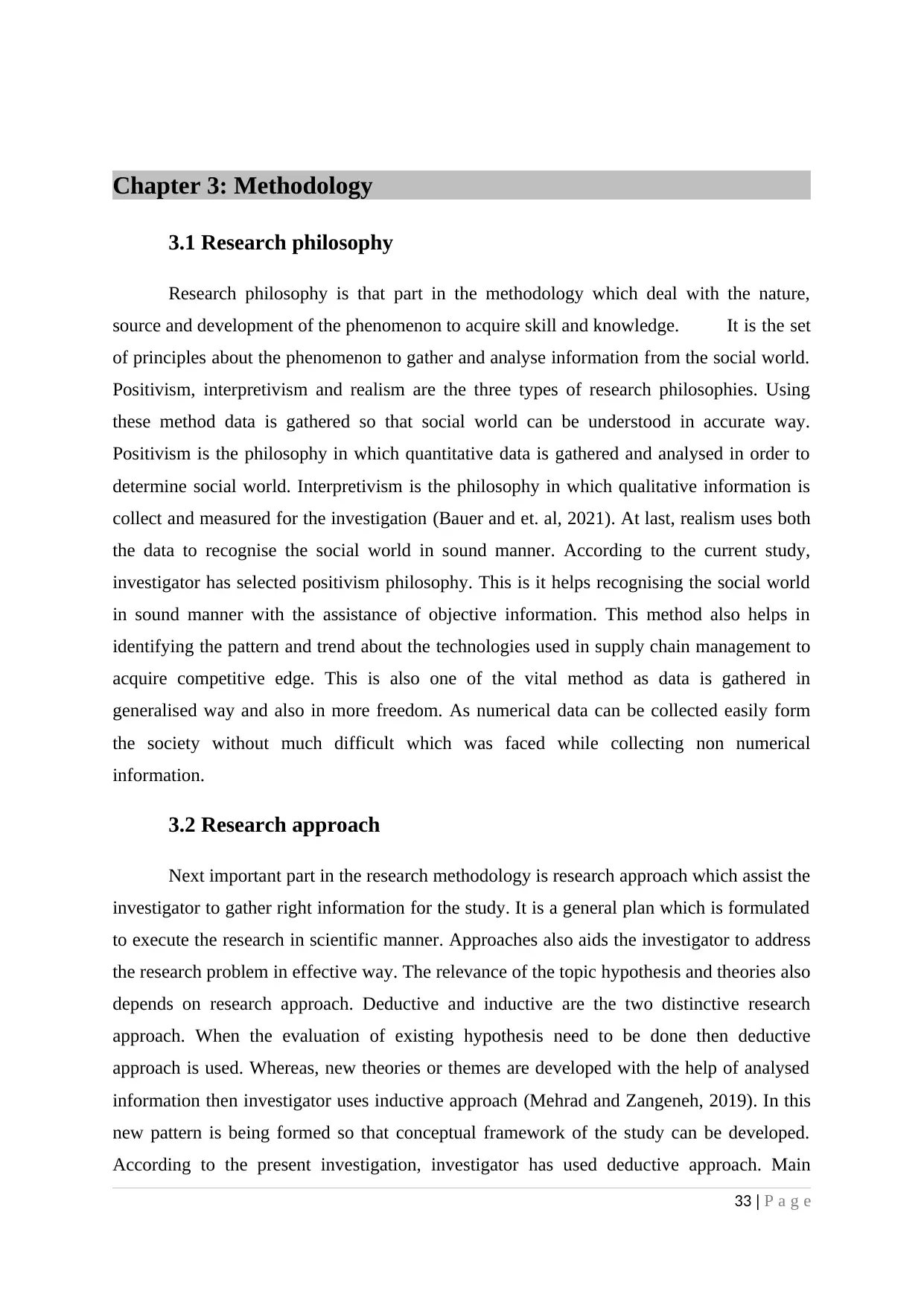
Chapter 3: Methodology
3.1 Research philosophy
Research philosophy is that part in the methodology which deal with the nature,
source and development of the phenomenon to acquire skill and knowledge. It is the set
of principles about the phenomenon to gather and analyse information from the social world.
Positivism, interpretivism and realism are the three types of research philosophies. Using
these method data is gathered so that social world can be understood in accurate way.
Positivism is the philosophy in which quantitative data is gathered and analysed in order to
determine social world. Interpretivism is the philosophy in which qualitative information is
collect and measured for the investigation (Bauer and et. al, 2021). At last, realism uses both
the data to recognise the social world in sound manner. According to the current study,
investigator has selected positivism philosophy. This is it helps recognising the social world
in sound manner with the assistance of objective information. This method also helps in
identifying the pattern and trend about the technologies used in supply chain management to
acquire competitive edge. This is also one of the vital method as data is gathered in
generalised way and also in more freedom. As numerical data can be collected easily form
the society without much difficult which was faced while collecting non numerical
information.
3.2 Research approach
Next important part in the research methodology is research approach which assist the
investigator to gather right information for the study. It is a general plan which is formulated
to execute the research in scientific manner. Approaches also aids the investigator to address
the research problem in effective way. The relevance of the topic hypothesis and theories also
depends on research approach. Deductive and inductive are the two distinctive research
approach. When the evaluation of existing hypothesis need to be done then deductive
approach is used. Whereas, new theories or themes are developed with the help of analysed
information then investigator uses inductive approach (Mehrad and Zangeneh, 2019). In this
new pattern is being formed so that conceptual framework of the study can be developed.
According to the present investigation, investigator has used deductive approach. Main
33 | P a g e
3.1 Research philosophy
Research philosophy is that part in the methodology which deal with the nature,
source and development of the phenomenon to acquire skill and knowledge. It is the set
of principles about the phenomenon to gather and analyse information from the social world.
Positivism, interpretivism and realism are the three types of research philosophies. Using
these method data is gathered so that social world can be understood in accurate way.
Positivism is the philosophy in which quantitative data is gathered and analysed in order to
determine social world. Interpretivism is the philosophy in which qualitative information is
collect and measured for the investigation (Bauer and et. al, 2021). At last, realism uses both
the data to recognise the social world in sound manner. According to the current study,
investigator has selected positivism philosophy. This is it helps recognising the social world
in sound manner with the assistance of objective information. This method also helps in
identifying the pattern and trend about the technologies used in supply chain management to
acquire competitive edge. This is also one of the vital method as data is gathered in
generalised way and also in more freedom. As numerical data can be collected easily form
the society without much difficult which was faced while collecting non numerical
information.
3.2 Research approach
Next important part in the research methodology is research approach which assist the
investigator to gather right information for the study. It is a general plan which is formulated
to execute the research in scientific manner. Approaches also aids the investigator to address
the research problem in effective way. The relevance of the topic hypothesis and theories also
depends on research approach. Deductive and inductive are the two distinctive research
approach. When the evaluation of existing hypothesis need to be done then deductive
approach is used. Whereas, new theories or themes are developed with the help of analysed
information then investigator uses inductive approach (Mehrad and Zangeneh, 2019). In this
new pattern is being formed so that conceptual framework of the study can be developed.
According to the present investigation, investigator has used deductive approach. Main
33 | P a g e

reason for this in the investigation is that research problem has been addressed with the aid of
quantitative information. Using numerical data problem or issue identified in the
investigation has addressed appropriately. As quantitative data is used to test the hypothesis
thus, a true picture for the investigation is accumulated. One of the main advantage to use
this approach is relationship between supply chain management techniques with competitive
edge can be identified easily.
3.3 Research strategy
Research strategy is step by step procedure which collects systematic data from the
applicants or from society about the topic. This part in the methodology helps the investigator
to gather right data by providing them the direction for their thoughts and opinion. Research
strategy also helps in accumulating quality data for the investigation so that aim and
objective can be attained accurately. Case study, survey, experimental research, action
research, systematic literature review, focused group, grounded theory and many other ae
some different kinds of strategies which can be used by the investigator for their study.
Survey is the method through which quantitative data can be extracted easily from large
population (Kurten and et. al, 2022). Case study is another method in which information is
gathered for the complex problem faced by the individual or group of individual in real life.
This method provides effective solution for the investigation. Action research is that type of
research strategy which solve the professional problem and provide data to know the
relationship between the problem and the solution. In the current research, researcher opt for
survey research strategy. This is because it gathers data for single time in less time and cost.
Data using this method is in number which helps in attaining aim and objective in more valid
manner. Data is gathered from large population thus mass information is being acquired for
the study (Fowler and Lapp, 2019).
3.4 Research methodology
Research methodology is systematic process which helps in identifying, analysing
and interpreting data for the investigation. It is that scientific procedure that helps the
investigator to gather right data for the study so that aim and objective can be attained
accurately. The readers as well as participants of the study is also interested in this section as
they will get to know about the validity and reliability of the study. One of the main motive
behind methodology section is that it aids in addressing the research problem accurately. This
34 | P a g e
quantitative information. Using numerical data problem or issue identified in the
investigation has addressed appropriately. As quantitative data is used to test the hypothesis
thus, a true picture for the investigation is accumulated. One of the main advantage to use
this approach is relationship between supply chain management techniques with competitive
edge can be identified easily.
3.3 Research strategy
Research strategy is step by step procedure which collects systematic data from the
applicants or from society about the topic. This part in the methodology helps the investigator
to gather right data by providing them the direction for their thoughts and opinion. Research
strategy also helps in accumulating quality data for the investigation so that aim and
objective can be attained accurately. Case study, survey, experimental research, action
research, systematic literature review, focused group, grounded theory and many other ae
some different kinds of strategies which can be used by the investigator for their study.
Survey is the method through which quantitative data can be extracted easily from large
population (Kurten and et. al, 2022). Case study is another method in which information is
gathered for the complex problem faced by the individual or group of individual in real life.
This method provides effective solution for the investigation. Action research is that type of
research strategy which solve the professional problem and provide data to know the
relationship between the problem and the solution. In the current research, researcher opt for
survey research strategy. This is because it gathers data for single time in less time and cost.
Data using this method is in number which helps in attaining aim and objective in more valid
manner. Data is gathered from large population thus mass information is being acquired for
the study (Fowler and Lapp, 2019).
3.4 Research methodology
Research methodology is systematic process which helps in identifying, analysing
and interpreting data for the investigation. It is that scientific procedure that helps the
investigator to gather right data for the study so that aim and objective can be attained
accurately. The readers as well as participants of the study is also interested in this section as
they will get to know about the validity and reliability of the study. One of the main motive
behind methodology section is that it aids in addressing the research problem accurately. This
34 | P a g e
Secure Best Marks with AI Grader
Need help grading? Try our AI Grader for instant feedback on your assignments.
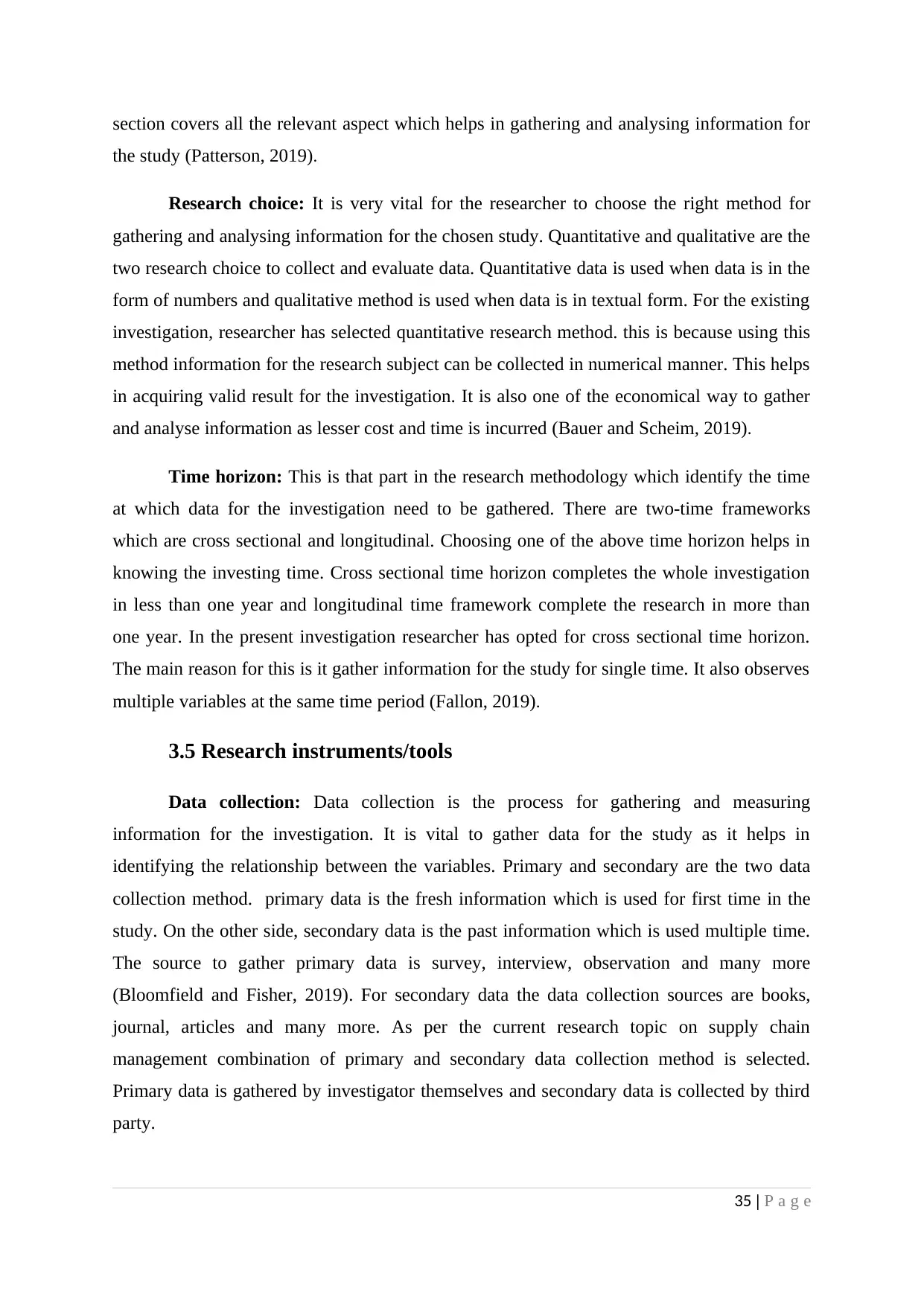
section covers all the relevant aspect which helps in gathering and analysing information for
the study (Patterson, 2019).
Research choice: It is very vital for the researcher to choose the right method for
gathering and analysing information for the chosen study. Quantitative and qualitative are the
two research choice to collect and evaluate data. Quantitative data is used when data is in the
form of numbers and qualitative method is used when data is in textual form. For the existing
investigation, researcher has selected quantitative research method. this is because using this
method information for the research subject can be collected in numerical manner. This helps
in acquiring valid result for the investigation. It is also one of the economical way to gather
and analyse information as lesser cost and time is incurred (Bauer and Scheim, 2019).
Time horizon: This is that part in the research methodology which identify the time
at which data for the investigation need to be gathered. There are two-time frameworks
which are cross sectional and longitudinal. Choosing one of the above time horizon helps in
knowing the investing time. Cross sectional time horizon completes the whole investigation
in less than one year and longitudinal time framework complete the research in more than
one year. In the present investigation researcher has opted for cross sectional time horizon.
The main reason for this is it gather information for the study for single time. It also observes
multiple variables at the same time period (Fallon, 2019).
3.5 Research instruments/tools
Data collection: Data collection is the process for gathering and measuring
information for the investigation. It is vital to gather data for the study as it helps in
identifying the relationship between the variables. Primary and secondary are the two data
collection method. primary data is the fresh information which is used for first time in the
study. On the other side, secondary data is the past information which is used multiple time.
The source to gather primary data is survey, interview, observation and many more
(Bloomfield and Fisher, 2019). For secondary data the data collection sources are books,
journal, articles and many more. As per the current research topic on supply chain
management combination of primary and secondary data collection method is selected.
Primary data is gathered by investigator themselves and secondary data is collected by third
party.
35 | P a g e
the study (Patterson, 2019).
Research choice: It is very vital for the researcher to choose the right method for
gathering and analysing information for the chosen study. Quantitative and qualitative are the
two research choice to collect and evaluate data. Quantitative data is used when data is in the
form of numbers and qualitative method is used when data is in textual form. For the existing
investigation, researcher has selected quantitative research method. this is because using this
method information for the research subject can be collected in numerical manner. This helps
in acquiring valid result for the investigation. It is also one of the economical way to gather
and analyse information as lesser cost and time is incurred (Bauer and Scheim, 2019).
Time horizon: This is that part in the research methodology which identify the time
at which data for the investigation need to be gathered. There are two-time frameworks
which are cross sectional and longitudinal. Choosing one of the above time horizon helps in
knowing the investing time. Cross sectional time horizon completes the whole investigation
in less than one year and longitudinal time framework complete the research in more than
one year. In the present investigation researcher has opted for cross sectional time horizon.
The main reason for this is it gather information for the study for single time. It also observes
multiple variables at the same time period (Fallon, 2019).
3.5 Research instruments/tools
Data collection: Data collection is the process for gathering and measuring
information for the investigation. It is vital to gather data for the study as it helps in
identifying the relationship between the variables. Primary and secondary are the two data
collection method. primary data is the fresh information which is used for first time in the
study. On the other side, secondary data is the past information which is used multiple time.
The source to gather primary data is survey, interview, observation and many more
(Bloomfield and Fisher, 2019). For secondary data the data collection sources are books,
journal, articles and many more. As per the current research topic on supply chain
management combination of primary and secondary data collection method is selected.
Primary data is gathered by investigator themselves and secondary data is collected by third
party.
35 | P a g e
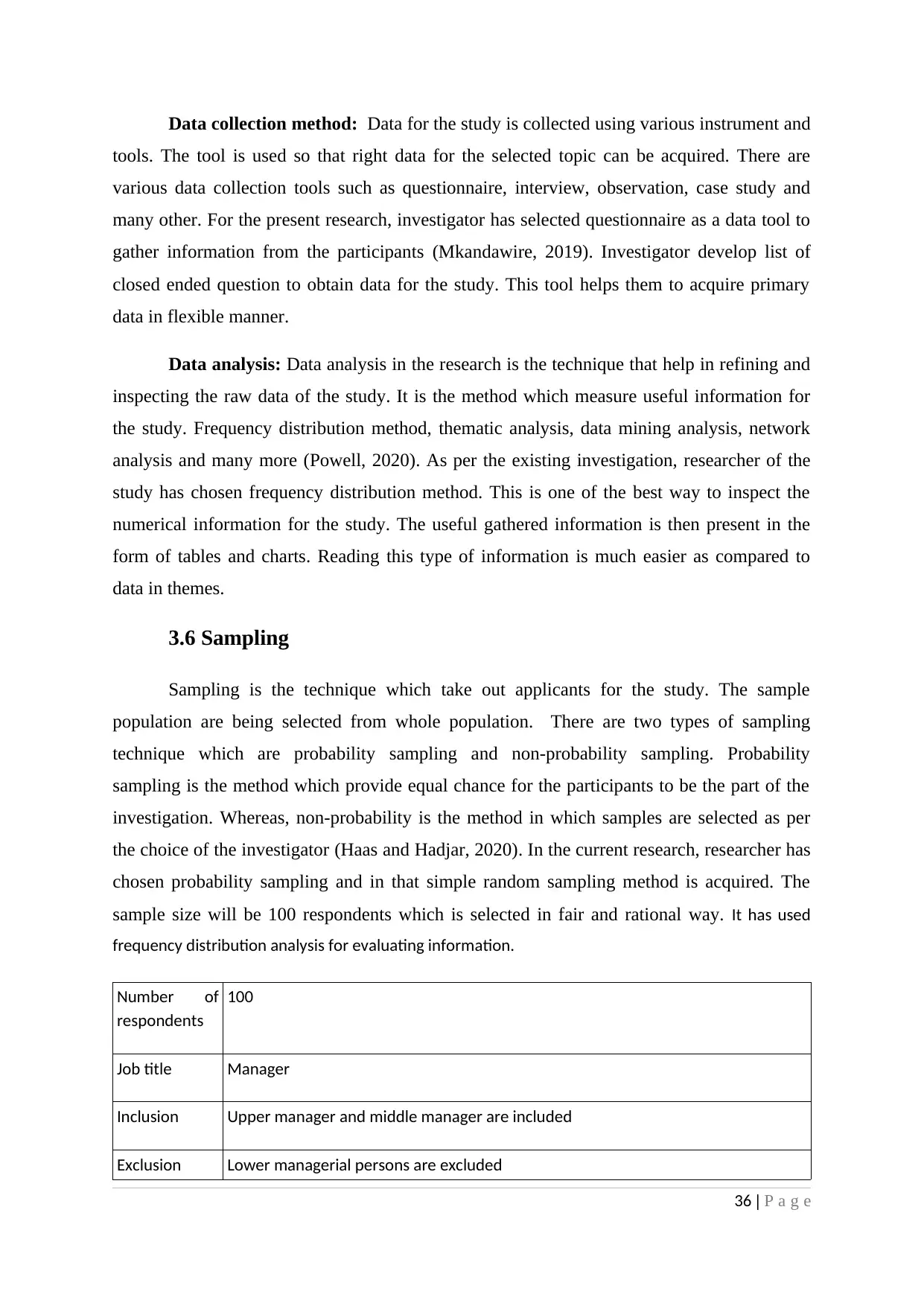
Data collection method: Data for the study is collected using various instrument and
tools. The tool is used so that right data for the selected topic can be acquired. There are
various data collection tools such as questionnaire, interview, observation, case study and
many other. For the present research, investigator has selected questionnaire as a data tool to
gather information from the participants (Mkandawire, 2019). Investigator develop list of
closed ended question to obtain data for the study. This tool helps them to acquire primary
data in flexible manner.
Data analysis: Data analysis in the research is the technique that help in refining and
inspecting the raw data of the study. It is the method which measure useful information for
the study. Frequency distribution method, thematic analysis, data mining analysis, network
analysis and many more (Powell, 2020). As per the existing investigation, researcher of the
study has chosen frequency distribution method. This is one of the best way to inspect the
numerical information for the study. The useful gathered information is then present in the
form of tables and charts. Reading this type of information is much easier as compared to
data in themes.
3.6 Sampling
Sampling is the technique which take out applicants for the study. The sample
population are being selected from whole population. There are two types of sampling
technique which are probability sampling and non-probability sampling. Probability
sampling is the method which provide equal chance for the participants to be the part of the
investigation. Whereas, non-probability is the method in which samples are selected as per
the choice of the investigator (Haas and Hadjar, 2020). In the current research, researcher has
chosen probability sampling and in that simple random sampling method is acquired. The
sample size will be 100 respondents which is selected in fair and rational way. It has used
frequency distribution analysis for evaluating information.
Number of
respondents
100
Job title Manager
Inclusion Upper manager and middle manager are included
Exclusion Lower managerial persons are excluded
36 | P a g e
tools. The tool is used so that right data for the selected topic can be acquired. There are
various data collection tools such as questionnaire, interview, observation, case study and
many other. For the present research, investigator has selected questionnaire as a data tool to
gather information from the participants (Mkandawire, 2019). Investigator develop list of
closed ended question to obtain data for the study. This tool helps them to acquire primary
data in flexible manner.
Data analysis: Data analysis in the research is the technique that help in refining and
inspecting the raw data of the study. It is the method which measure useful information for
the study. Frequency distribution method, thematic analysis, data mining analysis, network
analysis and many more (Powell, 2020). As per the existing investigation, researcher of the
study has chosen frequency distribution method. This is one of the best way to inspect the
numerical information for the study. The useful gathered information is then present in the
form of tables and charts. Reading this type of information is much easier as compared to
data in themes.
3.6 Sampling
Sampling is the technique which take out applicants for the study. The sample
population are being selected from whole population. There are two types of sampling
technique which are probability sampling and non-probability sampling. Probability
sampling is the method which provide equal chance for the participants to be the part of the
investigation. Whereas, non-probability is the method in which samples are selected as per
the choice of the investigator (Haas and Hadjar, 2020). In the current research, researcher has
chosen probability sampling and in that simple random sampling method is acquired. The
sample size will be 100 respondents which is selected in fair and rational way. It has used
frequency distribution analysis for evaluating information.
Number of
respondents
100
Job title Manager
Inclusion Upper manager and middle manager are included
Exclusion Lower managerial persons are excluded
36 | P a g e

3.6 Ethical implications
Ethics are the values and principle which are followed by the investigator while
gathering information. It is necessary to obey belief as it aid in collecting data in societal
manner. Some of the ethics which are followed in the present research are:
Credibility: Researcher should give credit to other researcher or author whose data
they have used in the investigation. This is because it helps them to reduce vicious conduct
(Barrow, Brannan and Khandhar, 2021).
Informed consent form: Another ethic which is obeyed is acquiring informed
consent to the participants. Researcher should provide each detail of the investigation and get
voluntarily participants.
CONCLUSION OF RESEARCH METHODOLOGY
From the above chapter of methodology, it is concluded that the chosen research method for the
present investigation is quantitative research method. The method is selected as it gathers
numerical data for the study which helps in attaining valid result for the research. The philosophy
which is used to gather information is positivism and the approach to address the research problem
is deductive. To gather quantitative data research strategy that is used by the investigator is survey.
The main reason for choosing this is it gathers mass numerical data from pool of applicant. The data
collection source for the existing research is both primary and secondary. Using primary investigator
extract fresh data so that real time investigation is done. Whereas, secondary data helps them to
know the perception of different researcher on the topic. In secondary source past data is used to
gain more knowledge on the topic. The data collection instrument is questionnaire and the sampling
method is probability sampling. The sample size for the present investigation is 100 respondents.
Objective Question covered
Objective 1 Q1, 2, 4, 5,6
Objective 2 Q3, 7
Objective 3 Q9, 10
Objective 4 Q8
37 | P a g e
Ethics are the values and principle which are followed by the investigator while
gathering information. It is necessary to obey belief as it aid in collecting data in societal
manner. Some of the ethics which are followed in the present research are:
Credibility: Researcher should give credit to other researcher or author whose data
they have used in the investigation. This is because it helps them to reduce vicious conduct
(Barrow, Brannan and Khandhar, 2021).
Informed consent form: Another ethic which is obeyed is acquiring informed
consent to the participants. Researcher should provide each detail of the investigation and get
voluntarily participants.
CONCLUSION OF RESEARCH METHODOLOGY
From the above chapter of methodology, it is concluded that the chosen research method for the
present investigation is quantitative research method. The method is selected as it gathers
numerical data for the study which helps in attaining valid result for the research. The philosophy
which is used to gather information is positivism and the approach to address the research problem
is deductive. To gather quantitative data research strategy that is used by the investigator is survey.
The main reason for choosing this is it gathers mass numerical data from pool of applicant. The data
collection source for the existing research is both primary and secondary. Using primary investigator
extract fresh data so that real time investigation is done. Whereas, secondary data helps them to
know the perception of different researcher on the topic. In secondary source past data is used to
gain more knowledge on the topic. The data collection instrument is questionnaire and the sampling
method is probability sampling. The sample size for the present investigation is 100 respondents.
Objective Question covered
Objective 1 Q1, 2, 4, 5,6
Objective 2 Q3, 7
Objective 3 Q9, 10
Objective 4 Q8
37 | P a g e
Paraphrase This Document
Need a fresh take? Get an instant paraphrase of this document with our AI Paraphraser

38 | P a g e
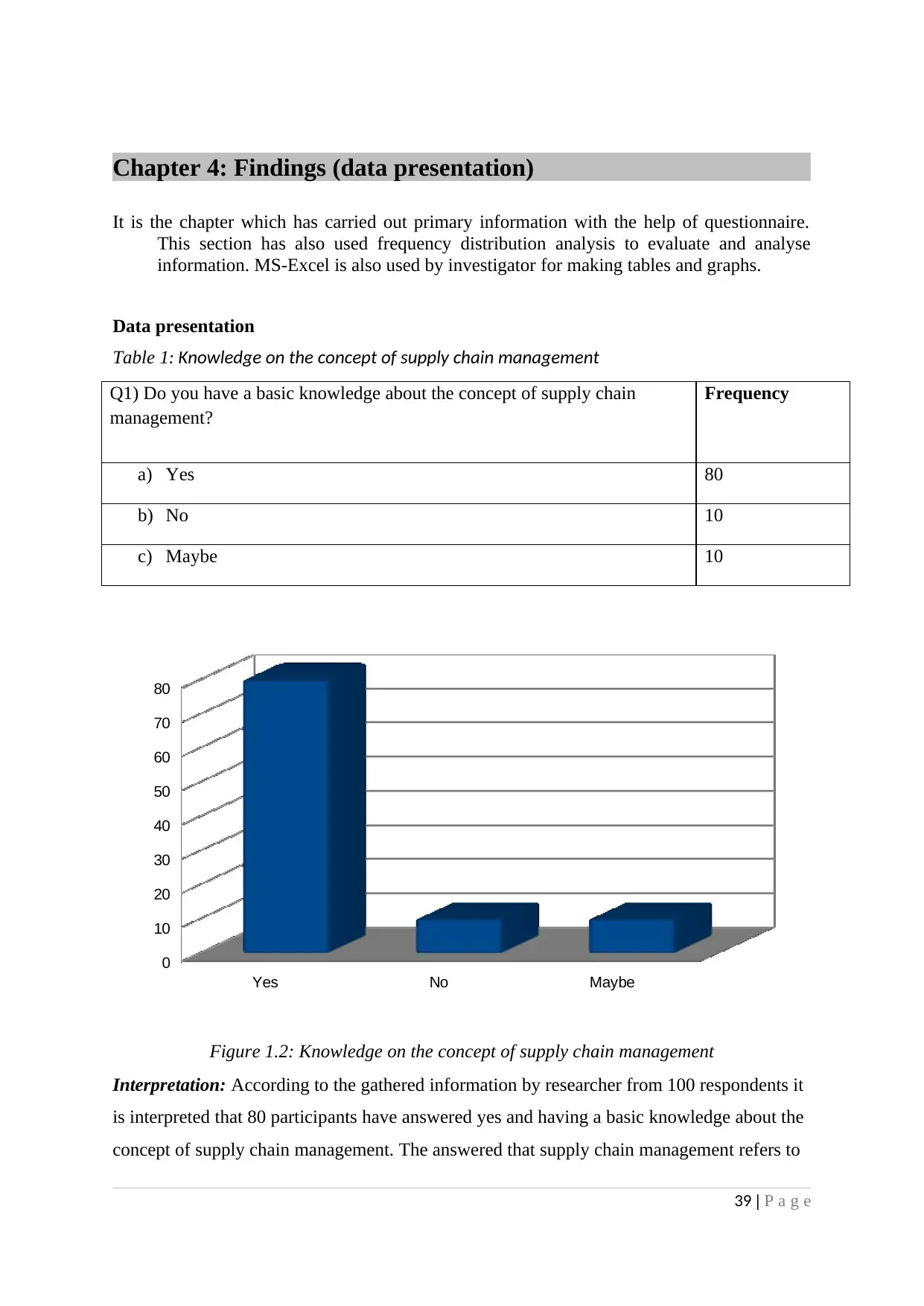
Chapter 4: Findings (data presentation)
It is the chapter which has carried out primary information with the help of questionnaire.
This section has also used frequency distribution analysis to evaluate and analyse
information. MS-Excel is also used by investigator for making tables and graphs.
Data presentation
Table 1: Knowledge on the concept of supply chain management
Q1) Do you have a basic knowledge about the concept of supply chain
management?
Frequency
a) Yes 80
b) No 10
c) Maybe 10
Yes No Maybe
0
10
20
30
40
50
60
70
80
Figure 1.2: Knowledge on the concept of supply chain management
Interpretation: According to the gathered information by researcher from 100 respondents it
is interpreted that 80 participants have answered yes and having a basic knowledge about the
concept of supply chain management. The answered that supply chain management refers to
39 | P a g e
It is the chapter which has carried out primary information with the help of questionnaire.
This section has also used frequency distribution analysis to evaluate and analyse
information. MS-Excel is also used by investigator for making tables and graphs.
Data presentation
Table 1: Knowledge on the concept of supply chain management
Q1) Do you have a basic knowledge about the concept of supply chain
management?
Frequency
a) Yes 80
b) No 10
c) Maybe 10
Yes No Maybe
0
10
20
30
40
50
60
70
80
Figure 1.2: Knowledge on the concept of supply chain management
Interpretation: According to the gathered information by researcher from 100 respondents it
is interpreted that 80 participants have answered yes and having a basic knowledge about the
concept of supply chain management. The answered that supply chain management refers to
39 | P a g e
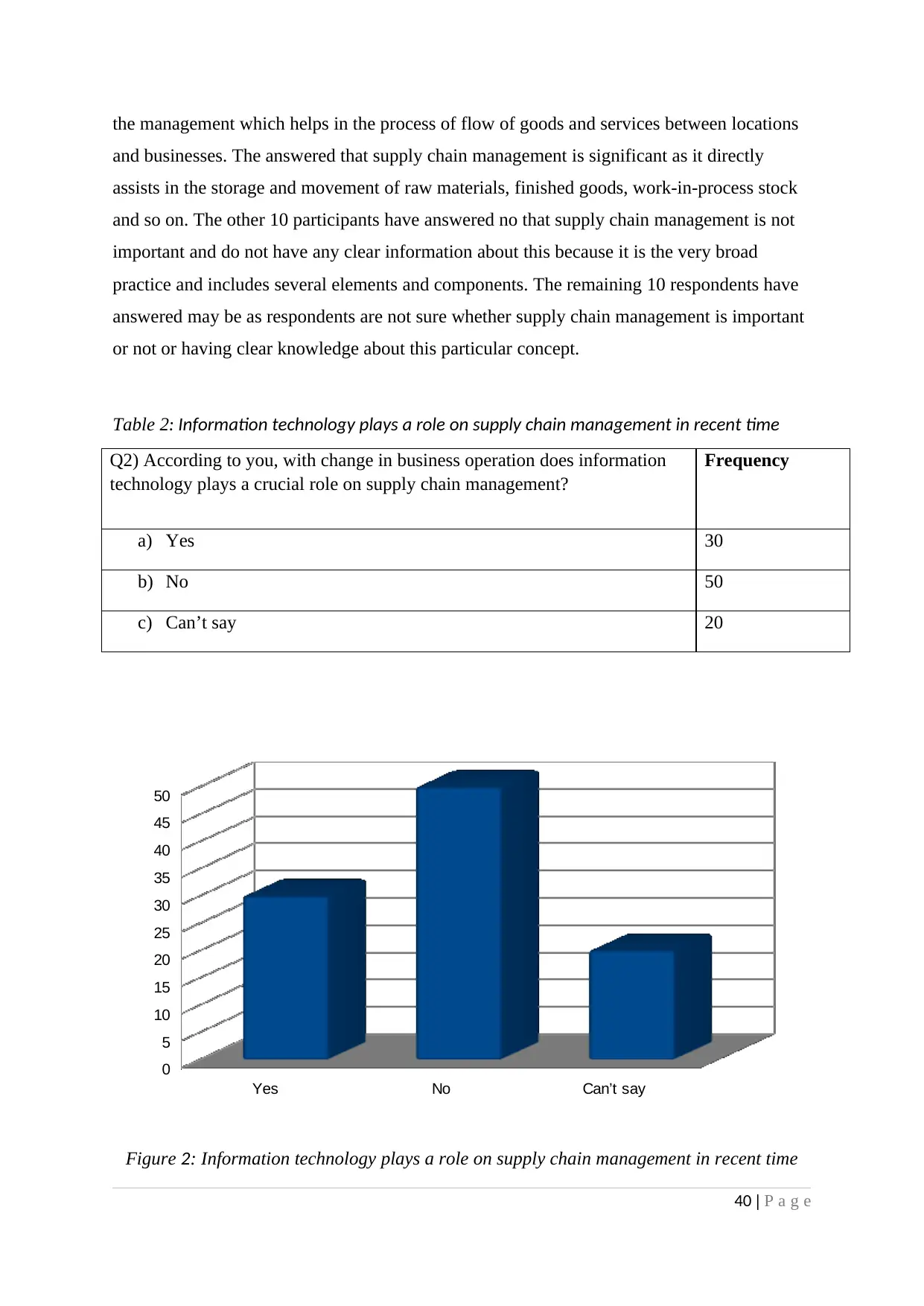
the management which helps in the process of flow of goods and services between locations
and businesses. The answered that supply chain management is significant as it directly
assists in the storage and movement of raw materials, finished goods, work-in-process stock
and so on. The other 10 participants have answered no that supply chain management is not
important and do not have any clear information about this because it is the very broad
practice and includes several elements and components. The remaining 10 respondents have
answered may be as respondents are not sure whether supply chain management is important
or not or having clear knowledge about this particular concept.
Table 2: Information technology plays a role on supply chain management in recent time
Q2) According to you, with change in business operation does information
technology plays a crucial role on supply chain management?
Frequency
a) Yes 30
b) No 50
c) Can’t say 20
Yes No Can’t say
0
5
10
15
20
25
30
35
40
45
50
Figure 2: Information technology plays a role on supply chain management in recent time
40 | P a g e
and businesses. The answered that supply chain management is significant as it directly
assists in the storage and movement of raw materials, finished goods, work-in-process stock
and so on. The other 10 participants have answered no that supply chain management is not
important and do not have any clear information about this because it is the very broad
practice and includes several elements and components. The remaining 10 respondents have
answered may be as respondents are not sure whether supply chain management is important
or not or having clear knowledge about this particular concept.
Table 2: Information technology plays a role on supply chain management in recent time
Q2) According to you, with change in business operation does information
technology plays a crucial role on supply chain management?
Frequency
a) Yes 30
b) No 50
c) Can’t say 20
Yes No Can’t say
0
5
10
15
20
25
30
35
40
45
50
Figure 2: Information technology plays a role on supply chain management in recent time
40 | P a g e
Secure Best Marks with AI Grader
Need help grading? Try our AI Grader for instant feedback on your assignments.
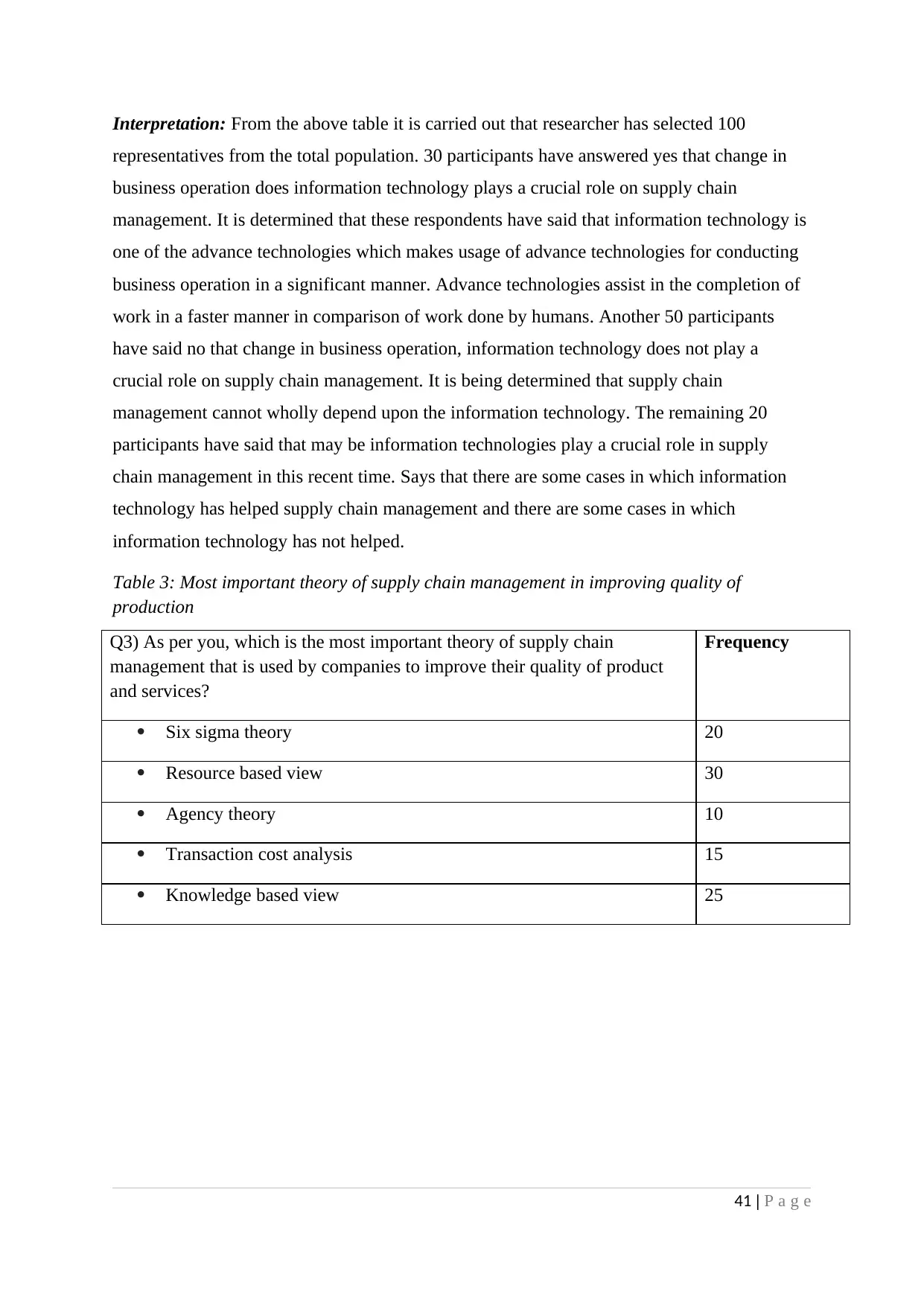
Interpretation: From the above table it is carried out that researcher has selected 100
representatives from the total population. 30 participants have answered yes that change in
business operation does information technology plays a crucial role on supply chain
management. It is determined that these respondents have said that information technology is
one of the advance technologies which makes usage of advance technologies for conducting
business operation in a significant manner. Advance technologies assist in the completion of
work in a faster manner in comparison of work done by humans. Another 50 participants
have said no that change in business operation, information technology does not play a
crucial role on supply chain management. It is being determined that supply chain
management cannot wholly depend upon the information technology. The remaining 20
participants have said that may be information technologies play a crucial role in supply
chain management in this recent time. Says that there are some cases in which information
technology has helped supply chain management and there are some cases in which
information technology has not helped.
Table 3: Most important theory of supply chain management in improving quality of
production
Q3) As per you, which is the most important theory of supply chain
management that is used by companies to improve their quality of product
and services?
Frequency
Six sigma theory 20
Resource based view 30
Agency theory 10
Transaction cost analysis 15
Knowledge based view 25
41 | P a g e
representatives from the total population. 30 participants have answered yes that change in
business operation does information technology plays a crucial role on supply chain
management. It is determined that these respondents have said that information technology is
one of the advance technologies which makes usage of advance technologies for conducting
business operation in a significant manner. Advance technologies assist in the completion of
work in a faster manner in comparison of work done by humans. Another 50 participants
have said no that change in business operation, information technology does not play a
crucial role on supply chain management. It is being determined that supply chain
management cannot wholly depend upon the information technology. The remaining 20
participants have said that may be information technologies play a crucial role in supply
chain management in this recent time. Says that there are some cases in which information
technology has helped supply chain management and there are some cases in which
information technology has not helped.
Table 3: Most important theory of supply chain management in improving quality of
production
Q3) As per you, which is the most important theory of supply chain
management that is used by companies to improve their quality of product
and services?
Frequency
Six sigma theory 20
Resource based view 30
Agency theory 10
Transaction cost analysis 15
Knowledge based view 25
41 | P a g e

Six sigma theory
Resource based view
Agency theory
Transaction cost analysis
Knowledge based view
0
5
10
15
20
25
30
20
30
10
15
25
Figure 3: Most important theory of supply chain management in improving quality of
production
Interpretation: According to the assembled data, it is analysed that 20 participants have
answered that six sigma theory is the most significant theory of supply chain management
that is used by companies to improve their quality of product and services. It is being
analysed that with the assistance of this investigation that six sigma’s is one of the methods
that give companies tools for improving the capability of the business procedures. It is the
theory which assists in increasing the performance and decreasing the procedure variation
assists lead to mistakes reduction and increases level of profit and motivation level of
employees. The other 30 participants have answered that resource based view is the other
significant theory because it helps in determining the strategic resources an organisation can
use for achieving sustainable competitive advantage. Another 10 participants have said that
agency theory is the important theory because this get support from higher agencies to carry
out work through heavy machineries. The other 15 representatives have answered that
transaction cost analysis is one of the studies through which trade prices are identified for
comparing with the earlier results and outcomes. The remaining 25 respondents have
answered that knowledge based view is the other significant theory because it is a concept of
organisational learning that gives companies with relevant strategies to gain competitive
edge.
42 | P a g e
Resource based view
Agency theory
Transaction cost analysis
Knowledge based view
0
5
10
15
20
25
30
20
30
10
15
25
Figure 3: Most important theory of supply chain management in improving quality of
production
Interpretation: According to the assembled data, it is analysed that 20 participants have
answered that six sigma theory is the most significant theory of supply chain management
that is used by companies to improve their quality of product and services. It is being
analysed that with the assistance of this investigation that six sigma’s is one of the methods
that give companies tools for improving the capability of the business procedures. It is the
theory which assists in increasing the performance and decreasing the procedure variation
assists lead to mistakes reduction and increases level of profit and motivation level of
employees. The other 30 participants have answered that resource based view is the other
significant theory because it helps in determining the strategic resources an organisation can
use for achieving sustainable competitive advantage. Another 10 participants have said that
agency theory is the important theory because this get support from higher agencies to carry
out work through heavy machineries. The other 15 representatives have answered that
transaction cost analysis is one of the studies through which trade prices are identified for
comparing with the earlier results and outcomes. The remaining 25 respondents have
answered that knowledge based view is the other significant theory because it is a concept of
organisational learning that gives companies with relevant strategies to gain competitive
edge.
42 | P a g e
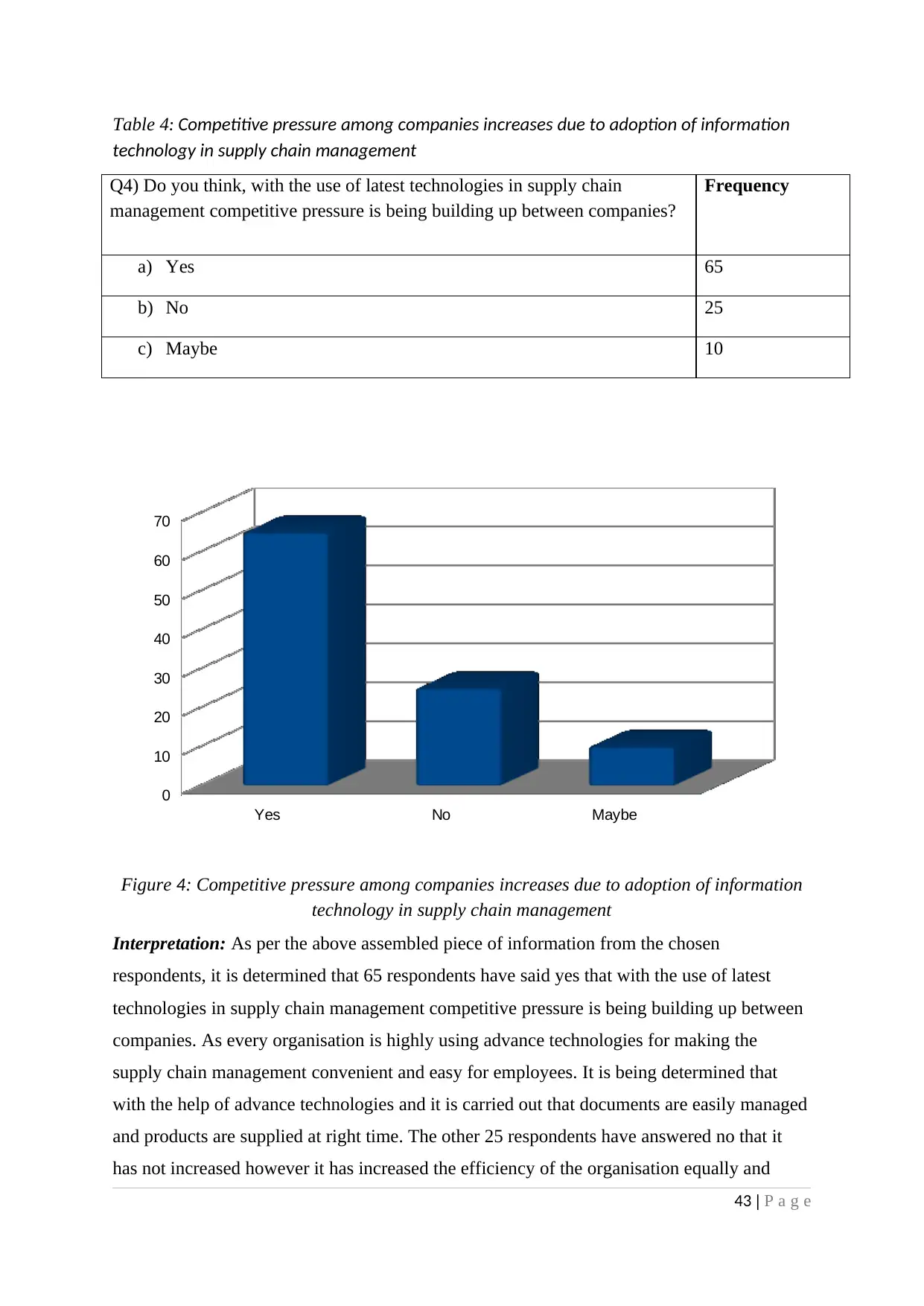
Table 4: Competitive pressure among companies increases due to adoption of information
technology in supply chain management
Q4) Do you think, with the use of latest technologies in supply chain
management competitive pressure is being building up between companies?
Frequency
a) Yes 65
b) No 25
c) Maybe 10
Yes No Maybe
0
10
20
30
40
50
60
70
Figure 4: Competitive pressure among companies increases due to adoption of information
technology in supply chain management
Interpretation: As per the above assembled piece of information from the chosen
respondents, it is determined that 65 respondents have said yes that with the use of latest
technologies in supply chain management competitive pressure is being building up between
companies. As every organisation is highly using advance technologies for making the
supply chain management convenient and easy for employees. It is being determined that
with the help of advance technologies and it is carried out that documents are easily managed
and products are supplied at right time. The other 25 respondents have answered no that it
has not increased however it has increased the efficiency of the organisation equally and
43 | P a g e
technology in supply chain management
Q4) Do you think, with the use of latest technologies in supply chain
management competitive pressure is being building up between companies?
Frequency
a) Yes 65
b) No 25
c) Maybe 10
Yes No Maybe
0
10
20
30
40
50
60
70
Figure 4: Competitive pressure among companies increases due to adoption of information
technology in supply chain management
Interpretation: As per the above assembled piece of information from the chosen
respondents, it is determined that 65 respondents have said yes that with the use of latest
technologies in supply chain management competitive pressure is being building up between
companies. As every organisation is highly using advance technologies for making the
supply chain management convenient and easy for employees. It is being determined that
with the help of advance technologies and it is carried out that documents are easily managed
and products are supplied at right time. The other 25 respondents have answered no that it
has not increased however it has increased the efficiency of the organisation equally and
43 | P a g e
Paraphrase This Document
Need a fresh take? Get an instant paraphrase of this document with our AI Paraphraser
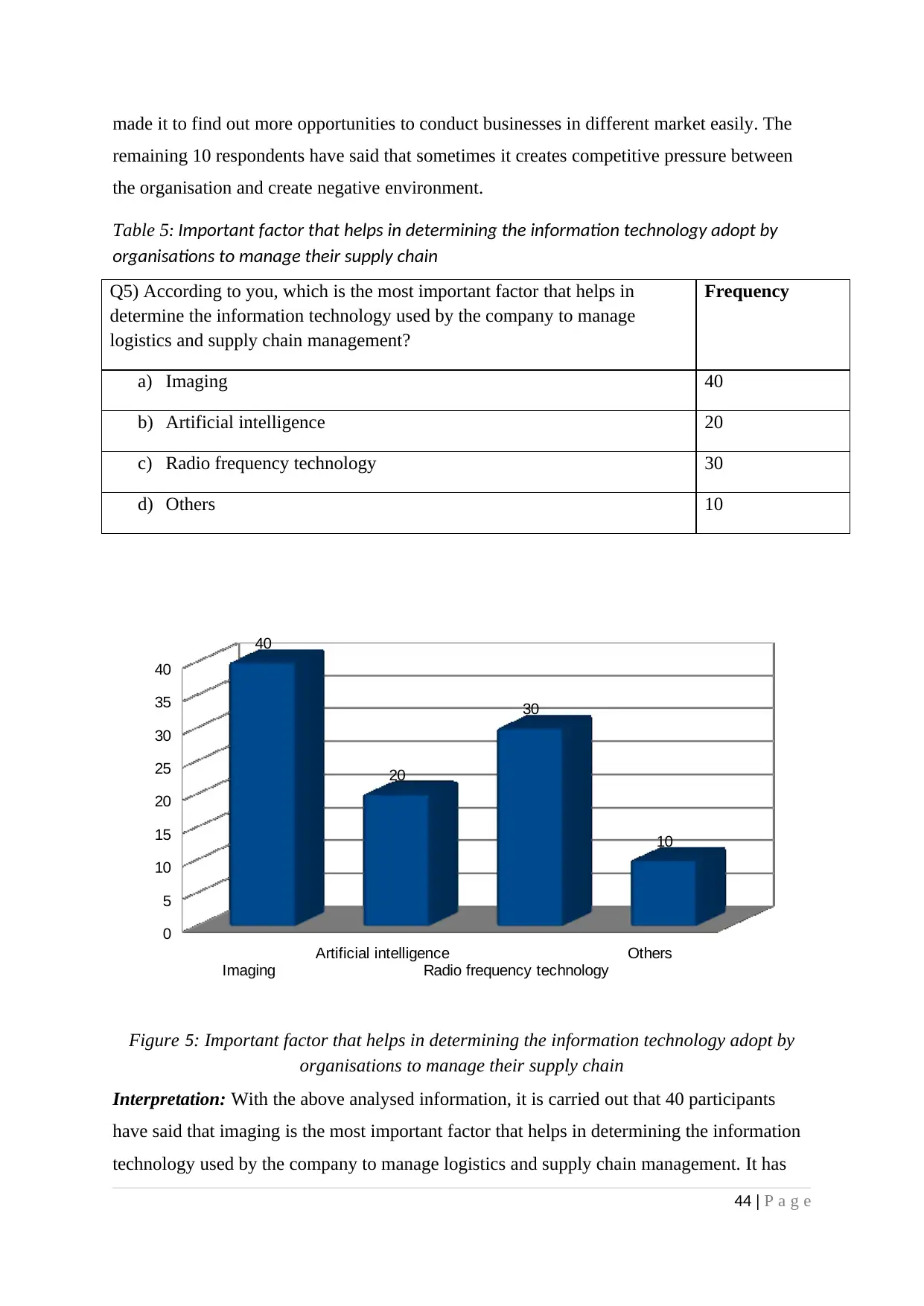
made it to find out more opportunities to conduct businesses in different market easily. The
remaining 10 respondents have said that sometimes it creates competitive pressure between
the organisation and create negative environment.
Table 5: Important factor that helps in determining the information technology adopt by
organisations to manage their supply chain
Q5) According to you, which is the most important factor that helps in
determine the information technology used by the company to manage
logistics and supply chain management?
Frequency
a) Imaging 40
b) Artificial intelligence 20
c) Radio frequency technology 30
d) Others 10
Imaging
Artificial intelligence
Radio frequency technology
Others
0
5
10
15
20
25
30
35
40
40
20
30
10
Figure 5: Important factor that helps in determining the information technology adopt by
organisations to manage their supply chain
Interpretation: With the above analysed information, it is carried out that 40 participants
have said that imaging is the most important factor that helps in determining the information
technology used by the company to manage logistics and supply chain management. It has
44 | P a g e
remaining 10 respondents have said that sometimes it creates competitive pressure between
the organisation and create negative environment.
Table 5: Important factor that helps in determining the information technology adopt by
organisations to manage their supply chain
Q5) According to you, which is the most important factor that helps in
determine the information technology used by the company to manage
logistics and supply chain management?
Frequency
a) Imaging 40
b) Artificial intelligence 20
c) Radio frequency technology 30
d) Others 10
Imaging
Artificial intelligence
Radio frequency technology
Others
0
5
10
15
20
25
30
35
40
40
20
30
10
Figure 5: Important factor that helps in determining the information technology adopt by
organisations to manage their supply chain
Interpretation: With the above analysed information, it is carried out that 40 participants
have said that imaging is the most important factor that helps in determining the information
technology used by the company to manage logistics and supply chain management. It has
44 | P a g e
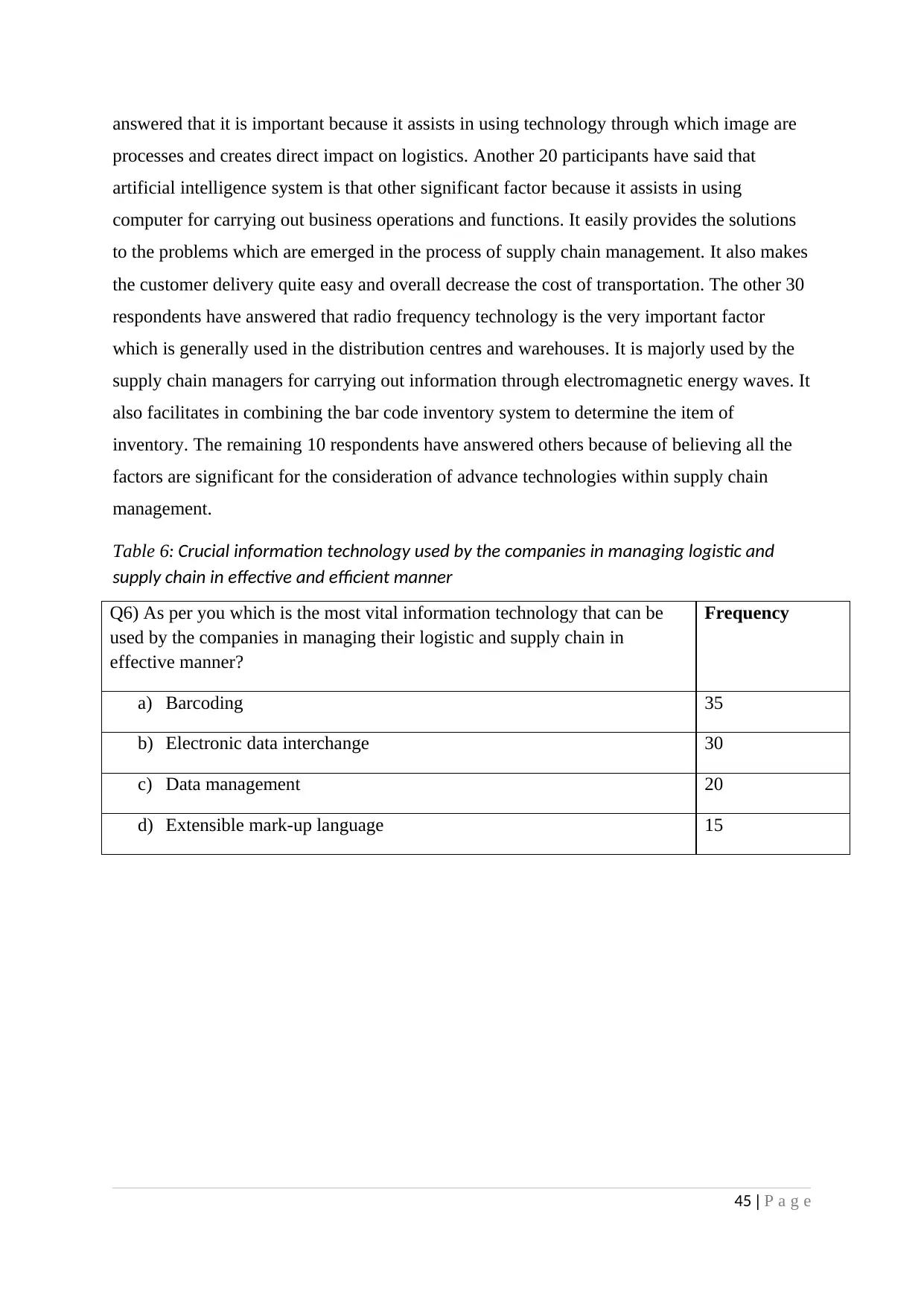
answered that it is important because it assists in using technology through which image are
processes and creates direct impact on logistics. Another 20 participants have said that
artificial intelligence system is that other significant factor because it assists in using
computer for carrying out business operations and functions. It easily provides the solutions
to the problems which are emerged in the process of supply chain management. It also makes
the customer delivery quite easy and overall decrease the cost of transportation. The other 30
respondents have answered that radio frequency technology is the very important factor
which is generally used in the distribution centres and warehouses. It is majorly used by the
supply chain managers for carrying out information through electromagnetic energy waves. It
also facilitates in combining the bar code inventory system to determine the item of
inventory. The remaining 10 respondents have answered others because of believing all the
factors are significant for the consideration of advance technologies within supply chain
management.
Table 6: Crucial information technology used by the companies in managing logistic and
supply chain in effective and efficient manner
Q6) As per you which is the most vital information technology that can be
used by the companies in managing their logistic and supply chain in
effective manner?
Frequency
a) Barcoding 35
b) Electronic data interchange 30
c) Data management 20
d) Extensible mark-up language 15
45 | P a g e
processes and creates direct impact on logistics. Another 20 participants have said that
artificial intelligence system is that other significant factor because it assists in using
computer for carrying out business operations and functions. It easily provides the solutions
to the problems which are emerged in the process of supply chain management. It also makes
the customer delivery quite easy and overall decrease the cost of transportation. The other 30
respondents have answered that radio frequency technology is the very important factor
which is generally used in the distribution centres and warehouses. It is majorly used by the
supply chain managers for carrying out information through electromagnetic energy waves. It
also facilitates in combining the bar code inventory system to determine the item of
inventory. The remaining 10 respondents have answered others because of believing all the
factors are significant for the consideration of advance technologies within supply chain
management.
Table 6: Crucial information technology used by the companies in managing logistic and
supply chain in effective and efficient manner
Q6) As per you which is the most vital information technology that can be
used by the companies in managing their logistic and supply chain in
effective manner?
Frequency
a) Barcoding 35
b) Electronic data interchange 30
c) Data management 20
d) Extensible mark-up language 15
45 | P a g e
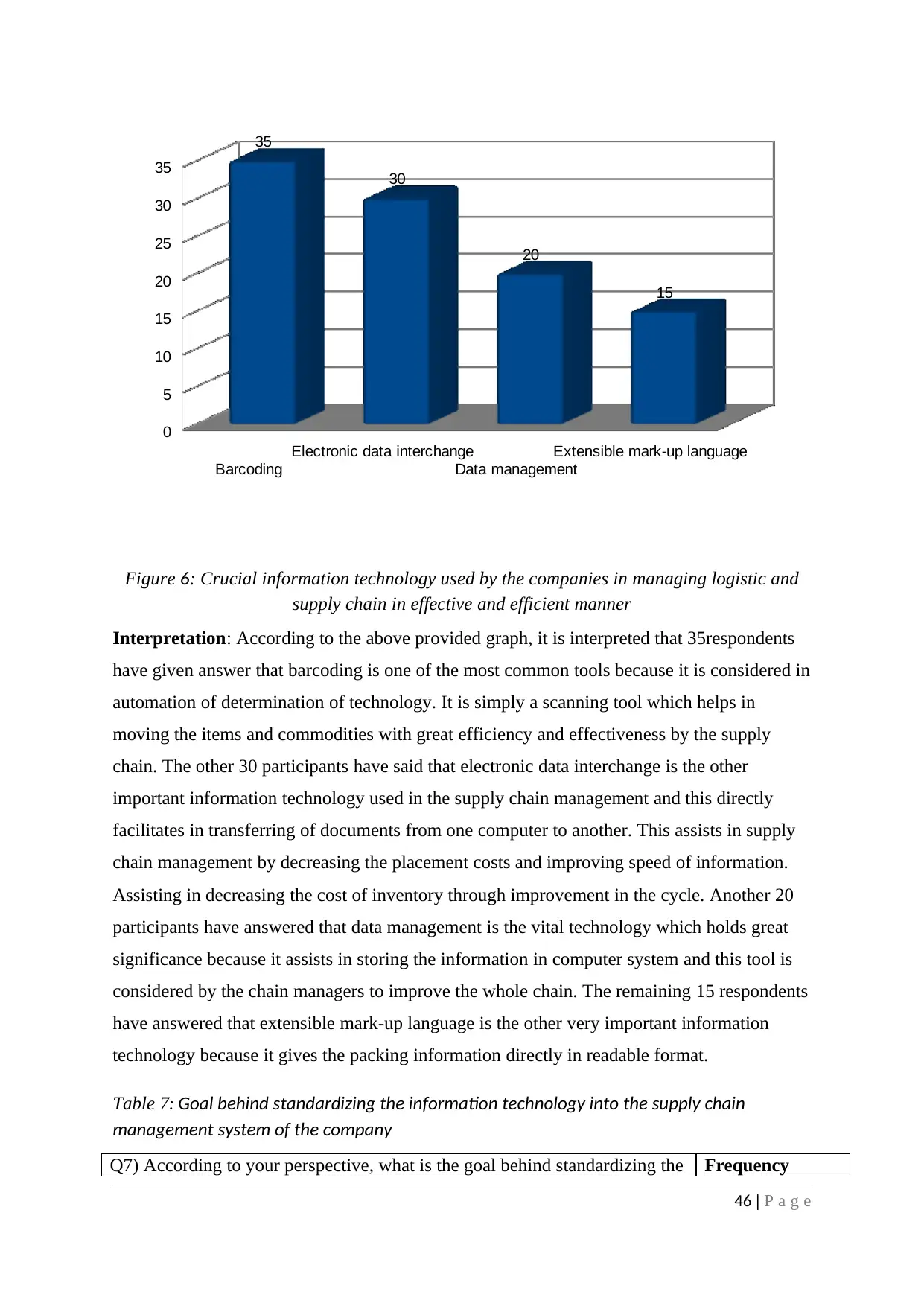
Barcoding
Electronic data interchange
Data management
Extensible mark-up language
0
5
10
15
20
25
30
35
35
30
20
15
Figure 6: Crucial information technology used by the companies in managing logistic and
supply chain in effective and efficient manner
Interpretation: According to the above provided graph, it is interpreted that 35respondents
have given answer that barcoding is one of the most common tools because it is considered in
automation of determination of technology. It is simply a scanning tool which helps in
moving the items and commodities with great efficiency and effectiveness by the supply
chain. The other 30 participants have said that electronic data interchange is the other
important information technology used in the supply chain management and this directly
facilitates in transferring of documents from one computer to another. This assists in supply
chain management by decreasing the placement costs and improving speed of information.
Assisting in decreasing the cost of inventory through improvement in the cycle. Another 20
participants have answered that data management is the vital technology which holds great
significance because it assists in storing the information in computer system and this tool is
considered by the chain managers to improve the whole chain. The remaining 15 respondents
have answered that extensible mark-up language is the other very important information
technology because it gives the packing information directly in readable format.
Table 7: Goal behind standardizing the information technology into the supply chain
management system of the company
Q7) According to your perspective, what is the goal behind standardizing the Frequency
46 | P a g e
Electronic data interchange
Data management
Extensible mark-up language
0
5
10
15
20
25
30
35
35
30
20
15
Figure 6: Crucial information technology used by the companies in managing logistic and
supply chain in effective and efficient manner
Interpretation: According to the above provided graph, it is interpreted that 35respondents
have given answer that barcoding is one of the most common tools because it is considered in
automation of determination of technology. It is simply a scanning tool which helps in
moving the items and commodities with great efficiency and effectiveness by the supply
chain. The other 30 participants have said that electronic data interchange is the other
important information technology used in the supply chain management and this directly
facilitates in transferring of documents from one computer to another. This assists in supply
chain management by decreasing the placement costs and improving speed of information.
Assisting in decreasing the cost of inventory through improvement in the cycle. Another 20
participants have answered that data management is the vital technology which holds great
significance because it assists in storing the information in computer system and this tool is
considered by the chain managers to improve the whole chain. The remaining 15 respondents
have answered that extensible mark-up language is the other very important information
technology because it gives the packing information directly in readable format.
Table 7: Goal behind standardizing the information technology into the supply chain
management system of the company
Q7) According to your perspective, what is the goal behind standardizing the Frequency
46 | P a g e
Secure Best Marks with AI Grader
Need help grading? Try our AI Grader for instant feedback on your assignments.
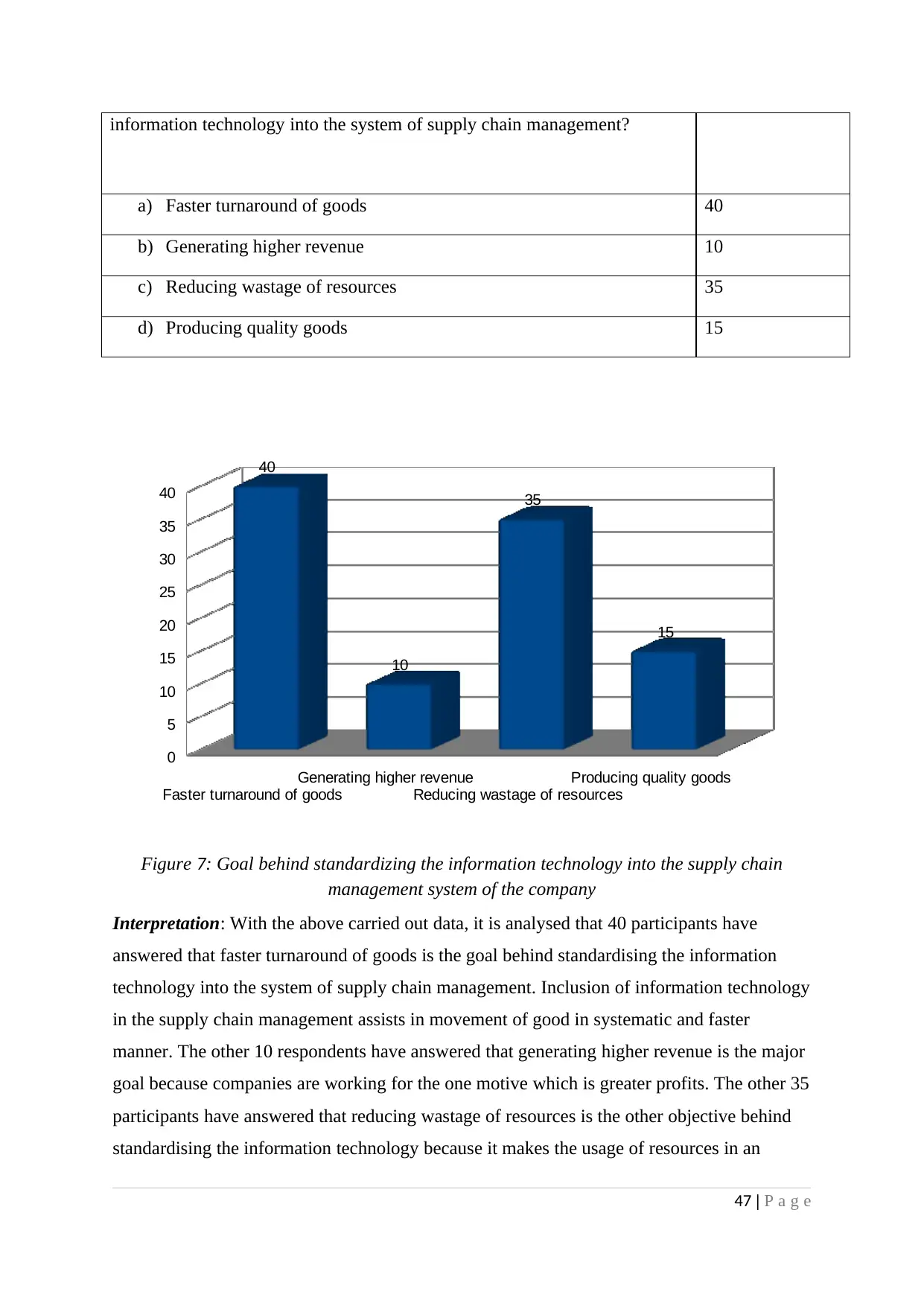
information technology into the system of supply chain management?
a) Faster turnaround of goods 40
b) Generating higher revenue 10
c) Reducing wastage of resources 35
d) Producing quality goods 15
Faster turnaround of goods
Generating higher revenue
Reducing wastage of resources
Producing quality goods
0
5
10
15
20
25
30
35
40
40
10
35
15
Figure 7: Goal behind standardizing the information technology into the supply chain
management system of the company
Interpretation: With the above carried out data, it is analysed that 40 participants have
answered that faster turnaround of goods is the goal behind standardising the information
technology into the system of supply chain management. Inclusion of information technology
in the supply chain management assists in movement of good in systematic and faster
manner. The other 10 respondents have answered that generating higher revenue is the major
goal because companies are working for the one motive which is greater profits. The other 35
participants have answered that reducing wastage of resources is the other objective behind
standardising the information technology because it makes the usage of resources in an
47 | P a g e
a) Faster turnaround of goods 40
b) Generating higher revenue 10
c) Reducing wastage of resources 35
d) Producing quality goods 15
Faster turnaround of goods
Generating higher revenue
Reducing wastage of resources
Producing quality goods
0
5
10
15
20
25
30
35
40
40
10
35
15
Figure 7: Goal behind standardizing the information technology into the supply chain
management system of the company
Interpretation: With the above carried out data, it is analysed that 40 participants have
answered that faster turnaround of goods is the goal behind standardising the information
technology into the system of supply chain management. Inclusion of information technology
in the supply chain management assists in movement of good in systematic and faster
manner. The other 10 respondents have answered that generating higher revenue is the major
goal because companies are working for the one motive which is greater profits. The other 35
participants have answered that reducing wastage of resources is the other objective behind
standardising the information technology because it makes the usage of resources in an
47 | P a g e

effective and efficient manner. The rest 15 respondents have answered that producing quality
goods is the other significant goal because it assists in getting each resource at time in the
organisation. It is being analysed that production of goods is directly dependent over timely
supply of all materials and with the help of information technology in supply chain
management, companies get right material at right time for the production of items in a
systematic and precise manner.
Table 8: Benefits acquired by the companies after using different information technologies in
logistic and supply chain system of the organisation
Q8) What are some benefit which is gained by the companies after
implementing the information technologies into logistic and supply chain
management?
Frequency
a) Lower expenses 10
b) High productivity of chain 15
c) High return on investment 20
d) Lower errors and delay in producing goods and services 5
e) High increases in procurement rate 30
f) More centralised communication 20
48 | P a g e
goods is the other significant goal because it assists in getting each resource at time in the
organisation. It is being analysed that production of goods is directly dependent over timely
supply of all materials and with the help of information technology in supply chain
management, companies get right material at right time for the production of items in a
systematic and precise manner.
Table 8: Benefits acquired by the companies after using different information technologies in
logistic and supply chain system of the organisation
Q8) What are some benefit which is gained by the companies after
implementing the information technologies into logistic and supply chain
management?
Frequency
a) Lower expenses 10
b) High productivity of chain 15
c) High return on investment 20
d) Lower errors and delay in producing goods and services 5
e) High increases in procurement rate 30
f) More centralised communication 20
48 | P a g e
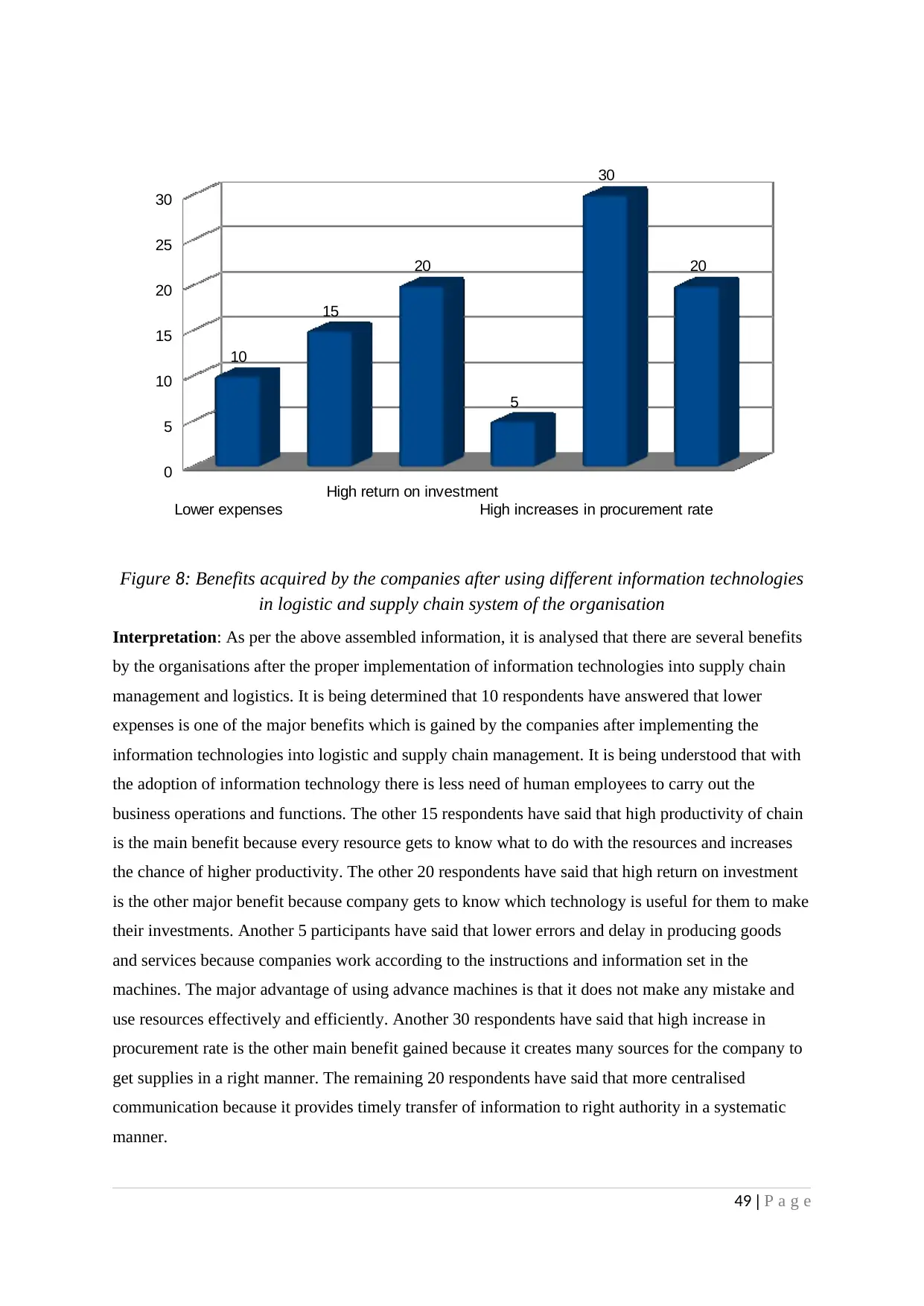
Lower expenses
High return on investment
High increases in procurement rate
0
5
10
15
20
25
30
10
15
20
5
30
20
Figure 8: Benefits acquired by the companies after using different information technologies
in logistic and supply chain system of the organisation
Interpretation: As per the above assembled information, it is analysed that there are several benefits
by the organisations after the proper implementation of information technologies into supply chain
management and logistics. It is being determined that 10 respondents have answered that lower
expenses is one of the major benefits which is gained by the companies after implementing the
information technologies into logistic and supply chain management. It is being understood that with
the adoption of information technology there is less need of human employees to carry out the
business operations and functions. The other 15 respondents have said that high productivity of chain
is the main benefit because every resource gets to know what to do with the resources and increases
the chance of higher productivity. The other 20 respondents have said that high return on investment
is the other major benefit because company gets to know which technology is useful for them to make
their investments. Another 5 participants have said that lower errors and delay in producing goods
and services because companies work according to the instructions and information set in the
machines. The major advantage of using advance machines is that it does not make any mistake and
use resources effectively and efficiently. Another 30 respondents have said that high increase in
procurement rate is the other main benefit gained because it creates many sources for the company to
get supplies in a right manner. The remaining 20 respondents have said that more centralised
communication because it provides timely transfer of information to right authority in a systematic
manner.
49 | P a g e
High return on investment
High increases in procurement rate
0
5
10
15
20
25
30
10
15
20
5
30
20
Figure 8: Benefits acquired by the companies after using different information technologies
in logistic and supply chain system of the organisation
Interpretation: As per the above assembled information, it is analysed that there are several benefits
by the organisations after the proper implementation of information technologies into supply chain
management and logistics. It is being determined that 10 respondents have answered that lower
expenses is one of the major benefits which is gained by the companies after implementing the
information technologies into logistic and supply chain management. It is being understood that with
the adoption of information technology there is less need of human employees to carry out the
business operations and functions. The other 15 respondents have said that high productivity of chain
is the main benefit because every resource gets to know what to do with the resources and increases
the chance of higher productivity. The other 20 respondents have said that high return on investment
is the other major benefit because company gets to know which technology is useful for them to make
their investments. Another 5 participants have said that lower errors and delay in producing goods
and services because companies work according to the instructions and information set in the
machines. The major advantage of using advance machines is that it does not make any mistake and
use resources effectively and efficiently. Another 30 respondents have said that high increase in
procurement rate is the other main benefit gained because it creates many sources for the company to
get supplies in a right manner. The remaining 20 respondents have said that more centralised
communication because it provides timely transfer of information to right authority in a systematic
manner.
49 | P a g e
Paraphrase This Document
Need a fresh take? Get an instant paraphrase of this document with our AI Paraphraser
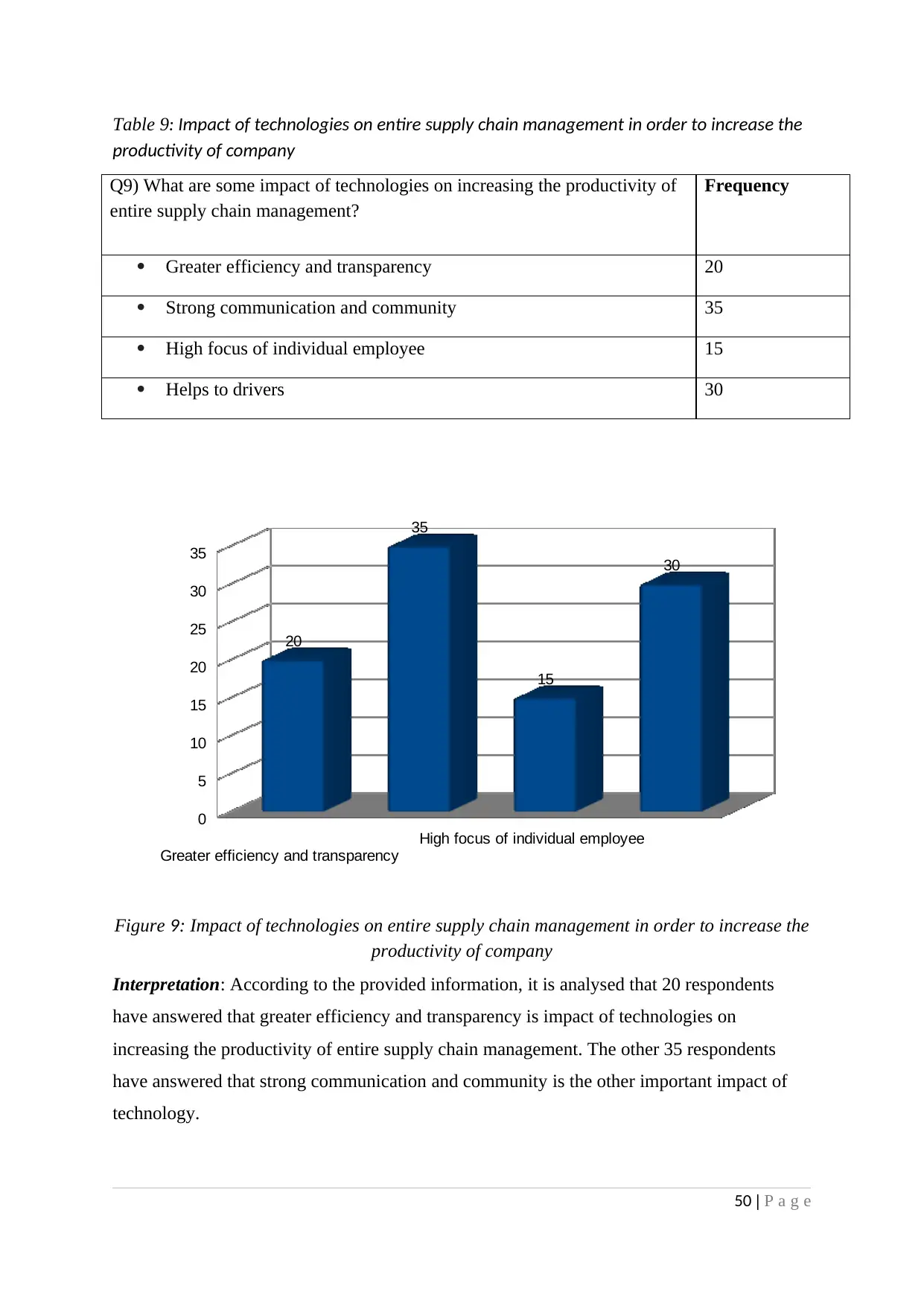
Table 9: Impact of technologies on entire supply chain management in order to increase the
productivity of company
Q9) What are some impact of technologies on increasing the productivity of
entire supply chain management?
Frequency
Greater efficiency and transparency 20
Strong communication and community 35
High focus of individual employee 15
Helps to drivers 30
Greater efficiency and transparency
High focus of individual employee
0
5
10
15
20
25
30
35
20
35
15
30
Figure 9: Impact of technologies on entire supply chain management in order to increase the
productivity of company
Interpretation: According to the provided information, it is analysed that 20 respondents
have answered that greater efficiency and transparency is impact of technologies on
increasing the productivity of entire supply chain management. The other 35 respondents
have answered that strong communication and community is the other important impact of
technology.
50 | P a g e
productivity of company
Q9) What are some impact of technologies on increasing the productivity of
entire supply chain management?
Frequency
Greater efficiency and transparency 20
Strong communication and community 35
High focus of individual employee 15
Helps to drivers 30
Greater efficiency and transparency
High focus of individual employee
0
5
10
15
20
25
30
35
20
35
15
30
Figure 9: Impact of technologies on entire supply chain management in order to increase the
productivity of company
Interpretation: According to the provided information, it is analysed that 20 respondents
have answered that greater efficiency and transparency is impact of technologies on
increasing the productivity of entire supply chain management. The other 35 respondents
have answered that strong communication and community is the other important impact of
technology.
50 | P a g e
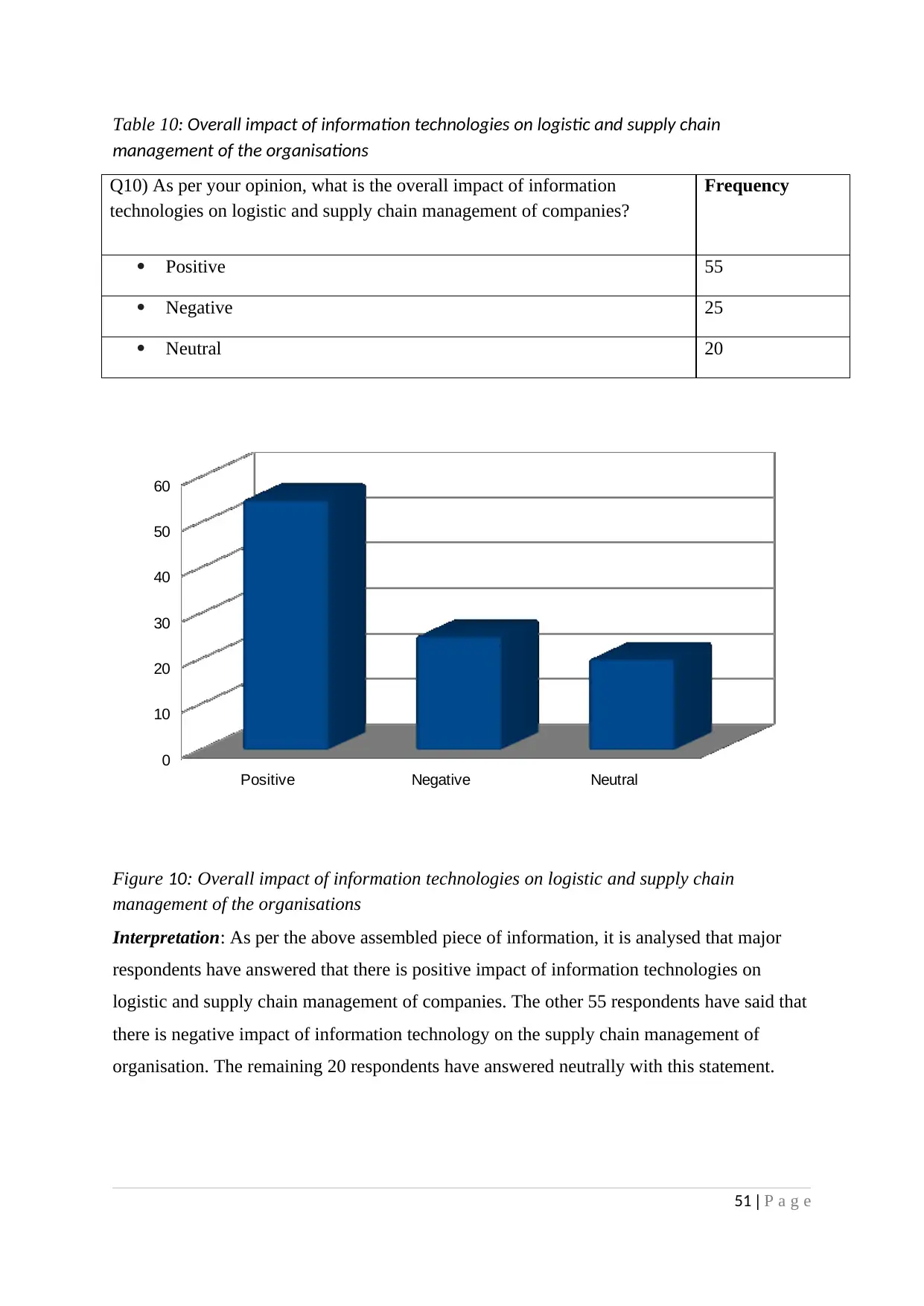
Table 10: Overall impact of information technologies on logistic and supply chain
management of the organisations
Q10) As per your opinion, what is the overall impact of information
technologies on logistic and supply chain management of companies?
Frequency
Positive 55
Negative 25
Neutral 20
Positive Negative Neutral
0
10
20
30
40
50
60
Figure 10: Overall impact of information technologies on logistic and supply chain
management of the organisations
Interpretation: As per the above assembled piece of information, it is analysed that major
respondents have answered that there is positive impact of information technologies on
logistic and supply chain management of companies. The other 55 respondents have said that
there is negative impact of information technology on the supply chain management of
organisation. The remaining 20 respondents have answered neutrally with this statement.
51 | P a g e
management of the organisations
Q10) As per your opinion, what is the overall impact of information
technologies on logistic and supply chain management of companies?
Frequency
Positive 55
Negative 25
Neutral 20
Positive Negative Neutral
0
10
20
30
40
50
60
Figure 10: Overall impact of information technologies on logistic and supply chain
management of the organisations
Interpretation: As per the above assembled piece of information, it is analysed that major
respondents have answered that there is positive impact of information technologies on
logistic and supply chain management of companies. The other 55 respondents have said that
there is negative impact of information technology on the supply chain management of
organisation. The remaining 20 respondents have answered neutrally with this statement.
51 | P a g e
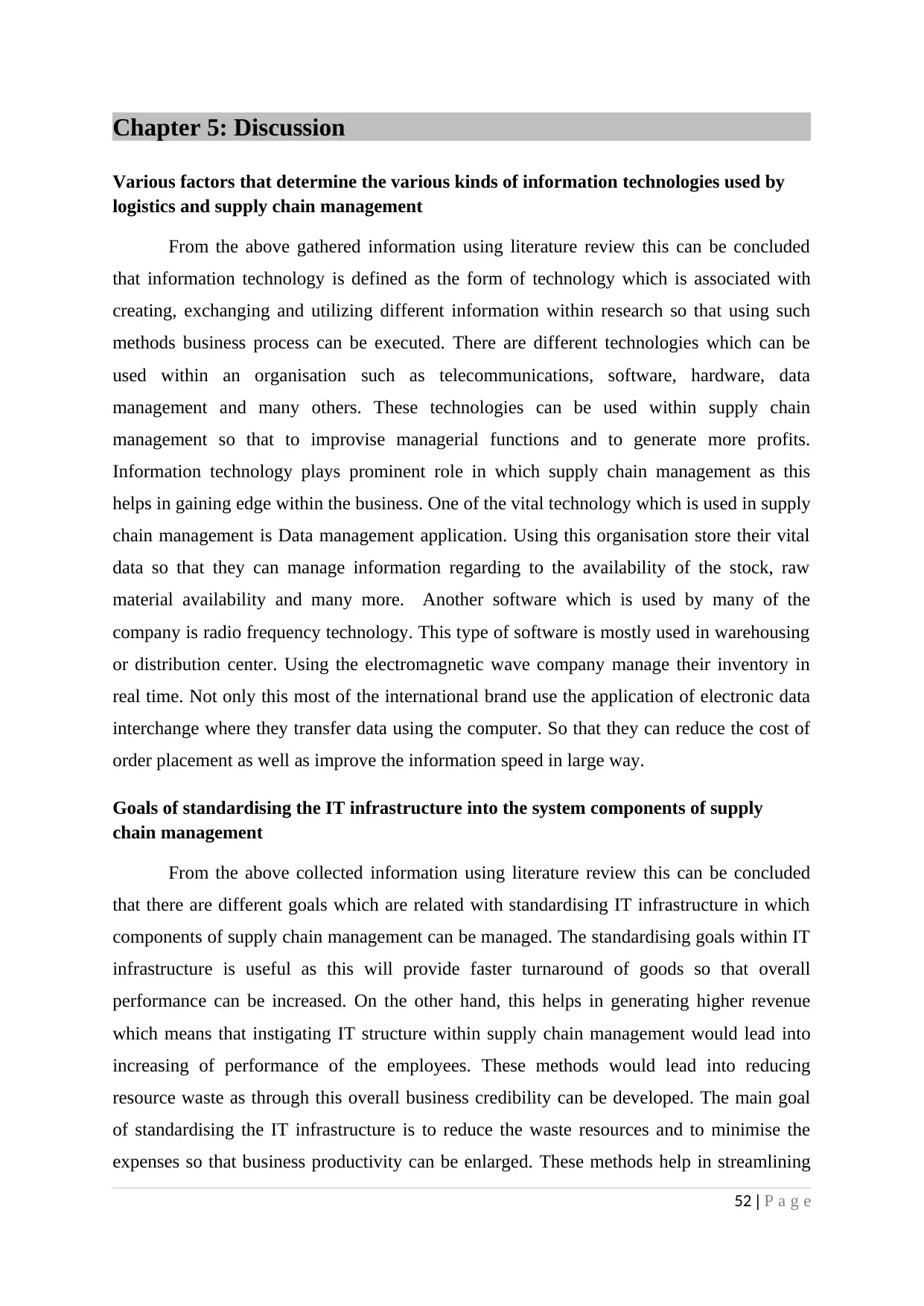
Chapter 5: Discussion
Various factors that determine the various kinds of information technologies used by
logistics and supply chain management
From the above gathered information using literature review this can be concluded
that information technology is defined as the form of technology which is associated with
creating, exchanging and utilizing different information within research so that using such
methods business process can be executed. There are different technologies which can be
used within an organisation such as telecommunications, software, hardware, data
management and many others. These technologies can be used within supply chain
management so that to improvise managerial functions and to generate more profits.
Information technology plays prominent role in which supply chain management as this
helps in gaining edge within the business. One of the vital technology which is used in supply
chain management is Data management application. Using this organisation store their vital
data so that they can manage information regarding to the availability of the stock, raw
material availability and many more. Another software which is used by many of the
company is radio frequency technology. This type of software is mostly used in warehousing
or distribution center. Using the electromagnetic wave company manage their inventory in
real time. Not only this most of the international brand use the application of electronic data
interchange where they transfer data using the computer. So that they can reduce the cost of
order placement as well as improve the information speed in large way.
Goals of standardising the IT infrastructure into the system components of supply
chain management
From the above collected information using literature review this can be concluded
that there are different goals which are related with standardising IT infrastructure in which
components of supply chain management can be managed. The standardising goals within IT
infrastructure is useful as this will provide faster turnaround of goods so that overall
performance can be increased. On the other hand, this helps in generating higher revenue
which means that instigating IT structure within supply chain management would lead into
increasing of performance of the employees. These methods would lead into reducing
resource waste as through this overall business credibility can be developed. The main goal
of standardising the IT infrastructure is to reduce the waste resources and to minimise the
expenses so that business productivity can be enlarged. These methods help in streamlining
52 | P a g e
Various factors that determine the various kinds of information technologies used by
logistics and supply chain management
From the above gathered information using literature review this can be concluded
that information technology is defined as the form of technology which is associated with
creating, exchanging and utilizing different information within research so that using such
methods business process can be executed. There are different technologies which can be
used within an organisation such as telecommunications, software, hardware, data
management and many others. These technologies can be used within supply chain
management so that to improvise managerial functions and to generate more profits.
Information technology plays prominent role in which supply chain management as this
helps in gaining edge within the business. One of the vital technology which is used in supply
chain management is Data management application. Using this organisation store their vital
data so that they can manage information regarding to the availability of the stock, raw
material availability and many more. Another software which is used by many of the
company is radio frequency technology. This type of software is mostly used in warehousing
or distribution center. Using the electromagnetic wave company manage their inventory in
real time. Not only this most of the international brand use the application of electronic data
interchange where they transfer data using the computer. So that they can reduce the cost of
order placement as well as improve the information speed in large way.
Goals of standardising the IT infrastructure into the system components of supply
chain management
From the above collected information using literature review this can be concluded
that there are different goals which are related with standardising IT infrastructure in which
components of supply chain management can be managed. The standardising goals within IT
infrastructure is useful as this will provide faster turnaround of goods so that overall
performance can be increased. On the other hand, this helps in generating higher revenue
which means that instigating IT structure within supply chain management would lead into
increasing of performance of the employees. These methods would lead into reducing
resource waste as through this overall business credibility can be developed. The main goal
of standardising the IT infrastructure is to reduce the waste resources and to minimise the
expenses so that business productivity can be enlarged. These methods help in streamlining
52 | P a g e
Secure Best Marks with AI Grader
Need help grading? Try our AI Grader for instant feedback on your assignments.
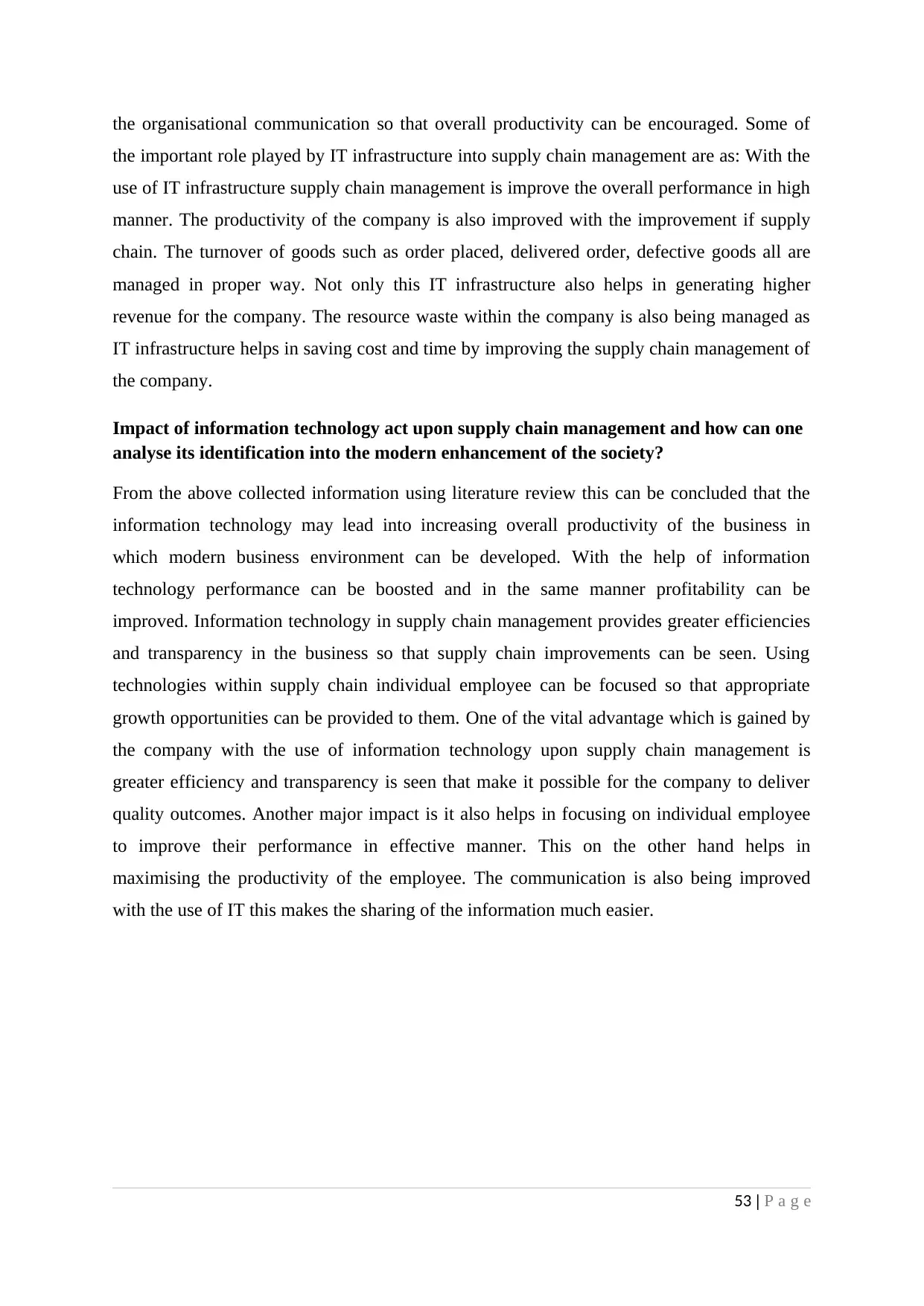
the organisational communication so that overall productivity can be encouraged. Some of
the important role played by IT infrastructure into supply chain management are as: With the
use of IT infrastructure supply chain management is improve the overall performance in high
manner. The productivity of the company is also improved with the improvement if supply
chain. The turnover of goods such as order placed, delivered order, defective goods all are
managed in proper way. Not only this IT infrastructure also helps in generating higher
revenue for the company. The resource waste within the company is also being managed as
IT infrastructure helps in saving cost and time by improving the supply chain management of
the company.
Impact of information technology act upon supply chain management and how can one
analyse its identification into the modern enhancement of the society?
From the above collected information using literature review this can be concluded that the
information technology may lead into increasing overall productivity of the business in
which modern business environment can be developed. With the help of information
technology performance can be boosted and in the same manner profitability can be
improved. Information technology in supply chain management provides greater efficiencies
and transparency in the business so that supply chain improvements can be seen. Using
technologies within supply chain individual employee can be focused so that appropriate
growth opportunities can be provided to them. One of the vital advantage which is gained by
the company with the use of information technology upon supply chain management is
greater efficiency and transparency is seen that make it possible for the company to deliver
quality outcomes. Another major impact is it also helps in focusing on individual employee
to improve their performance in effective manner. This on the other hand helps in
maximising the productivity of the employee. The communication is also being improved
with the use of IT this makes the sharing of the information much easier.
53 | P a g e
the important role played by IT infrastructure into supply chain management are as: With the
use of IT infrastructure supply chain management is improve the overall performance in high
manner. The productivity of the company is also improved with the improvement if supply
chain. The turnover of goods such as order placed, delivered order, defective goods all are
managed in proper way. Not only this IT infrastructure also helps in generating higher
revenue for the company. The resource waste within the company is also being managed as
IT infrastructure helps in saving cost and time by improving the supply chain management of
the company.
Impact of information technology act upon supply chain management and how can one
analyse its identification into the modern enhancement of the society?
From the above collected information using literature review this can be concluded that the
information technology may lead into increasing overall productivity of the business in
which modern business environment can be developed. With the help of information
technology performance can be boosted and in the same manner profitability can be
improved. Information technology in supply chain management provides greater efficiencies
and transparency in the business so that supply chain improvements can be seen. Using
technologies within supply chain individual employee can be focused so that appropriate
growth opportunities can be provided to them. One of the vital advantage which is gained by
the company with the use of information technology upon supply chain management is
greater efficiency and transparency is seen that make it possible for the company to deliver
quality outcomes. Another major impact is it also helps in focusing on individual employee
to improve their performance in effective manner. This on the other hand helps in
maximising the productivity of the employee. The communication is also being improved
with the use of IT this makes the sharing of the information much easier.
53 | P a g e

Chapter 6: Conclusion, recommendations and implications for
further research
Conclusion
From the above research report, it has been concluded that information technology is
one of the most important term for any company or organisation because it is helping in
supply chain management.
Factors that determine the various information technologies used by logistics and
supply chain management
54 | P a g e
further research
Conclusion
From the above research report, it has been concluded that information technology is
one of the most important term for any company or organisation because it is helping in
supply chain management.
Factors that determine the various information technologies used by logistics and
supply chain management
54 | P a g e
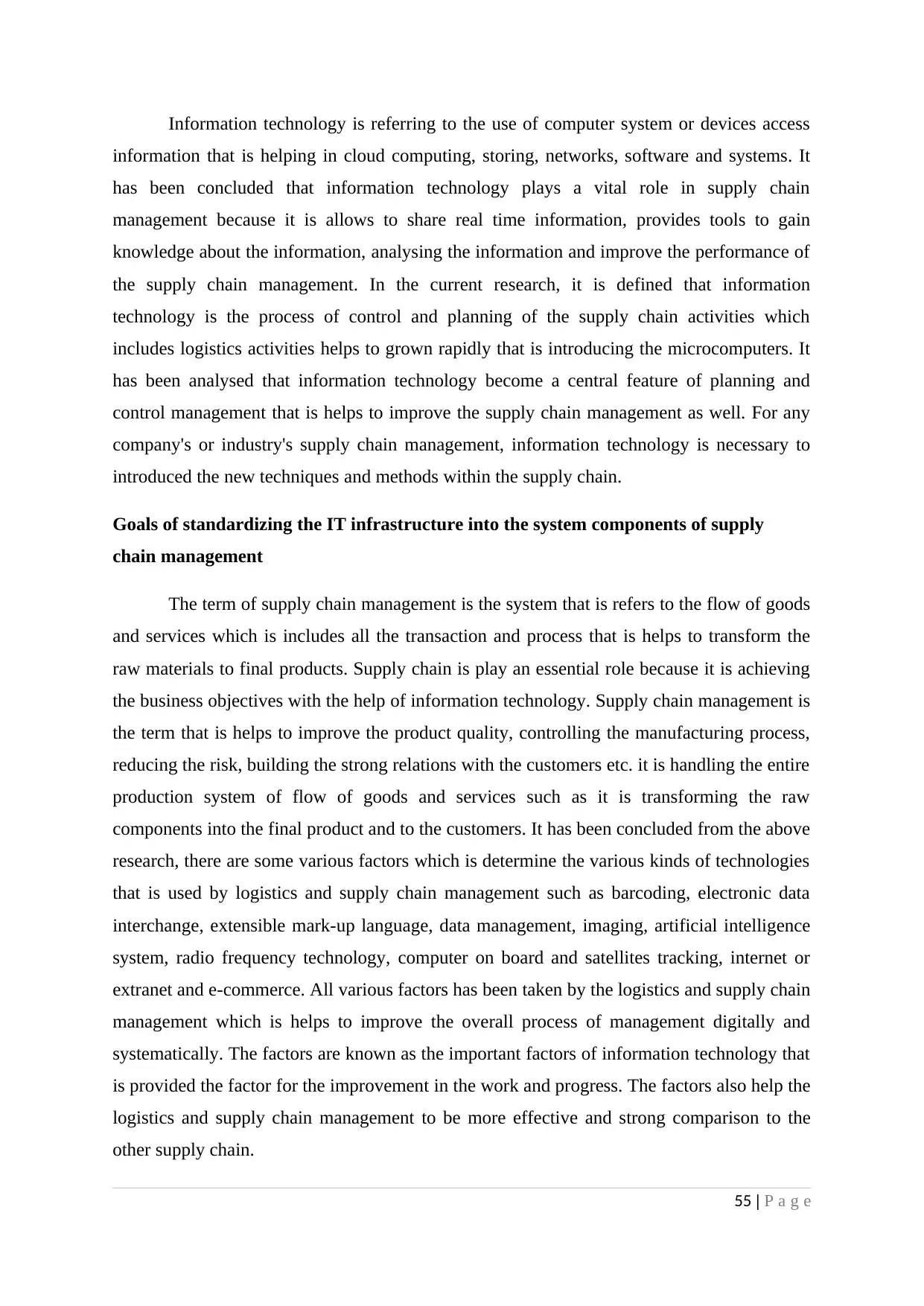
Information technology is referring to the use of computer system or devices access
information that is helping in cloud computing, storing, networks, software and systems. It
has been concluded that information technology plays a vital role in supply chain
management because it is allows to share real time information, provides tools to gain
knowledge about the information, analysing the information and improve the performance of
the supply chain management. In the current research, it is defined that information
technology is the process of control and planning of the supply chain activities which
includes logistics activities helps to grown rapidly that is introducing the microcomputers. It
has been analysed that information technology become a central feature of planning and
control management that is helps to improve the supply chain management as well. For any
company's or industry's supply chain management, information technology is necessary to
introduced the new techniques and methods within the supply chain.
Goals of standardizing the IT infrastructure into the system components of supply
chain management
The term of supply chain management is the system that is refers to the flow of goods
and services which is includes all the transaction and process that is helps to transform the
raw materials to final products. Supply chain is play an essential role because it is achieving
the business objectives with the help of information technology. Supply chain management is
the term that is helps to improve the product quality, controlling the manufacturing process,
reducing the risk, building the strong relations with the customers etc. it is handling the entire
production system of flow of goods and services such as it is transforming the raw
components into the final product and to the customers. It has been concluded from the above
research, there are some various factors which is determine the various kinds of technologies
that is used by logistics and supply chain management such as barcoding, electronic data
interchange, extensible mark-up language, data management, imaging, artificial intelligence
system, radio frequency technology, computer on board and satellites tracking, internet or
extranet and e-commerce. All various factors has been taken by the logistics and supply chain
management which is helps to improve the overall process of management digitally and
systematically. The factors are known as the important factors of information technology that
is provided the factor for the improvement in the work and progress. The factors also help the
logistics and supply chain management to be more effective and strong comparison to the
other supply chain.
55 | P a g e
information that is helping in cloud computing, storing, networks, software and systems. It
has been concluded that information technology plays a vital role in supply chain
management because it is allows to share real time information, provides tools to gain
knowledge about the information, analysing the information and improve the performance of
the supply chain management. In the current research, it is defined that information
technology is the process of control and planning of the supply chain activities which
includes logistics activities helps to grown rapidly that is introducing the microcomputers. It
has been analysed that information technology become a central feature of planning and
control management that is helps to improve the supply chain management as well. For any
company's or industry's supply chain management, information technology is necessary to
introduced the new techniques and methods within the supply chain.
Goals of standardizing the IT infrastructure into the system components of supply
chain management
The term of supply chain management is the system that is refers to the flow of goods
and services which is includes all the transaction and process that is helps to transform the
raw materials to final products. Supply chain is play an essential role because it is achieving
the business objectives with the help of information technology. Supply chain management is
the term that is helps to improve the product quality, controlling the manufacturing process,
reducing the risk, building the strong relations with the customers etc. it is handling the entire
production system of flow of goods and services such as it is transforming the raw
components into the final product and to the customers. It has been concluded from the above
research, there are some various factors which is determine the various kinds of technologies
that is used by logistics and supply chain management such as barcoding, electronic data
interchange, extensible mark-up language, data management, imaging, artificial intelligence
system, radio frequency technology, computer on board and satellites tracking, internet or
extranet and e-commerce. All various factors has been taken by the logistics and supply chain
management which is helps to improve the overall process of management digitally and
systematically. The factors are known as the important factors of information technology that
is provided the factor for the improvement in the work and progress. The factors also help the
logistics and supply chain management to be more effective and strong comparison to the
other supply chain.
55 | P a g e
Paraphrase This Document
Need a fresh take? Get an instant paraphrase of this document with our AI Paraphraser
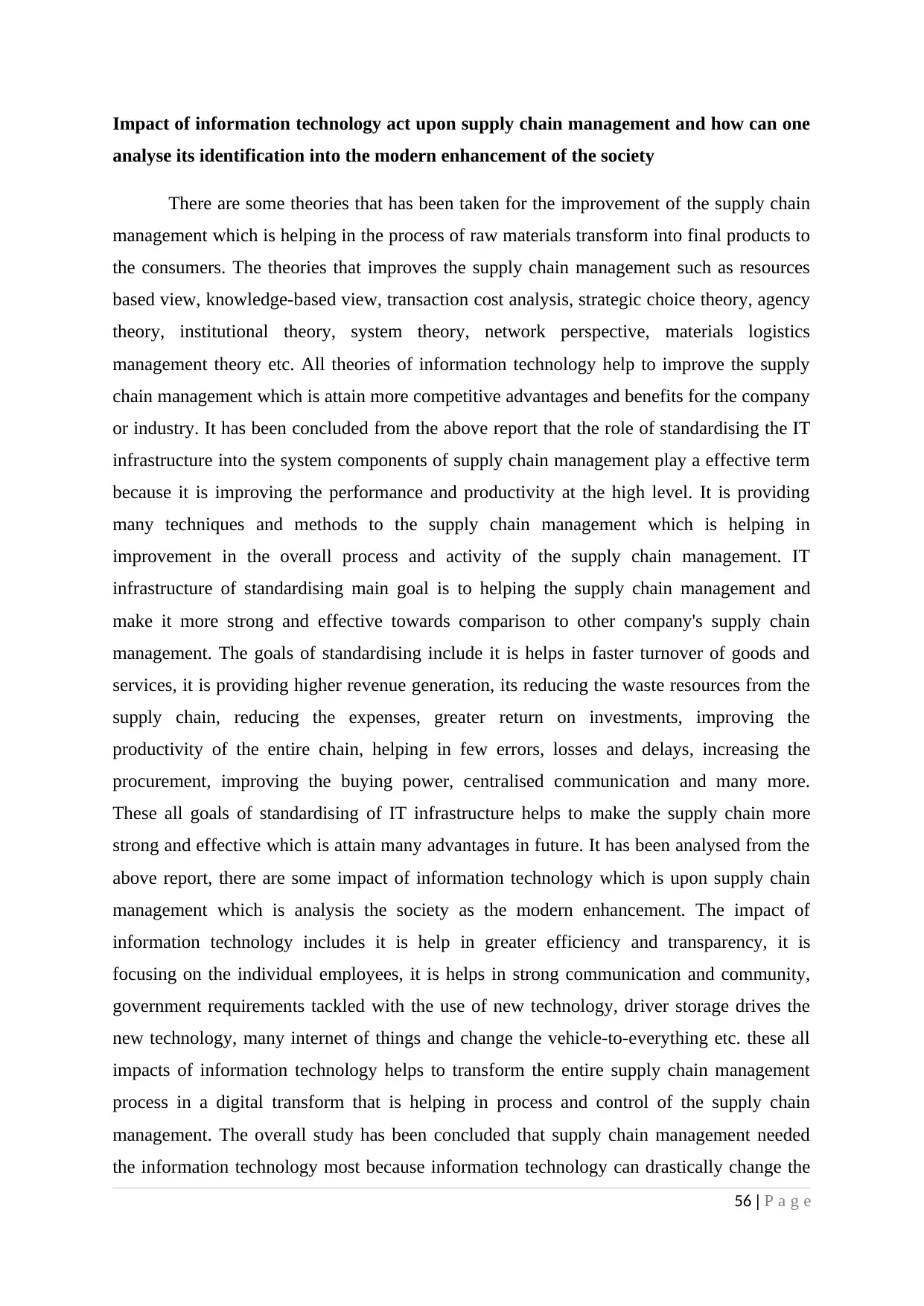
Impact of information technology act upon supply chain management and how can one
analyse its identification into the modern enhancement of the society
There are some theories that has been taken for the improvement of the supply chain
management which is helping in the process of raw materials transform into final products to
the consumers. The theories that improves the supply chain management such as resources
based view, knowledge-based view, transaction cost analysis, strategic choice theory, agency
theory, institutional theory, system theory, network perspective, materials logistics
management theory etc. All theories of information technology help to improve the supply
chain management which is attain more competitive advantages and benefits for the company
or industry. It has been concluded from the above report that the role of standardising the IT
infrastructure into the system components of supply chain management play a effective term
because it is improving the performance and productivity at the high level. It is providing
many techniques and methods to the supply chain management which is helping in
improvement in the overall process and activity of the supply chain management. IT
infrastructure of standardising main goal is to helping the supply chain management and
make it more strong and effective towards comparison to other company's supply chain
management. The goals of standardising include it is helps in faster turnover of goods and
services, it is providing higher revenue generation, its reducing the waste resources from the
supply chain, reducing the expenses, greater return on investments, improving the
productivity of the entire chain, helping in few errors, losses and delays, increasing the
procurement, improving the buying power, centralised communication and many more.
These all goals of standardising of IT infrastructure helps to make the supply chain more
strong and effective which is attain many advantages in future. It has been analysed from the
above report, there are some impact of information technology which is upon supply chain
management which is analysis the society as the modern enhancement. The impact of
information technology includes it is help in greater efficiency and transparency, it is
focusing on the individual employees, it is helps in strong communication and community,
government requirements tackled with the use of new technology, driver storage drives the
new technology, many internet of things and change the vehicle-to-everything etc. these all
impacts of information technology helps to transform the entire supply chain management
process in a digital transform that is helping in process and control of the supply chain
management. The overall study has been concluded that supply chain management needed
the information technology most because information technology can drastically change the
56 | P a g e
analyse its identification into the modern enhancement of the society
There are some theories that has been taken for the improvement of the supply chain
management which is helping in the process of raw materials transform into final products to
the consumers. The theories that improves the supply chain management such as resources
based view, knowledge-based view, transaction cost analysis, strategic choice theory, agency
theory, institutional theory, system theory, network perspective, materials logistics
management theory etc. All theories of information technology help to improve the supply
chain management which is attain more competitive advantages and benefits for the company
or industry. It has been concluded from the above report that the role of standardising the IT
infrastructure into the system components of supply chain management play a effective term
because it is improving the performance and productivity at the high level. It is providing
many techniques and methods to the supply chain management which is helping in
improvement in the overall process and activity of the supply chain management. IT
infrastructure of standardising main goal is to helping the supply chain management and
make it more strong and effective towards comparison to other company's supply chain
management. The goals of standardising include it is helps in faster turnover of goods and
services, it is providing higher revenue generation, its reducing the waste resources from the
supply chain, reducing the expenses, greater return on investments, improving the
productivity of the entire chain, helping in few errors, losses and delays, increasing the
procurement, improving the buying power, centralised communication and many more.
These all goals of standardising of IT infrastructure helps to make the supply chain more
strong and effective which is attain many advantages in future. It has been analysed from the
above report, there are some impact of information technology which is upon supply chain
management which is analysis the society as the modern enhancement. The impact of
information technology includes it is help in greater efficiency and transparency, it is
focusing on the individual employees, it is helps in strong communication and community,
government requirements tackled with the use of new technology, driver storage drives the
new technology, many internet of things and change the vehicle-to-everything etc. these all
impacts of information technology helps to transform the entire supply chain management
process in a digital transform that is helping in process and control of the supply chain
management. The overall study has been concluded that supply chain management needed
the information technology most because information technology can drastically change the
56 | P a g e

entire supply chain management and improve it for the attaining more competitive
advantages for the company. Information technology is most important term for improving
the supply chain management and its process and activities of transforming the raw materials
into final goods to consumers.
Recommendations
there are some recommendations recommended for improving the supply chain
management for attaining more competitive advantages and benefits. The recommendation
helps to attain the stronger supply chain management and logistics that will helps to improve
the productivity and performance. The recommendation for supply chain management
increasing the probability and performance of the overall chain which is helps in more
smoothness and efficiencies. The recommendation to improving the supply chain
management with the use of information technologies are as given below-
Real-time, actionable data: this is recommended to improve the supply chain
management by provided services to the customer on the real time and inventory data.
Real time and actionable data is the term where the process and activities can be done
by the fingerprints that is helps in accuracy and actionable data.
visibility across the supply chain: by pairing with RFID technology, it is helps in
cloud based computerised tracking and shipping which is helps in simplifies the
process of supply chain management. It is helps to reduce the shipping errors. Supply
chain management technologies helps to make the process easy by reducing the time
which is spent on the shipping, tracking and receiving. So, it will recommend that it is
necessary to having the visibility of the supply chain management which is helps in
improvement and organised the data digitally.
simplify the supply chain: simplify the supply chain management helps to improve
the performance and productivity of the company. Investing within the supply chain
management helps to simplify the company's supply chains, unnecessary links,
improving the efficiency by reducing expenditure and many more. So it is
recommended to simplify the supply chain management for the improvement of the
activities and process of supply chain that is increase the profitably and probability.
57 | P a g e
advantages for the company. Information technology is most important term for improving
the supply chain management and its process and activities of transforming the raw materials
into final goods to consumers.
Recommendations
there are some recommendations recommended for improving the supply chain
management for attaining more competitive advantages and benefits. The recommendation
helps to attain the stronger supply chain management and logistics that will helps to improve
the productivity and performance. The recommendation for supply chain management
increasing the probability and performance of the overall chain which is helps in more
smoothness and efficiencies. The recommendation to improving the supply chain
management with the use of information technologies are as given below-
Real-time, actionable data: this is recommended to improve the supply chain
management by provided services to the customer on the real time and inventory data.
Real time and actionable data is the term where the process and activities can be done
by the fingerprints that is helps in accuracy and actionable data.
visibility across the supply chain: by pairing with RFID technology, it is helps in
cloud based computerised tracking and shipping which is helps in simplifies the
process of supply chain management. It is helps to reduce the shipping errors. Supply
chain management technologies helps to make the process easy by reducing the time
which is spent on the shipping, tracking and receiving. So, it will recommend that it is
necessary to having the visibility of the supply chain management which is helps in
improvement and organised the data digitally.
simplify the supply chain: simplify the supply chain management helps to improve
the performance and productivity of the company. Investing within the supply chain
management helps to simplify the company's supply chains, unnecessary links,
improving the efficiency by reducing expenditure and many more. So it is
recommended to simplify the supply chain management for the improvement of the
activities and process of supply chain that is increase the profitably and probability.
57 | P a g e

enhance the customer communication: it is the term which is play a vital role to
enhancing the customer communication by providing the digital services where they
can manage and use the supply chain networks by their home. By improving the
enhancement of customer communication helps to improve the communication of
supply chain management more faster and stronger. So, it will recommend to improve
the supply chain by enhancement of customer communication which can be possible
by providing the parts order tracking, location map, location of parts nearest of the
customers etc.
Uses of technologies: uses of technologies within the supply chain management is
one of the most important term or part because it is helps to make the supply chain
management digital and modern. Technologies play a vital role in improving the
supply chain management because it is helps to provide many techniques and models
which is helps in changed the supply chain drastically. So, it will recommend to
improve the supply chain by using the technologies which is helps in better
improvement. With the use of new technology supply chain management can attain
more competitive benefits and advantages which is helps in future growth. This
recommendation will help to increase the productivity and performance of the supply
chain and improve it for achieving the future targets for the company.
Implications for further research
the implication for the further research is that researcher is taken the quantitative
methodology for the current research where the information and data is collected within the
time period. It is helping to collecting the accurate and valuable data information of the
particular topic. So there is no issue or problem will be created for the future researchers to
conducting the report. If researcher will take qualitative method then it will also make the
current research valuable and effective.
References
Books and Journals
Ardito and et. al., 2018. Towards Industry 4.0: Mapping digital technologies for supply chain
management-marketing integration. Business Process Management Journal.
58 | P a g e
enhancing the customer communication by providing the digital services where they
can manage and use the supply chain networks by their home. By improving the
enhancement of customer communication helps to improve the communication of
supply chain management more faster and stronger. So, it will recommend to improve
the supply chain by enhancement of customer communication which can be possible
by providing the parts order tracking, location map, location of parts nearest of the
customers etc.
Uses of technologies: uses of technologies within the supply chain management is
one of the most important term or part because it is helps to make the supply chain
management digital and modern. Technologies play a vital role in improving the
supply chain management because it is helps to provide many techniques and models
which is helps in changed the supply chain drastically. So, it will recommend to
improve the supply chain by using the technologies which is helps in better
improvement. With the use of new technology supply chain management can attain
more competitive benefits and advantages which is helps in future growth. This
recommendation will help to increase the productivity and performance of the supply
chain and improve it for achieving the future targets for the company.
Implications for further research
the implication for the further research is that researcher is taken the quantitative
methodology for the current research where the information and data is collected within the
time period. It is helping to collecting the accurate and valuable data information of the
particular topic. So there is no issue or problem will be created for the future researchers to
conducting the report. If researcher will take qualitative method then it will also make the
current research valuable and effective.
References
Books and Journals
Ardito and et. al., 2018. Towards Industry 4.0: Mapping digital technologies for supply chain
management-marketing integration. Business Process Management Journal.
58 | P a g e
Secure Best Marks with AI Grader
Need help grading? Try our AI Grader for instant feedback on your assignments.

Basheer and et. al., 2019. Exploring the role of TQM and supply chain practices for firm
supply performance in the presence of information technology capabilities and supply
chain technology adoption: A case of textile firms in Pakistan. Uncertain Supply
Chain Management, 7(2), pp.275-288.
Dutta and et. al., 2020. Blockchain technology in supply chain operations: Applications,
challenges and research opportunities. Transportation research part e: Logistics and
transportation review, 142, p.102067.
Jimenez-Jimenez, D., Martínez-Costa, M. and Rodriguez, C.S., 2018. The mediating role of
supply chain collaboration on the relationship between information technology and
innovation. Journal of Knowledge Management.
Li and et. al., 2020. Green supply chain management in Chinese firms: Innovative measures
and the moderating role of quick response technology. Journal of Operations
Management, 66(7-8), pp.958-988.
Rejeb, A., Keogh, J.G. and Treiblmaier, H., 2019. Leveraging the internet of things and
blockchain technology in supply chain management. Future Internet, 11(7), p.161.
Tönnissen, S. and Teuteberg, F., 2020. Analysing the impact of blockchain-technology for
operations and supply chain management: An explanatory model drawn from
multiple case studies. International Journal of Information Management, 52,
p.101953.
Macrina, G., and et.al., 2020. Drone-aided routing: A literature review. Transportation
Research Part C: Emerging Technologies, 120, p.102762.
Al-Thaqeb, S.A. and Algharabali, B.G., 2019. Economic policy uncertainty: A literature
review. The Journal of Economic Asymmetries, 20, p.e00133.
Errandonea, I., Beltrán, S. and Arrizabalaga, S., 2020. Digital Twin for maintenance: A
literature review. Computers in Industry, 123, p.103316.
Tiwari, S., Wee, H.M. and Daryanto, Y., 2018. Big data analytics in supply chain
management between 2010 and 2016: Insights to industries. Computers & Industrial
Engineering, 115, pp.319-330.
Guha, S. and Kumar, S., 2018. Emergence of big data research in operations management,
information systems, and healthcare: Past contributions and future
roadmap. Production and Operations Management, 27(9), pp.1724-1735.
Queiroz, M.M., Telles, R. and Bonilla, S.H., 2019. Blockchain and supply chain management
integration: a systematic review of the literature. Supply Chain Management: An
International Journal.
Wamba, S.F., Queiroz, M.M. and Trinchera, L., 2020. Dynamics between blockchain
adoption determinants and supply chain performance: An empirical
investigation. International Journal of Production Economics, 229, p.107791.
Kazemi, N., Modak, N.M. and Govindan, K., 2019. A review of reverse logistics and closed
loop supply chain management studies published in IJPR: a bibliometric and content
analysis. International Journal of Production Research, 57(15-16), pp.4937-4960.
59 | P a g e
supply performance in the presence of information technology capabilities and supply
chain technology adoption: A case of textile firms in Pakistan. Uncertain Supply
Chain Management, 7(2), pp.275-288.
Dutta and et. al., 2020. Blockchain technology in supply chain operations: Applications,
challenges and research opportunities. Transportation research part e: Logistics and
transportation review, 142, p.102067.
Jimenez-Jimenez, D., Martínez-Costa, M. and Rodriguez, C.S., 2018. The mediating role of
supply chain collaboration on the relationship between information technology and
innovation. Journal of Knowledge Management.
Li and et. al., 2020. Green supply chain management in Chinese firms: Innovative measures
and the moderating role of quick response technology. Journal of Operations
Management, 66(7-8), pp.958-988.
Rejeb, A., Keogh, J.G. and Treiblmaier, H., 2019. Leveraging the internet of things and
blockchain technology in supply chain management. Future Internet, 11(7), p.161.
Tönnissen, S. and Teuteberg, F., 2020. Analysing the impact of blockchain-technology for
operations and supply chain management: An explanatory model drawn from
multiple case studies. International Journal of Information Management, 52,
p.101953.
Macrina, G., and et.al., 2020. Drone-aided routing: A literature review. Transportation
Research Part C: Emerging Technologies, 120, p.102762.
Al-Thaqeb, S.A. and Algharabali, B.G., 2019. Economic policy uncertainty: A literature
review. The Journal of Economic Asymmetries, 20, p.e00133.
Errandonea, I., Beltrán, S. and Arrizabalaga, S., 2020. Digital Twin for maintenance: A
literature review. Computers in Industry, 123, p.103316.
Tiwari, S., Wee, H.M. and Daryanto, Y., 2018. Big data analytics in supply chain
management between 2010 and 2016: Insights to industries. Computers & Industrial
Engineering, 115, pp.319-330.
Guha, S. and Kumar, S., 2018. Emergence of big data research in operations management,
information systems, and healthcare: Past contributions and future
roadmap. Production and Operations Management, 27(9), pp.1724-1735.
Queiroz, M.M., Telles, R. and Bonilla, S.H., 2019. Blockchain and supply chain management
integration: a systematic review of the literature. Supply Chain Management: An
International Journal.
Wamba, S.F., Queiroz, M.M. and Trinchera, L., 2020. Dynamics between blockchain
adoption determinants and supply chain performance: An empirical
investigation. International Journal of Production Economics, 229, p.107791.
Kazemi, N., Modak, N.M. and Govindan, K., 2019. A review of reverse logistics and closed
loop supply chain management studies published in IJPR: a bibliometric and content
analysis. International Journal of Production Research, 57(15-16), pp.4937-4960.
59 | P a g e
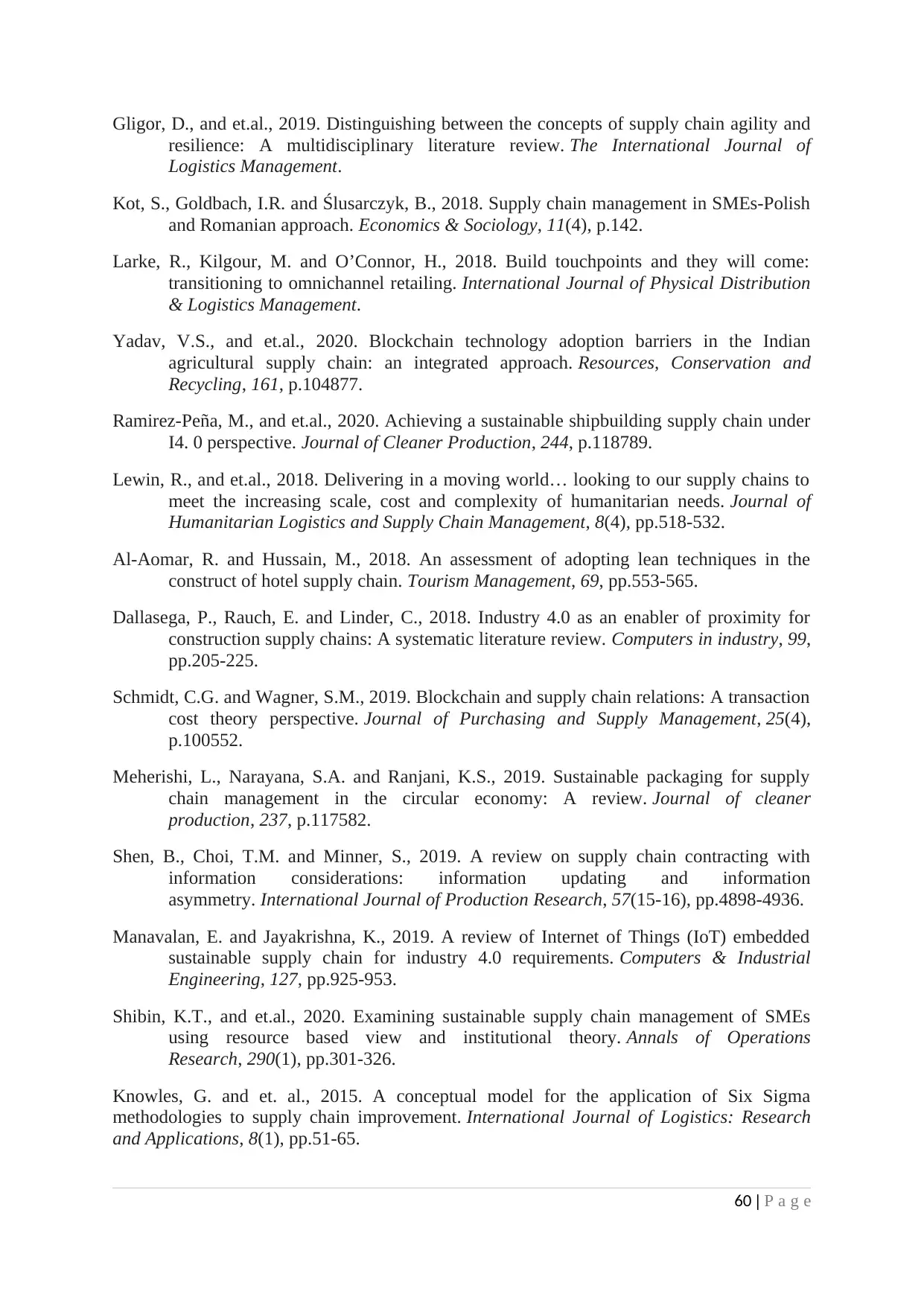
Gligor, D., and et.al., 2019. Distinguishing between the concepts of supply chain agility and
resilience: A multidisciplinary literature review. The International Journal of
Logistics Management.
Kot, S., Goldbach, I.R. and Ślusarczyk, B., 2018. Supply chain management in SMEs-Polish
and Romanian approach. Economics & Sociology, 11(4), p.142.
Larke, R., Kilgour, M. and O’Connor, H., 2018. Build touchpoints and they will come:
transitioning to omnichannel retailing. International Journal of Physical Distribution
& Logistics Management.
Yadav, V.S., and et.al., 2020. Blockchain technology adoption barriers in the Indian
agricultural supply chain: an integrated approach. Resources, Conservation and
Recycling, 161, p.104877.
Ramirez-Peña, M., and et.al., 2020. Achieving a sustainable shipbuilding supply chain under
I4. 0 perspective. Journal of Cleaner Production, 244, p.118789.
Lewin, R., and et.al., 2018. Delivering in a moving world… looking to our supply chains to
meet the increasing scale, cost and complexity of humanitarian needs. Journal of
Humanitarian Logistics and Supply Chain Management, 8(4), pp.518-532.
Al-Aomar, R. and Hussain, M., 2018. An assessment of adopting lean techniques in the
construct of hotel supply chain. Tourism Management, 69, pp.553-565.
Dallasega, P., Rauch, E. and Linder, C., 2018. Industry 4.0 as an enabler of proximity for
construction supply chains: A systematic literature review. Computers in industry, 99,
pp.205-225.
Schmidt, C.G. and Wagner, S.M., 2019. Blockchain and supply chain relations: A transaction
cost theory perspective. Journal of Purchasing and Supply Management, 25(4),
p.100552.
Meherishi, L., Narayana, S.A. and Ranjani, K.S., 2019. Sustainable packaging for supply
chain management in the circular economy: A review. Journal of cleaner
production, 237, p.117582.
Shen, B., Choi, T.M. and Minner, S., 2019. A review on supply chain contracting with
information considerations: information updating and information
asymmetry. International Journal of Production Research, 57(15-16), pp.4898-4936.
Manavalan, E. and Jayakrishna, K., 2019. A review of Internet of Things (IoT) embedded
sustainable supply chain for industry 4.0 requirements. Computers & Industrial
Engineering, 127, pp.925-953.
Shibin, K.T., and et.al., 2020. Examining sustainable supply chain management of SMEs
using resource based view and institutional theory. Annals of Operations
Research, 290(1), pp.301-326.
Knowles, G. and et. al., 2015. A conceptual model for the application of Six Sigma
methodologies to supply chain improvement. International Journal of Logistics: Research
and Applications, 8(1), pp.51-65.
60 | P a g e
resilience: A multidisciplinary literature review. The International Journal of
Logistics Management.
Kot, S., Goldbach, I.R. and Ślusarczyk, B., 2018. Supply chain management in SMEs-Polish
and Romanian approach. Economics & Sociology, 11(4), p.142.
Larke, R., Kilgour, M. and O’Connor, H., 2018. Build touchpoints and they will come:
transitioning to omnichannel retailing. International Journal of Physical Distribution
& Logistics Management.
Yadav, V.S., and et.al., 2020. Blockchain technology adoption barriers in the Indian
agricultural supply chain: an integrated approach. Resources, Conservation and
Recycling, 161, p.104877.
Ramirez-Peña, M., and et.al., 2020. Achieving a sustainable shipbuilding supply chain under
I4. 0 perspective. Journal of Cleaner Production, 244, p.118789.
Lewin, R., and et.al., 2018. Delivering in a moving world… looking to our supply chains to
meet the increasing scale, cost and complexity of humanitarian needs. Journal of
Humanitarian Logistics and Supply Chain Management, 8(4), pp.518-532.
Al-Aomar, R. and Hussain, M., 2018. An assessment of adopting lean techniques in the
construct of hotel supply chain. Tourism Management, 69, pp.553-565.
Dallasega, P., Rauch, E. and Linder, C., 2018. Industry 4.0 as an enabler of proximity for
construction supply chains: A systematic literature review. Computers in industry, 99,
pp.205-225.
Schmidt, C.G. and Wagner, S.M., 2019. Blockchain and supply chain relations: A transaction
cost theory perspective. Journal of Purchasing and Supply Management, 25(4),
p.100552.
Meherishi, L., Narayana, S.A. and Ranjani, K.S., 2019. Sustainable packaging for supply
chain management in the circular economy: A review. Journal of cleaner
production, 237, p.117582.
Shen, B., Choi, T.M. and Minner, S., 2019. A review on supply chain contracting with
information considerations: information updating and information
asymmetry. International Journal of Production Research, 57(15-16), pp.4898-4936.
Manavalan, E. and Jayakrishna, K., 2019. A review of Internet of Things (IoT) embedded
sustainable supply chain for industry 4.0 requirements. Computers & Industrial
Engineering, 127, pp.925-953.
Shibin, K.T., and et.al., 2020. Examining sustainable supply chain management of SMEs
using resource based view and institutional theory. Annals of Operations
Research, 290(1), pp.301-326.
Knowles, G. and et. al., 2015. A conceptual model for the application of Six Sigma
methodologies to supply chain improvement. International Journal of Logistics: Research
and Applications, 8(1), pp.51-65.
60 | P a g e
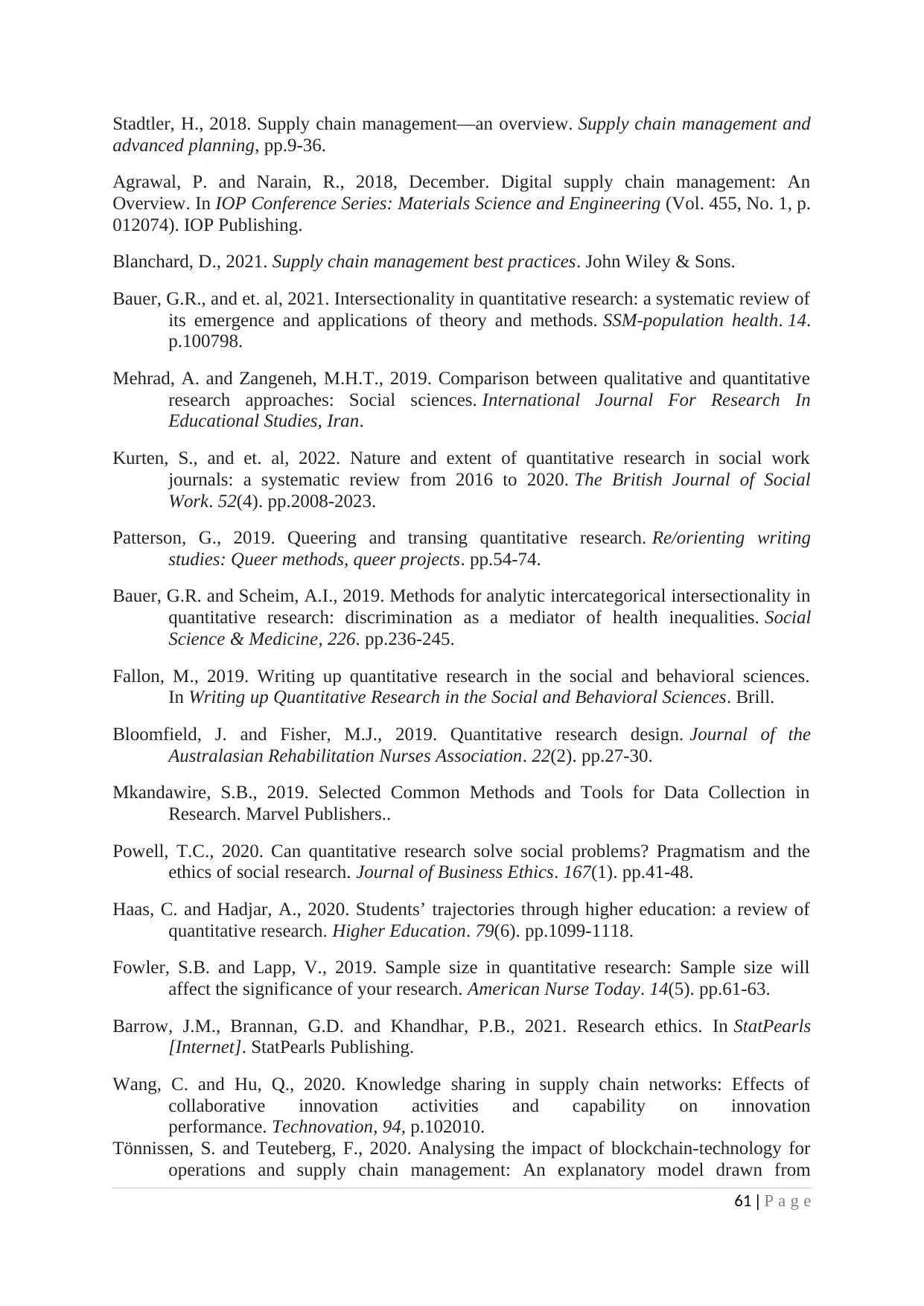
Stadtler, H., 2018. Supply chain management—an overview. Supply chain management and
advanced planning, pp.9-36.
Agrawal, P. and Narain, R., 2018, December. Digital supply chain management: An
Overview. In IOP Conference Series: Materials Science and Engineering (Vol. 455, No. 1, p.
012074). IOP Publishing.
Blanchard, D., 2021. Supply chain management best practices. John Wiley & Sons.
Bauer, G.R., and et. al, 2021. Intersectionality in quantitative research: a systematic review of
its emergence and applications of theory and methods. SSM-population health. 14.
p.100798.
Mehrad, A. and Zangeneh, M.H.T., 2019. Comparison between qualitative and quantitative
research approaches: Social sciences. International Journal For Research In
Educational Studies, Iran.
Kurten, S., and et. al, 2022. Nature and extent of quantitative research in social work
journals: a systematic review from 2016 to 2020. The British Journal of Social
Work. 52(4). pp.2008-2023.
Patterson, G., 2019. Queering and transing quantitative research. Re/orienting writing
studies: Queer methods, queer projects. pp.54-74.
Bauer, G.R. and Scheim, A.I., 2019. Methods for analytic intercategorical intersectionality in
quantitative research: discrimination as a mediator of health inequalities. Social
Science & Medicine, 226. pp.236-245.
Fallon, M., 2019. Writing up quantitative research in the social and behavioral sciences.
In Writing up Quantitative Research in the Social and Behavioral Sciences. Brill.
Bloomfield, J. and Fisher, M.J., 2019. Quantitative research design. Journal of the
Australasian Rehabilitation Nurses Association. 22(2). pp.27-30.
Mkandawire, S.B., 2019. Selected Common Methods and Tools for Data Collection in
Research. Marvel Publishers..
Powell, T.C., 2020. Can quantitative research solve social problems? Pragmatism and the
ethics of social research. Journal of Business Ethics. 167(1). pp.41-48.
Haas, C. and Hadjar, A., 2020. Students’ trajectories through higher education: a review of
quantitative research. Higher Education. 79(6). pp.1099-1118.
Fowler, S.B. and Lapp, V., 2019. Sample size in quantitative research: Sample size will
affect the significance of your research. American Nurse Today. 14(5). pp.61-63.
Barrow, J.M., Brannan, G.D. and Khandhar, P.B., 2021. Research ethics. In StatPearls
[Internet]. StatPearls Publishing.
Wang, C. and Hu, Q., 2020. Knowledge sharing in supply chain networks: Effects of
collaborative innovation activities and capability on innovation
performance. Technovation, 94, p.102010.
Tönnissen, S. and Teuteberg, F., 2020. Analysing the impact of blockchain-technology for
operations and supply chain management: An explanatory model drawn from
61 | P a g e
advanced planning, pp.9-36.
Agrawal, P. and Narain, R., 2018, December. Digital supply chain management: An
Overview. In IOP Conference Series: Materials Science and Engineering (Vol. 455, No. 1, p.
012074). IOP Publishing.
Blanchard, D., 2021. Supply chain management best practices. John Wiley & Sons.
Bauer, G.R., and et. al, 2021. Intersectionality in quantitative research: a systematic review of
its emergence and applications of theory and methods. SSM-population health. 14.
p.100798.
Mehrad, A. and Zangeneh, M.H.T., 2019. Comparison between qualitative and quantitative
research approaches: Social sciences. International Journal For Research In
Educational Studies, Iran.
Kurten, S., and et. al, 2022. Nature and extent of quantitative research in social work
journals: a systematic review from 2016 to 2020. The British Journal of Social
Work. 52(4). pp.2008-2023.
Patterson, G., 2019. Queering and transing quantitative research. Re/orienting writing
studies: Queer methods, queer projects. pp.54-74.
Bauer, G.R. and Scheim, A.I., 2019. Methods for analytic intercategorical intersectionality in
quantitative research: discrimination as a mediator of health inequalities. Social
Science & Medicine, 226. pp.236-245.
Fallon, M., 2019. Writing up quantitative research in the social and behavioral sciences.
In Writing up Quantitative Research in the Social and Behavioral Sciences. Brill.
Bloomfield, J. and Fisher, M.J., 2019. Quantitative research design. Journal of the
Australasian Rehabilitation Nurses Association. 22(2). pp.27-30.
Mkandawire, S.B., 2019. Selected Common Methods and Tools for Data Collection in
Research. Marvel Publishers..
Powell, T.C., 2020. Can quantitative research solve social problems? Pragmatism and the
ethics of social research. Journal of Business Ethics. 167(1). pp.41-48.
Haas, C. and Hadjar, A., 2020. Students’ trajectories through higher education: a review of
quantitative research. Higher Education. 79(6). pp.1099-1118.
Fowler, S.B. and Lapp, V., 2019. Sample size in quantitative research: Sample size will
affect the significance of your research. American Nurse Today. 14(5). pp.61-63.
Barrow, J.M., Brannan, G.D. and Khandhar, P.B., 2021. Research ethics. In StatPearls
[Internet]. StatPearls Publishing.
Wang, C. and Hu, Q., 2020. Knowledge sharing in supply chain networks: Effects of
collaborative innovation activities and capability on innovation
performance. Technovation, 94, p.102010.
Tönnissen, S. and Teuteberg, F., 2020. Analysing the impact of blockchain-technology for
operations and supply chain management: An explanatory model drawn from
61 | P a g e
Paraphrase This Document
Need a fresh take? Get an instant paraphrase of this document with our AI Paraphraser

multiple case studies. International Journal of Information Management, 52,
p.101953.
Burin, A.R.G., Perez-Arostegui, M.N. and Llorens-Montes, J., 2020. Ambidexterity and IT
competence can improve supply chain flexibility? A resource orchestration
approach. Journal of Purchasing and Supply Management, 26(2), p.100610.
Tan, A., Gligor, D. and Ngah, A., 2022. Applying blockchain for halal food
traceability. International Journal of Logistics Research and Applications, 25(6),
pp.947-964.
Word Count
15869 words
62 | P a g e
p.101953.
Burin, A.R.G., Perez-Arostegui, M.N. and Llorens-Montes, J., 2020. Ambidexterity and IT
competence can improve supply chain flexibility? A resource orchestration
approach. Journal of Purchasing and Supply Management, 26(2), p.100610.
Tan, A., Gligor, D. and Ngah, A., 2022. Applying blockchain for halal food
traceability. International Journal of Logistics Research and Applications, 25(6),
pp.947-964.
Word Count
15869 words
62 | P a g e

Appendices
Appendix 1. A blank copy of questionnaire/interview script
Questionnaire
Q1) Do you have a basic knowledge about the concept of supply chain management?
Yes
No
Maybe
Q2) According to you, with change in business operation does information technology plays a
crucial role on supply chain management?
a) Yes
b) No
c) Can’t say
Q3) As per you, which is the most important theory of supply chain management that is used by
companies to improve their quality of product and services?
Six sigma theory
Resource based view
Agency theory
Transaction cost analysis
Knowledge based view
Q4) Do you think, with the use of latest technologies in supply chain management competitive
pressure is being building up between companies?
a) Yes
b) No
c) Maybe
Q5) According to you, which is the most important factor that helps in determine the information
technology used by the company to manage logistics and supply chain management?
a) Imaging
b) Artificial intelligence
63 | P a g e
Appendix 1. A blank copy of questionnaire/interview script
Questionnaire
Q1) Do you have a basic knowledge about the concept of supply chain management?
Yes
No
Maybe
Q2) According to you, with change in business operation does information technology plays a
crucial role on supply chain management?
a) Yes
b) No
c) Can’t say
Q3) As per you, which is the most important theory of supply chain management that is used by
companies to improve their quality of product and services?
Six sigma theory
Resource based view
Agency theory
Transaction cost analysis
Knowledge based view
Q4) Do you think, with the use of latest technologies in supply chain management competitive
pressure is being building up between companies?
a) Yes
b) No
c) Maybe
Q5) According to you, which is the most important factor that helps in determine the information
technology used by the company to manage logistics and supply chain management?
a) Imaging
b) Artificial intelligence
63 | P a g e
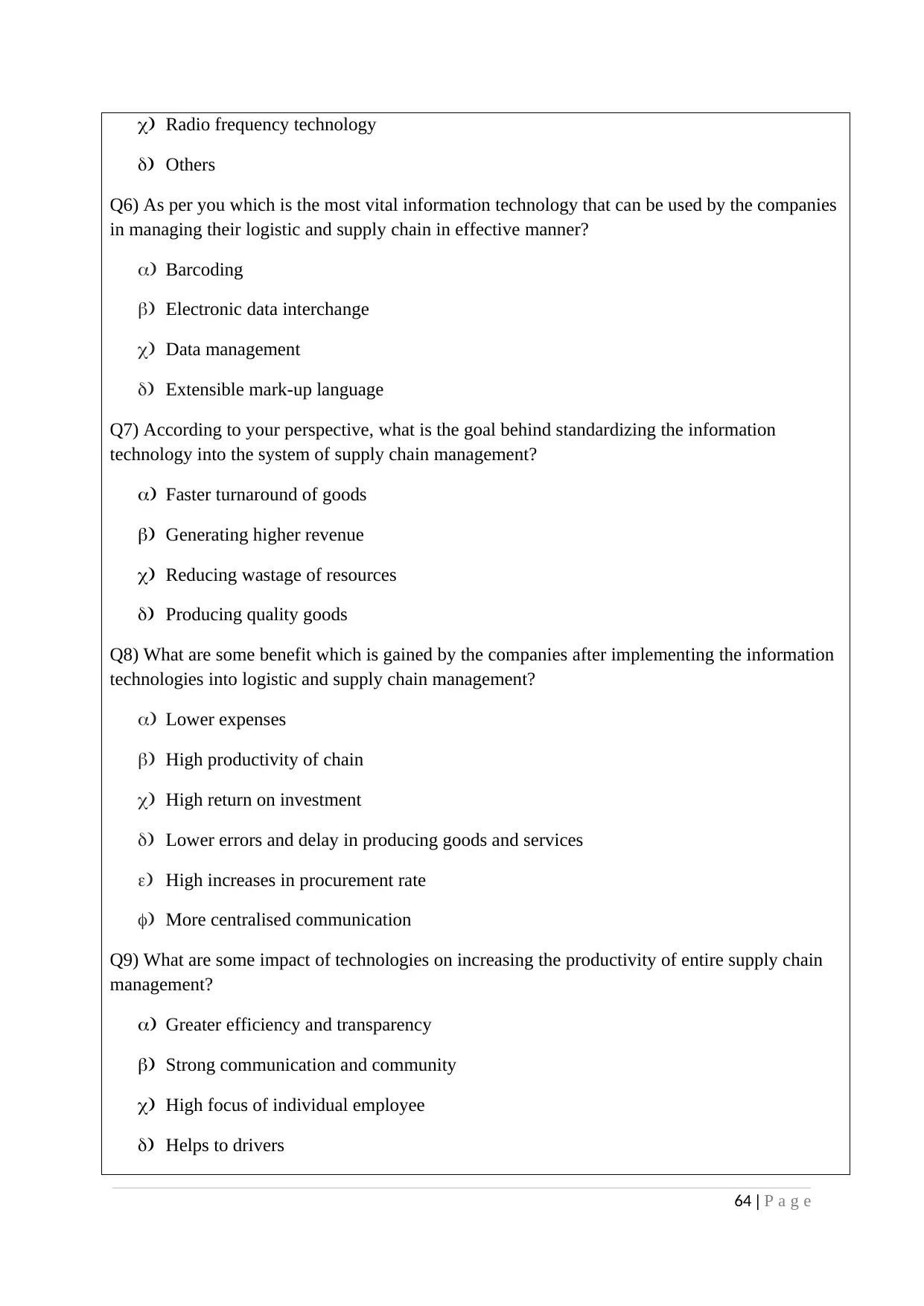
c) Radio frequency technology
d) Others
Q6) As per you which is the most vital information technology that can be used by the companies
in managing their logistic and supply chain in effective manner?
a) Barcoding
b) Electronic data interchange
c) Data management
d) Extensible mark-up language
Q7) According to your perspective, what is the goal behind standardizing the information
technology into the system of supply chain management?
a) Faster turnaround of goods
b) Generating higher revenue
c) Reducing wastage of resources
d) Producing quality goods
Q8) What are some benefit which is gained by the companies after implementing the information
technologies into logistic and supply chain management?
a) Lower expenses
b) High productivity of chain
c) High return on investment
d) Lower errors and delay in producing goods and services
e) High increases in procurement rate
f) More centralised communication
Q9) What are some impact of technologies on increasing the productivity of entire supply chain
management?
a) Greater efficiency and transparency
b) Strong communication and community
c) High focus of individual employee
d) Helps to drivers
64 | P a g e
d) Others
Q6) As per you which is the most vital information technology that can be used by the companies
in managing their logistic and supply chain in effective manner?
a) Barcoding
b) Electronic data interchange
c) Data management
d) Extensible mark-up language
Q7) According to your perspective, what is the goal behind standardizing the information
technology into the system of supply chain management?
a) Faster turnaround of goods
b) Generating higher revenue
c) Reducing wastage of resources
d) Producing quality goods
Q8) What are some benefit which is gained by the companies after implementing the information
technologies into logistic and supply chain management?
a) Lower expenses
b) High productivity of chain
c) High return on investment
d) Lower errors and delay in producing goods and services
e) High increases in procurement rate
f) More centralised communication
Q9) What are some impact of technologies on increasing the productivity of entire supply chain
management?
a) Greater efficiency and transparency
b) Strong communication and community
c) High focus of individual employee
d) Helps to drivers
64 | P a g e
Secure Best Marks with AI Grader
Need help grading? Try our AI Grader for instant feedback on your assignments.

Q10) As per your opinion, what is the overall impact of information technologies on logistic and
supply chain management of companies?
a) Positive
b) Negative
c) Neutral
Appendix 2. A sample of completed questionnaire/ A sample of Interview
Transcript
Frequency distribution table
Q1) Do you have a basic knowledge about the concept of supply chain
management?
Frequency
Yes 35
No 5
Maybe 10
Q2) According to you, with change in business operation does information
technology plays a crucial role on supply chain management?
Frequency
a) Yes 30
b) No 15
c) Can’t say 5
Q3) As per you, which is the most important theory of supply chain
management that is used by companies to improve their quality of product
and services?
Frequency
a) Six sigma theory 20
b) Resource based view 9
c) Agency theory 7
d) Transaction cost analysis 10
e) Knowledge based view 4
Q4) Do you think, with the use of latest technologies in supply chain Frequency
65 | P a g e
supply chain management of companies?
a) Positive
b) Negative
c) Neutral
Appendix 2. A sample of completed questionnaire/ A sample of Interview
Transcript
Frequency distribution table
Q1) Do you have a basic knowledge about the concept of supply chain
management?
Frequency
Yes 35
No 5
Maybe 10
Q2) According to you, with change in business operation does information
technology plays a crucial role on supply chain management?
Frequency
a) Yes 30
b) No 15
c) Can’t say 5
Q3) As per you, which is the most important theory of supply chain
management that is used by companies to improve their quality of product
and services?
Frequency
a) Six sigma theory 20
b) Resource based view 9
c) Agency theory 7
d) Transaction cost analysis 10
e) Knowledge based view 4
Q4) Do you think, with the use of latest technologies in supply chain Frequency
65 | P a g e
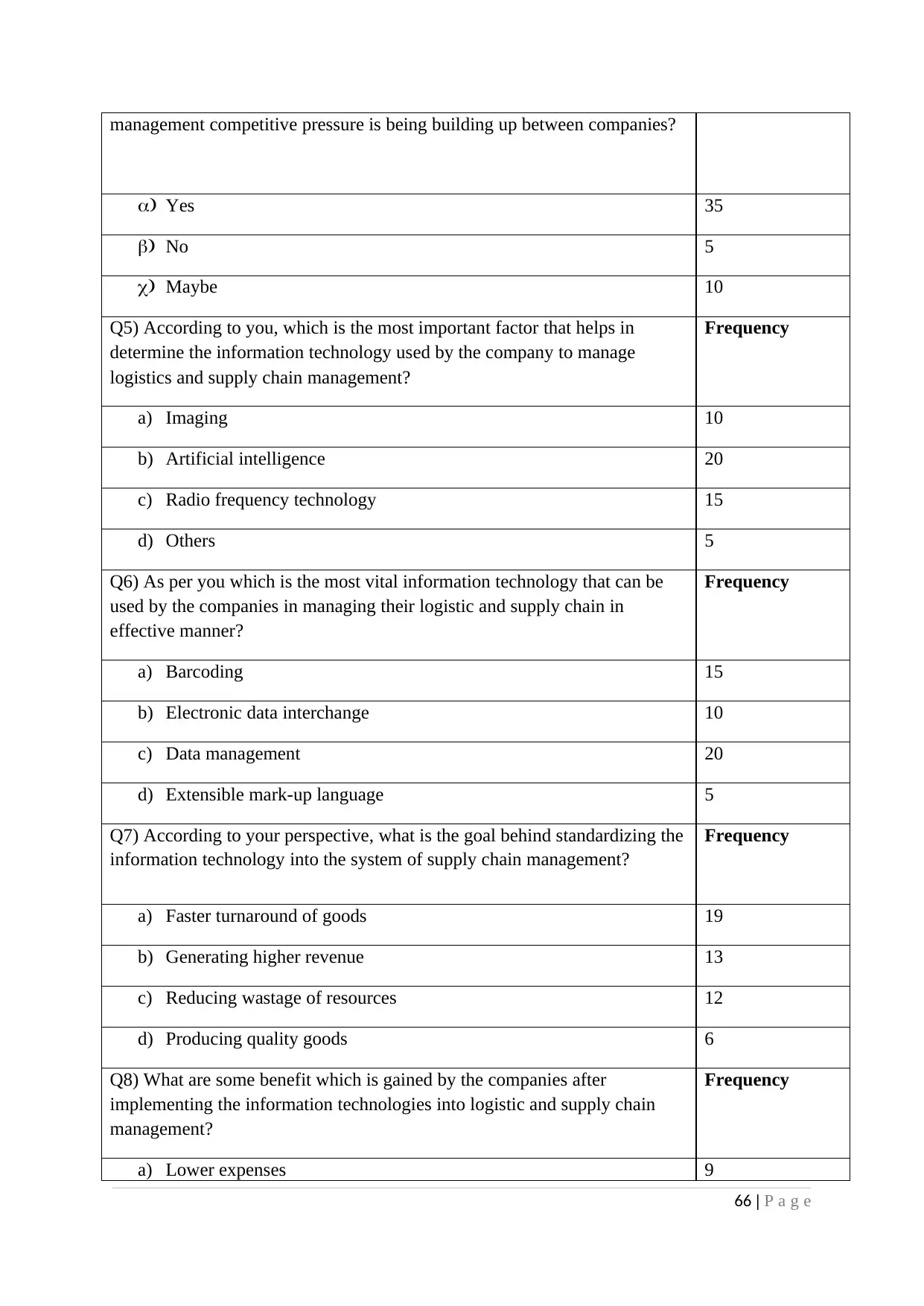
management competitive pressure is being building up between companies?
a) Yes 35
b) No 5
c) Maybe 10
Q5) According to you, which is the most important factor that helps in
determine the information technology used by the company to manage
logistics and supply chain management?
Frequency
a) Imaging 10
b) Artificial intelligence 20
c) Radio frequency technology 15
d) Others 5
Q6) As per you which is the most vital information technology that can be
used by the companies in managing their logistic and supply chain in
effective manner?
Frequency
a) Barcoding 15
b) Electronic data interchange 10
c) Data management 20
d) Extensible mark-up language 5
Q7) According to your perspective, what is the goal behind standardizing the
information technology into the system of supply chain management?
Frequency
a) Faster turnaround of goods 19
b) Generating higher revenue 13
c) Reducing wastage of resources 12
d) Producing quality goods 6
Q8) What are some benefit which is gained by the companies after
implementing the information technologies into logistic and supply chain
management?
Frequency
a) Lower expenses 9
66 | P a g e
a) Yes 35
b) No 5
c) Maybe 10
Q5) According to you, which is the most important factor that helps in
determine the information technology used by the company to manage
logistics and supply chain management?
Frequency
a) Imaging 10
b) Artificial intelligence 20
c) Radio frequency technology 15
d) Others 5
Q6) As per you which is the most vital information technology that can be
used by the companies in managing their logistic and supply chain in
effective manner?
Frequency
a) Barcoding 15
b) Electronic data interchange 10
c) Data management 20
d) Extensible mark-up language 5
Q7) According to your perspective, what is the goal behind standardizing the
information technology into the system of supply chain management?
Frequency
a) Faster turnaround of goods 19
b) Generating higher revenue 13
c) Reducing wastage of resources 12
d) Producing quality goods 6
Q8) What are some benefit which is gained by the companies after
implementing the information technologies into logistic and supply chain
management?
Frequency
a) Lower expenses 9
66 | P a g e

b) High productivity of chain 15
c) High return on investment 6
d) Lower errors and delay in producing goods and services 7
e) High increases in procurement rate 5
f) More centralised communication 8
Q9) What are some impact of technologies on increasing the productivity of
entire supply chain management?
Frequency
a) Greater efficiency and transparency 15
b) Strong communication and community 16
c) High focus of individual employee 11
d) Helps to drivers 8
Q10) As per your opinion, what is the overall impact of information
technologies on logistic and supply chain management of companies?
Frequency
a) Positive 35
b) Negative 10
c) Neutral 5
67 | P a g e
c) High return on investment 6
d) Lower errors and delay in producing goods and services 7
e) High increases in procurement rate 5
f) More centralised communication 8
Q9) What are some impact of technologies on increasing the productivity of
entire supply chain management?
Frequency
a) Greater efficiency and transparency 15
b) Strong communication and community 16
c) High focus of individual employee 11
d) Helps to drivers 8
Q10) As per your opinion, what is the overall impact of information
technologies on logistic and supply chain management of companies?
Frequency
a) Positive 35
b) Negative 10
c) Neutral 5
67 | P a g e
1 out of 67
Related Documents
Your All-in-One AI-Powered Toolkit for Academic Success.
+13062052269
info@desklib.com
Available 24*7 on WhatsApp / Email
![[object Object]](/_next/static/media/star-bottom.7253800d.svg)
Unlock your academic potential
© 2024 | Zucol Services PVT LTD | All rights reserved.




